Classes | |
| class | AffineTrans |
| class | ArrayParam |
| class | Base64 |
| class | BREP_CONTOUR |
| class | BREP_EDGE |
| class | BREP_FACET |
| class | BREP_SHELL |
| class | BREP_SOLID |
| class | BREP_VERTEX |
| class | BREP_WING |
| class | BrepSolidList |
| class | CBVHTool |
| class | CLogRingBuffer |
| class | ColladaXML |
| class | ContourBaseData |
| class | ContourTriData |
| class | ContourTriIndex |
| class | CRingBuffer |
| class | CVCounter |
| class | CVDisplay |
| class | CVFrame |
| class | CVTextDocument |
| class | ExCmnHead |
| class | ExMSGraph |
| class | FBXData |
| class | GLTFData |
| class | GLTFShellNode |
| class | MaterialParam |
| class | Matrix |
| class | MeshFacetNode |
| MeshObject の Polygonデータ(1面)を格納するクラス.リスト構造を取る. More... | |
| class | MeshObjectData |
| class | MSGraph |
| class | MSGraphDisp |
| class | OBJData |
| class | OBJFacetGeoNode |
| class | OBJFacetMtlNode |
| class | OctreeNode |
| class | PCoordinate |
| class | Quaternion |
| class | RBound |
| class | SkinJointData |
| struct | STLData |
| class | TextureParam |
| class | TGAImage |
| struct | tmpSTLData |
| データ読み込み用一時データ More... | |
| class | TriPolygonData |
| class | TVector |
| class | UVMap |
| class | Vector |
| class | Vector4 |
Typedefs | |
| typedef std::list< BREP_SOLID * > | BREP_SOLID_LIST |
| typedef std::list< BREP_SHELL * > | BREP_SHELL_LIST |
| typedef std::list< BREP_FACET * > | BREP_FACET_LIST |
| typedef std::list< BREP_CONTOUR * > | BREP_CONTOUR_LIST |
| typedef std::list< BREP_EDGE * > | BREP_EDGE_LIST |
| typedef std::list< BREP_WING * > | BREP_WING_LIST |
| typedef std::list< BREP_VERTEX * > | BREP_VERTEX_LIST |
| typedef std::vector< Vector< double > > | CONTOUR_VECTOR_ARRAY |
| typedef std::vector< Vector< float > > | CONTOUR_VECTOR_ARRAY32 |
| typedef std::vector< ContourTriIndex > | CONTOUR_TRIINDX_ARRAY |
| typedef std::vector< ContourTriData > | CONTOUR_TRIDATA_ARRAY |
Functions | |
| DllExport BREP_WING * | CreateWingWithoutContour (BREP_VERTEX *vertex1, BREP_VERTEX *vertex2) |
| DllExport BREP_WING * | GetWingOtherSide (BREP_WING *wing) |
| DllExport BREP_EDGE * | FindEdge (BREP_VERTEX *vertex1, BREP_VERTEX *vertex2) |
| DllExport BREP_EDGE * | CreateEdge (BREP_VERTEX *v1, BREP_VERTEX *v2) |
| DllExport BREP_VERTEX * | AddVertex2Octree (BREP_VERTEX *vertex, OctreeNode *octree, bool dupli=false) |
| DllExport BREP_VERTEX ** | GetOctreeVertices (OctreeNode *octree, long int *vertexno) |
| DllExport long int | OctreeGetter (OctreeNode *p, BREP_VERTEX **vtx, long int counter) |
| DllExport void | ConnectWingToVertex (BREP_WING *wing) |
| DllExport void | DestroyWing (BREP_WING *wing) |
| DllExport int | CompareVertex (BREP_VERTEX *v1, BREP_VERTEX *v2) |
| DllExport TVector< double > | Vertex2TVector (BREP_VERTEX *v) |
| void | freeBrepSolid (BREP_SOLID *&solid) |
| void | freeBrepSolidList (BrepSolidList *&solids) |
| DllExport STLData * | readSTLFile (char *fname, long int *fno) |
| DllExport int | writeSTLFile (char *fname, BREP_SOLID *solid, bool ascii=false) |
| DllExport int | writeSTLFile (char *fname, BREP_SOLID_LIST solid_list, bool ascii=false) |
| DllExport STLData * | readSTLFileA (char *fname, long int *fno) |
| DllExport STLData * | readSTLFileB (char *fname, long int *fno) |
| DllExport int | writeSTLFileA (char *fname, BREP_SOLID *solid) |
| DllExport int | writeSTLFileB (char *fname, BREP_SOLID *solid) |
| DllExport int | writeSTLFileA (char *fname, BREP_SOLID_LIST solid_list) |
| DllExport int | writeSTLFileB (char *fname, BREP_SOLID_LIST solid_list) |
| DllExport void | println_FacetAsciiSTL (BREP_CONTOUR *contour) |
| DllExport void | freeSTL (STLData *stldata) |
| DllExport BREP_CONTOUR * | CreateContourByVector (BREP_FACET *facet, Vector< double > *v, Vector< double > *n=NULL, UVMap< double > *uv=NULL, ArrayParam< int > *w=NULL, bool dupli=false) |
| DllExport BREP_CONTOUR * | CreateContourByVertex (BREP_FACET *facet, BREP_VERTEX **vtx) |
| DllExport void | CreateContoursList (BREP_SOLID *solid) |
| DllExport void | CreateWingsList (BREP_SOLID *solid) |
| DllExport void | CreateSurplusContoursList (BREP_SOLID *solid) |
| DllExport void | CreateShortageWingsList (BREP_SOLID *solid) |
| DllExport void | DeleteSurplusContours (BREP_SOLID *solid) |
| DllExport void | DeleteStraightEdges (BREP_SOLID *solid) |
| DllExport void | DeleteShortageWings (BREP_SOLID *solid) |
| DllExport void | FillShortageWings (BREP_SOLID *solid, int method, bool mode) |
| DllExport int | FillShortageWings_Next (BREP_SOLID *solid, bool mode) |
| DllExport int | FillShortageWings_Near (BREP_SOLID *solid, bool mode) |
| DllExport bool | PatchupContour (BREP_SHELL *shell, BREP_VERTEX **vert, bool mode) |
| DllExport void | JoinShortageWings (BREP_SOLID *solid) |
| DllExport void | SetMinVertex (BREP_VERTEX_LIST *list, BREP_VERTEX *vrtx) |
| DllExport bool | IsIncludeCompleteEdge (BREP_WING *wing) |
| DllExport BREP_VERTEX * | FindConnectEdgeVertex (BREP_VERTEX *vert) |
| DllExport int | DupEdgeNumber (BREP_CONTOUR *contour) |
| DllExport void | ReverseContours (BREP_SOLID *solid) |
| DllExport void | SetDeletableContoursByEdge (BREP_EDGE *edge) |
| DllExport void | FastDeleteFacet (BREP_FACET *facet) |
| DllExport int | IsAtLine (BREP_VERTEX **v) |
| DllExport bool | IsForbiddenEdge (BREP_VERTEX **vert) |
| DllExport bool | IsCollisionContours (BREP_SOLID *solid, BREP_CONTOUR *contour, BREP_CONTOUR **collision) |
| DllExport bool | CollisionTriContour3D (BREP_CONTOUR *contour1, BREP_CONTOUR *contour2) |
| DllExport bool | CollisionTriContour2D (BREP_CONTOUR *contour1, BREP_CONTOUR *contour2) |
| DllExport bool | IsInTriangle (BREP_CONTOUR *contour1, BREP_CONTOUR *contour2) |
| DllExport int | CommonVertex (BREP_CONTOUR *contour1, BREP_CONTOUR *contour2) |
| DllExport bool | SamePlaneContour (BREP_CONTOUR *contour1, BREP_CONTOUR *contour2, int &lineno) |
| DllExport int | CreateTriSolidFromSTL (BREP_SOLID *solid, STLData *stldata, int fno, bool check=true) |
| DllExport int | CreateTriSolidFromVector (BREP_SOLID *solid, int vno, Vector< double > *v, Vector< double > *n=NULL, UVMap< double > *uv=NULL, ArrayParam< int > *w=NULL, bool dupli=false, bool check=true) |
| DllExport void | AddVector2TriSolid (BREP_SOLID *solid, BREP_SHELL *shell, Vector< double > *v, Vector< double > *n=NULL, UVMap< double > *uv=NULL, ArrayParam< int > *w=NULL, bool dupli=false) |
| DllExport int | CloseTriSolid (BREP_SOLID *solid, bool check=true, CVCounter *counter=NULL) |
| DllExport bool | IsConnectEdges (BREP_WING *wing1, BREP_WING *wing2) |
| void | SetGlobalFrame (CVFrame *frm) |
| グローバルドキュメントのセット | |
| void | ClearGlobalFrame () |
| グローバルドキュメントのクリア | |
| void | SetGlobalDisplay (CVDisplay *disp) |
| グローバルドキュメントのセット | |
| void | ClearGlobalDisplay () |
| グローバルドキュメントのクリア | |
| void | SetGlobalTextDocument (CVTextDocument *doc) |
| グローバルドキュメントのセット | |
| void | ClearGlobalTextDocument () |
| グローバルドキュメントのクリア | |
| CVCounter * | GetUsableGlobalCounter () |
| 現在有効なグローバルカウンタを得る.(子カウンタを得るかもしれない) | |
| void | SetGlobalCounter (CVCounter *counter) |
| グローバルカウンタのセット | |
| void | ClearGlobalCounter () |
| グローバルカウンタのクリア | |
| bool | isNull (void *p) |
| template<typename T > | |
| void | freeNull (T &p) |
| template<typename T > | |
| void | deleteNull (T &p) |
| template<typename T > | |
| void | freeArrayParams (ArrayParam< T > *p, int num) |
| template<typename T > | |
| tList * | add_tList_object (tList *lt, T obj) |
| template<typename T > | |
| void | del_tList_object (tList **lp) |
| void | DisPatcher (int sno=0,...) |
| void | free_CmnHead (CmnHead *hd) |
| void | init_CmnHead (CmnHead *hd) |
| CmnHead | getinfo_CmnHead (CmnHead hd) |
| ヘッダ情報のみをコピーする | |
| uByte & | CmnHeadBytePoint (CmnHead hd, int i=0, int j=0, int k=0) |
| 共通ヘッダCmnHeadから座標を指定して,画像データを取り出す | |
| template<typename T > | |
| MSGraph< T > | copyCmnHead2MSGraph (CmnHead hd, unsigned int mode=CH2MG_NORMAL, bool cnt=false) |
| template<typename T > | |
| CmnHead | copyMSGraph2CmnHead (MSGraph< T > &vp, unsigned int mode=MG2CH_NORMAL, bool cnt=false) |
| template<typename T > | |
| MSGraph< T > | scalingMSGraph2D (MSGraph< T > vp, double scale) |
| unsigned int | ARGB2Int (unsigned int a, unsigned int r, unsigned int g, unsigned int b) |
| uWord | ARGB2Word (uWord a, uWord r, uWord g, uWord b) |
| uWord | RGB2Word (uWord r, uWord g, uWord b) |
| CmnHead | readUserSetData (FILE *fp, CmnHead *ch, bool cnt=false) |
| read_user_data() for C // ユーザ指定(ch)のデータ形式でファイルを読み込む | |
| CmnHead | readRasData (FILE *fp) |
| read_ras_data() for C // SUN RASTER形式のファイルを読み込む | |
| int | writeRasData (FILE *fp, CmnHead *ch, int obit=8) |
| write_ras_data() for C | |
| CmnHead | readMoonFile (const char *fn, bool no_ntoh=false) |
| CmnHead | readMoonData (FILE *fp, unsigned int fsz=0, bool no_ntoh=false) |
| int | dicomHeader (FILE *fp, int fsize, int *dsize, int *xsize, int *ysize, int *depth, double *rzxy) |
| MSGraph< sWord > | readDicomFile (const char *fn) |
| MSGraph< sWord > | readDicomData (FILE *fp, int fsz) |
| CmnHead | readXHead (const char *fn, CmnHead *ch=NULL) |
| ヘッダ部分のみ読み込み | |
| CmnHead | readXHeadFile (const char *fn, CmnHead *ch=NULL, bool cnt=false) |
| 拡張read関数.ファイルを自動判別して読み込む. | |
| CmnHead | readCmnHeadFile (const char *fn, CmnHead *ch, bool cnt=false) |
| 拡張read関数.ファイル種別を指定して読み込む. | |
| int | writeCmnHeadFile (const char *fn, CmnHead *hd, bool cnt=false) |
| int | writeCmnHeadData (FILE *fp, CmnHead *hd, bool cnt=false) |
| template<typename T > | |
| MSGraph< T > | readGraphicFile (const char *fname, CmnHead *chd=NULL, bool cnt=false) |
| template<typename T > | |
| MSGraph< T > | readGraphicSlices (const char *fmt, int fst, int fnd, CmnHead *chd=NULL, bool cnt=false) |
| template<typename T > | |
| int | writeGraphicFile (const char *fname, MSGraph< T > vp, int kind=0, int mlt=FALSE, int fnum=0, int tnum=0, bool cnt=false) |
| template<typename T > | |
| int | writeRasFile (const char *fname, MSGraph< T > vp) |
| template<typename T > | |
| MSGraph< T > | readRasFile (const char *fname) |
| template<typename R , typename T > | |
| MSGraph< R > | Laplacian (MSGraph< T > vp, int mode=0) |
| template<typename R , typename T > | |
| MSGraph< R > | xSobel (MSGraph< T > vp) |
| template<typename R , typename T > | |
| MSGraph< R > | ySobel (MSGraph< T > vp) |
| template<typename R , typename T > | |
| MSGraph< R > | zSobel (MSGraph< T > vp) |
| template<typename R , typename T > | |
| MSGraph< R > | xxSobel (MSGraph< T > vp) |
| template<typename R , typename T > | |
| MSGraph< R > | yySobel (MSGraph< T > vp) |
| template<typename R , typename T > | |
| MSGraph< R > | zzSobel (MSGraph< T > vp) |
| template<typename R , typename T > | |
| MSGraph< Vector< R > > | vNabla (MSGraph< T > vp) |
| template<typename R , typename T > | |
| MSGraph< R > | Nabla (MSGraph< T > vp) |
| template<typename R , typename T > | |
| MSGraph< R > | edgeEnhance (MSGraph< T > gd, int mode=0) |
| template<typename T > | |
| MSGraph< T > | medianFilter (MSGraph< T > xp, int ms=3) |
| template<typename T > | |
| MSGraph< int > | euclidDistance (MSGraph< T > vp, int bc, int &rr) |
| template<typename R , typename T > | |
| MSGraph< R > | MSMaskFilter (MSGraph< R > vp, MSGraph< T > filter, int mode=FILTER_NON) |
| void | rotate_point (int &x, int &y, double sxc, double syc, double dxc, double dyc, double cst, double snt) |
| void | rotate_point_angle (int &x, int &y, double sxc, double syc, double dxc, double dyc, double th) |
| template<typename T > | |
| Vector< double > | dgree_circle_MSGraph (MSGraph< T > vp) |
| template<typename T > | |
| Vector< double > | object_feature_MSGraph (MSGraph< T > vp, int mn, int mx) |
| template<typename T > | |
| double | count_around_MSGraph (MSGraph< T > vp) |
| template<typename T > | |
| int | count_area_MSGraph (MSGraph< T > xp) |
| template<typename T > | |
| int | count_object_MSGraph (MSGraph< T > xp, int mn, int mx) |
| template<typename T > | |
| RBound< int > | out_around_MSGraph (MSGraph< T > vp, int x, int y, int mode=8) |
| template<typename T > | |
| RBound< int > | get_boundary_MSGraph (MSGraph< T > vp, T mn, T mx) |
| template<typename T , typename R > | |
| void | cat_MSGraph (MSGraph< R > src, MSGraph< T > &dst) |
| template<typename T , typename R > | |
| void | cat_MSGraph (MSGraph< R > *src, MSGraph< T > *dst) |
| template<typename R , typename T > | |
| void | copy_MSGraph (MSGraph< R > src, MSGraph< T > &dst) |
| template<typename R , typename T > | |
| void | copy_MSGraph (MSGraph< R > *src, MSGraph< T > *dst) |
| template<typename T > | |
| MSGraph< T > | dup_MSGraph (MSGraph< T > src) |
| template<typename T > | |
| MSGraph< T > * | dup_MSGraph (MSGraph< T > *src) |
| template<typename T > | |
| void | ToPola (Vector< T > nv, double &cst, double &snt, double &csf, double &snf, double pcsf=0.0, double psnf=1.0) |
| template<typename T , typename R > | |
| void | Local2World (MSGraph< T > gd, MSGraph< T > vp, Vector< R > oq, Vector< R > op, Vector< R > ex, double *pcsf=NULL, double *psnf=NULL) |
| template<typename T > | |
| void | MSGraph_changeColor (MSGraph< T > vp, int f, int t) |
| template<typename T > | |
| int | MSGraph_Paint (MSGraph< T > vp, int x, int y, int mn, int mx, int cc, int mode=8) |
| template<typename T > | |
| int | MSGraph_Paint3D (MSGraph< T > vp, int x, int y, int z, int mn, int mx, int cc, int mode=8) |
| template<typename T > | |
| void | MSGraph_Line (MSGraph< T > vp, int x1, int y1, int x2, int y2, int cc) |
| template<typename T > | |
| void | MSGraph_Triangle (MSGraph< T > vp, int x1, int y1, int x2, int y2, int x3, int y3, int cc, int mode=OFF) |
| template<typename T > | |
| void | MSGraph_Box (MSGraph< T > vp, int x1, int y1, int x2, int y2, int cc, int mode=OFF) |
| template<typename T > | |
| void | MSGraph_Line3D (MSGraph< T > vp, int x1, int y1, int z1, int x2, int y2, int z2, int cc) |
| template<typename T > | |
| void | MSGraph_Circle (MSGraph< T > vp, int x, int y, int r, int cc, int mode=OFF) |
| template<typename T > | |
| void | MSGraph_Circle3D (MSGraph< T > vp, Vector<> ox, Vector<> ex, int rr, int cc, int mode=OFF) |
| template<typename T > | |
| void | MSGraph_Pool (MSGraph< T > vp, Vector<> a, Vector<> b, int rr, int cc) |
| template<typename T > | |
| void | MSGraph_Torus (MSGraph< T > vp, Vector<> ox, Vector<> ex, int rr, int ra, int cc) |
| template<typename T > | |
| void | MSGraph_Sphere (MSGraph< T > vp, Vector<> a, int r, int cc, int mode=1) |
| template<typename T > | |
| MSGraph< T > | cut_object_MSGraph (MSGraph< T > vp, int mn, int mx, int blank=BOUNDARY_BLANK, bool ecnt=false) |
| template<typename T > | |
| MSGraph< T > | cut_object_MSGraph (MSGraph< T > vp, int mn, int mx, RBound< int > rbound, int blank=BOUNDARY_BLANK, bool ecnt=false) |
| template<typename T > | |
| MSGraph< T > | cut_object_MSGraph (MSGraph< T > vp, RBound< int > rb, bool ecnt=false) |
| template<typename T > | |
| MSGraph< T > | zoom_MSGraph (MSGraph< T > vp, double zm, int mode=ON) |
| template<typename T > | |
| MSGraph< T > | reduce_MSGraph (MSGraph< T > vp, double rc, int mode=ON) |
| template<typename T > | |
| MSGraph< T > | rotate_MSGraph (MSGraph< T > vp, int xs, int ys, double cst, double snt, int mode=ON) |
| template<typename T > | |
| MSGraph< T > | rotate_MSGraph (MSGraph< T > vp, double th, int mode=ON) |
| template<typename T > | |
| MSGraph< T > | x_reverse_MSGraph (MSGraph< T > vp, bool ecnt=false) |
| template<typename T > | |
| void | set_around_MSGraph (MSGraph< T > vp, int cc=0, int size=1) |
| template<typename T > | |
| MSGraph< T > | grab_MSGraph (MSGraph< T > vp, int x1, int y1, int x2, int y2, int zs=0, int ze=0) |
| template<typename T > | |
| MSGraph< T > * | grab_MSGraph (MSGraph< T > *vp, int x1, int y1, int x2, int y2, int zs=0, int ze=0) |
| template<typename T > | |
| int | addPaint_MSGraph (MSGraph< T > xp, int x, int y, int mn, int mx, int add, int mode=8) |
| template<typename T > | |
| MSGraph< T > | Density_Mask (MSGraph< T > vp, double rate, int mode=8, int work_color=0) |
| template<typename T > | |
| MSGraph< T > | Density_Filter (MSGraph< T > vp, int size, double rate, int mode=8, int work_color=0) |
| template<typename T > | |
| void | delete_noise_MSGraph (MSGraph< T > vp, int size, int mode=8, int work_color=0) |
| template<typename T > | |
| MSGraph< T > | Morphology (MSGraph< T > vp, MSGraph< T > xp, int cc, int mode) |
| template<typename T > | |
| MSGraph< T > | opening_morph (MSGraph< T > vp, MSGraph< T > xp, int cc) |
| template<typename T > | |
| bool | point_open_morph (MSGraph< T > vp, int x, int y, int z, MSGraph< T > xp, int cc) |
| template<typename T > | |
| void | copy_morph_element (MSGraph< T > vp, int x, int y, int z, MSGraph< T > xp) |
| template<typename T > | |
| MSGraph< T > | fat_object_morph (MSGraph< T > vp, MSGraph< T > xp, int cc) |
| template<typename T > | |
| bool | point_fat_object_morph (MSGraph< T > vp, int x, int y, int z, MSGraph< T > xp, int cc) |
| template<typename T > | |
| MSGraph< T > | make_element_morph (Parameter32 x) |
| template<typename T > | |
| rectangle * | cvDetectObjects (cv::CascadeClassifier cascade, MSGraph< T > *vp, int &num, int sz=0, double scale=1.0) |
| template<typename R , typename T > | |
| cv::Mat | copyMSGraph2CvMat (MSGraph< T > *vp) |
| template<typename T > | |
| MSGraph< T > * | getMSGraphFromCvMat (cv::Mat mat) |
| template<typename T , typename R > | |
| MSGraph< T > * | _getMSGraph_CvMat_C1 (cv::Mat mat) |
| template<typename T , typename R > | |
| MSGraph< T > * | _getMSGraph_CvMat_C3 (cv::Mat mat) |
| template<typename R , typename T > | |
| int | _linecopy_MAT2MSG_C3 (R *src, T *dst, int len, int sz) |
| TGAImage | readTGAFile (const char *fname) |
| TGAImage | readTGAData (FILE *fp) |
| int | writeTGAFile (const char *fname, TGAImage *tga) |
| int | writeTGAData (FILE *fp, TGAImage *tga) |
| int | setupTGAData (TGAImage *tga, bool rle) |
| template<typename T > | |
| MSGraph< T > | TGAImage2MSGraph (TGAImage tga) |
| template<typename T > | |
| TGAImage | MSGraph2TGAImage (MSGraph< T > vp, bool rle) |
| template<typename T > | |
| MSGraph< T > | CenterLine (MSGraph< T > gx, int mode) |
| template<typename T > | |
| int | nonZeroBoxel (MSGraph< T > vp, int n) |
| template<typename T > | |
| bool | deletable (MSGraph< T > vp, int n, int c, int d) |
| int | connectNumber (int *w, int c, int d) |
| bool | deletable_s (int *v) |
| bool | deletable_4 (int *v) |
| bool | deletable_5 (int *v) |
| template<typename T > | |
| MSGraph< T > | centerLine (MSGraph< T > gx, int mode) |
| template<typename T > | |
| void | wSetPixel (MSGraph< T > vp, double x, double y, int cc) |
| template<typename T > | |
| void | wSetPixel3D (MSGraph< T > vp, double x, double y, double z, int cc) |
| template<typename T > | |
| T | wGetPixel (MSGraph< T > vp, double x, double y) |
| template<typename T > | |
| T | wGetPixel3D (MSGraph< T > vp, double x, double y, double z) |
| template<typename T > | |
| void | wLine (MSGraph< T > vp, double x1, double y1, double x2, double y2, int cc) |
| template<typename T > | |
| void | wLine3D (MSGraph< T > vp, double x1, double y1, double z1, double x2, double y2, double z2, int cc) |
| template<typename T > | |
| void | wCircle3D (MSGraph< T > vp, Vector< double > ox, Vector< double > ex, double rr, int cc, int mode) |
| template<typename T > | |
| void | wDraw (MSGraph< T > *vp, double x, double y, int cc) |
| template<typename T > | |
| void | wDraw3D (MSGraph< T > *vp, double x, double y, double z, int cc) |
| template<typename T > | |
| void | wDraw_rel (MSGraph< T > *vp, double x, double y, int cc) |
| template<typename T > | |
| void | wDraw_rel3D (MSGraph< T > *vp, double x, double y, double z, int cc) |
| template<typename T > | |
| void | freeAffineTrans (AffineTrans< T > *&affine) |
| template<typename T > | |
| AffineTrans< T > * | newAffineTrans (AffineTrans< T > p) |
| template<typename T > | |
| AffineTrans< T > | operator* (AffineTrans< T > a, AffineTrans< T > b) |
| template<typename T > | |
| void | print_Matrix (FILE *fp, Matrix< T > a) |
| template<typename T > | |
| Matrix< T > | dup_Matrix (Matrix< T > a) |
| template<typename T > | |
| Matrix< T > | operator* (const Matrix< T > a, const Matrix< T > b) |
| template<typename T > | |
| Vector< T > | operator* (const Matrix< T > a, const Vector< T > v) |
| template<typename T > | |
| Matrix< T > | operator- (const Matrix< T > a) |
| template<typename T > | |
| Matrix< T > | operator+ (const Matrix< T > a, const Matrix< T > b) |
| template<typename T > | |
| Matrix< T > | operator- (const Matrix< T > a, const Matrix< T > b) |
| template<typename T , typename R > | |
| Matrix< T > | operator* (const R d, const Matrix< T > a) |
| template<typename T , typename R > | |
| Matrix< T > | operator* (const Matrix< T > a, const R d) |
| template<typename T , typename R > | |
| Matrix< T > | operator/ (const Matrix< T > a, const R d) |
| template<typename T > | |
| bool | operator== (const Matrix< T > v1, const Matrix< T > v2) |
| template<typename T > | |
| bool | isSameDimension (const Matrix< T > v1, const Matrix< T > v2) |
| template<typename T > | |
| Vector< T > | Quaternion2ExtEulerXYZ (Quaternion< T > qut, Vector< T > *vct=NULL) |
| template<typename T > | |
| Vector< T > | Quaternion2ExtEulerZYX (Quaternion< T > qut, Vector< T > *vct=NULL) |
| template<typename T > | |
| Vector< T > | Quaternion2ExtEulerXZY (Quaternion< T > qut, Vector< T > *vct=NULL) |
| template<typename T > | |
| Vector< T > | Quaternion2ExtEulerYZX (Quaternion< T > qut, Vector< T > *vct=NULL) |
| template<typename T > | |
| Vector< T > | Quaternion2ExtEulerYXZ (Quaternion< T > qut, Vector< T > *vct=NULL) |
| template<typename T > | |
| Vector< T > | Quaternion2ExtEulerZXY (Quaternion< T > qut, Vector< T > *vct=NULL) |
| template<typename T > | |
| bool | operator== (const Quaternion< T > q1, const Quaternion< T > q2) |
| template<typename T > | |
| bool | operator!= (const Quaternion< T > q1, const Quaternion< T > q2) |
| ~ 共役 | |
| template<typename T > | |
| Quaternion< T > | operator~ (const Quaternion< T > a) |
| template<typename T > | |
| Quaternion< T > | operator- (const Quaternion< T > a) |
| template<typename T > | |
| Quaternion< T > | operator+ (const Quaternion< T > a, const Quaternion< T > b) |
| template<typename T > | |
| Quaternion< T > | operator- (const Quaternion< T > a, const Quaternion< T > b) |
| template<typename T , typename R > | |
| Quaternion< T > | operator* (const R d, const Quaternion< T > a) |
| template<typename T , typename R > | |
| Quaternion< T > | operator* (const Quaternion< T > a, const R d) |
| template<typename T , typename R > | |
| Quaternion< T > | operator/ (const Quaternion< T > a, const R d) |
| template<typename T > | |
| Quaternion< T > | operator* (const Quaternion< T > a, const Quaternion< T > b) |
| template<typename T > | |
| Quaternion< T > | operator* (const Quaternion< T > q, const Vector< T > v) |
| template<typename T > | |
| Quaternion< T > | operator* (const Vector< T > v, const Quaternion< T > q) |
| template<typename T > | |
| Quaternion< T > | ExtEulerXYZ2Quaternion (Vector< T > e) |
| template<typename T > | |
| Quaternion< T > | ExtEulerZYX2Quaternion (Vector< T > e) |
| template<typename T > | |
| Quaternion< T > | ExtEulerXZY2Quaternion (Vector< T > e) |
| template<typename T > | |
| Quaternion< T > | ExtEulerYZX2Quaternion (Vector< T > e) |
| template<typename T > | |
| Quaternion< T > | ExtEulerYXZ2Quaternion (Vector< T > e) |
| template<typename T > | |
| Quaternion< T > | ExtEulerZXY2Quaternion (Vector< T > e) |
| template<typename T > | |
| Matrix< T > | ExtEulerXYZ2RotMatrix (Vector< T > eul) |
| template<typename T > | |
| Matrix< T > | ExtEulerZYX2RotMatrix (Vector< T > eul) |
| template<typename T > | |
| Matrix< T > | ExtEulerXZY2RotMatrix (Vector< T > eul) |
| template<typename T > | |
| Matrix< T > | ExtEulerYZX2RotMatrix (Vector< T > eul) |
| template<typename T > | |
| Matrix< T > | ExtEulerZXY2RotMatrix (Vector< T > eul) |
| template<typename T > | |
| Matrix< T > | ExtEulerYXZ2RotMatrix (Vector< T > eul) |
| template<typename T > | |
| Vector< T > | RotMatrixElements2ExtEulerXYZ (T m11, T m12, T m13, T m21, T m31, T m32, T m33, Vector< T > *vct=NULL) |
| template<typename T > | |
| Vector< T > | RotMatrixElements2ExtEulerZYX (T m11, T m12, T m13, T m21, T m23, T m31, T m33, Vector< T > *vct=NULL) |
| template<typename T > | |
| Vector< T > | RotMatrixElements2ExtEulerXZY (T m11, T m12, T m13, T m21, T m22, T m23, T m31, Vector< T > *vct=NULL) |
| template<typename T > | |
| Vector< T > | RotMatrixElements2ExtEulerYZX (T m11, T m12, T m13, T m21, T m22, T m31, T m32, Vector< T > *vct=NULL) |
| template<typename T > | |
| Vector< T > | RotMatrixElements2ExtEulerYXZ (T m12, T m21, T m22, T m23, T m31, T m32, T m33, Vector< T > *vct=NULL) |
| template<typename T > | |
| Vector< T > | RotMatrixElements2ExtEulerZXY (T m12, T m13, T m21, T m22, T m23, T m32, T m33, Vector< T > *vct=NULL) |
| template<typename T > | |
| Vector< T > | RotMatrix2ExtEulerXYZ (Matrix< T > mtx, Vector< T > *vct=NULL) |
| template<typename T > | |
| Vector< T > | RotMatrix2ExtEulerZYX (Matrix< T > mtx, Vector< T > *vct) |
| template<typename T > | |
| Vector< T > | RotMatrix2ExtEulerXZY (Matrix< T > mtx, Vector< T > *vct=NULL) |
| template<typename T > | |
| Vector< T > | RotMatrix2ExtEulerYZX (Matrix< T > mtx, Vector< T > *vct=NULL) |
| template<typename T > | |
| Vector< T > | RotMatrix2ExtEulerYXZ (Matrix< T > mtx, Vector< T > *vct=NULL) |
| template<typename T > | |
| Vector< T > | RotMatrix2ExtEulerZXY (Matrix< T > mtx, Vector< T > *vct=NULL) |
| template<typename T > | |
| Quaternion< T > | RotMatrix2Quaternion (Matrix< T > mtx) |
| template<typename T > | |
| Vector< T > | VectorRotation (Vector< T > v, Quaternion< T > q) |
| template<typename T > | |
| Vector< T > | VectorInvRotation (Vector< T > v, Quaternion< T > q) |
| template<typename T > | |
| T * | VectorRotation (T *v, Quaternion< T > q) |
| template<typename T > | |
| T * | VectorInvRotation (T *v, Quaternion< T > q) |
| template<typename T > | |
| Quaternion< T > | V2VQuaternion (Vector< T > a, Vector< T > b) |
| template<typename T > | |
| Quaternion< T > | PPPQuaternion (Vector< T > a, Vector< T > b, Vector< T > c) |
| template<typename T > | |
| Quaternion< T > | VPPQuaternion (Vector< T > a, Vector< T > b, Vector< T > c) |
| template<typename T > | |
| Quaternion< T > | PPVQuaternion (Vector< T > a, Vector< T > b, Vector< T > c) |
| template<typename T > | |
| Quaternion< T > | SlerpQuaternion (Quaternion< T > qa, Quaternion< T > qb, T t) |
| void | SetZeroEPS (double eps) |
| void | SetVectorTolerance (double tol) |
| void | SetVertexTolerance (double tol) |
| void | SetEdgeTolerance (double tol) |
| void | SetFacetTolerance (double tol) |
| void | SetCollisionTolerance (double tol) |
| void | SetSINTolerance (double tol) |
| void | SetAbsVectorTolerance (double tol) |
| void | SetAbsVertexTolerance (double tol) |
| template<typename T > | |
| double | ProportionVector (TVector< T > v1, TVector< T > v2, T &t) |
| template<typename T > | |
| TVector< T > | operator- (const TVector< T > a) |
| template<typename T > | |
| TVector< T > | operator+ (const TVector< T > a, const TVector< T > b) |
| template<typename T , typename R > | |
| TVector< T > | operator+ (const R d, const TVector< T > a) |
| template<typename T , typename R > | |
| TVector< T > | operator+ (const TVector< T > a, const R d) |
| template<typename T > | |
| TVector< T > | operator- (const TVector< T > a, const TVector< T > b) |
| template<typename T , typename R > | |
| TVector< T > | operator- (const R d, const TVector< T > a) |
| template<typename T , typename R > | |
| TVector< T > | operator- (const TVector< T > a, const R d) |
| template<typename T , typename R > | |
| TVector< T > | operator* (const R d, const TVector< T > a) |
| template<typename T , typename R > | |
| TVector< T > | operator* (const TVector< T > a, const R d) |
| template<typename T , typename R > | |
| TVector< T > | operator/ (const TVector< T > a, const R d) |
| template<typename T , typename R > | |
| TVector< T > | operator/ (const R d, const TVector< T > a) |
| template<typename T > | |
| bool | operator== (const TVector< T > v1, const TVector< T > v2) |
| template<typename T > | |
| bool | operator!= (const TVector< T > v1, const TVector< T > v2) |
| template<typename T > | |
| TVector< T > | operator^ (const TVector< T > a, const TVector< T > b) |
| Cross product 外積 | |
| template<typename T > | |
| T | operator* (const TVector< T > a, const TVector< T > b) |
| Dot product 内積 | |
| template<typename T > | |
| T | TVectorMultiTolerance (TVector< T > a, TVector< T > b) |
| 内積の誤差 | |
| template<typename T , typename R > | |
| Vector< T > | Cast (Vector< R > v) |
| template<typename T > | |
| Vector< T > | operator- (const Vector< T > a) |
| template<typename T > | |
| Vector< T > | operator+ (const Vector< T > a, const Vector< T > b) |
| template<typename T , typename R > | |
| Vector< T > | operator+ (const Vector< T > a, R c) |
| template<typename T , typename R > | |
| Vector< T > | operator+ (const R c, Vector< T > a) |
| template<typename T > | |
| Vector< T > | operator- (const Vector< T > a, const Vector< T > b) |
| template<typename T , typename R > | |
| Vector< T > | operator- (const Vector< T > a, R c) |
| template<typename T , typename R > | |
| Vector< T > | operator- (R c, const Vector< T > a) |
| template<typename T , typename R > | |
| Vector< T > | operator* (const R d, const Vector< T > a) |
| template<typename T , typename R > | |
| Vector< T > | operator* (const Vector< T > a, const R d) |
| template<typename T , typename R > | |
| Vector< T > | operator/ (const Vector< T > a, const R d) |
| template<typename T , typename R > | |
| Vector< T > | operator/ (const R d, const Vector< T > a) |
| template<typename T > | |
| Vector< T > | operator+= (Vector< T > &a, const Vector< T > b) |
| template<typename T , typename R > | |
| Vector< T > | operator+= (Vector< T > &a, const Vector< R > b) |
| template<typename T > | |
| Vector< T > | operator-= (Vector< T > &a, const Vector< T > b) |
| template<typename T , typename R > | |
| Vector< T > | operator-= (Vector< T > &a, const Vector< R > b) |
| template<typename T > | |
| Vector< T > | operator^ (const Vector< T > a, const Vector< T > b) |
| Cross product 外積 | |
| template<typename T > | |
| T | operator* (const Vector< T > a, const Vector< T > b) |
| Dot product 内積 | |
| template<typename T > | |
| bool | operator== (const Vector< T > v1, const Vector< T > v2) |
| template<typename T > | |
| bool | operator!= (const Vector< T > v1, const Vector< T > v2) |
| template<typename T > | |
| Vector< T > | MidPoint (const Vector< T > a, const Vector< T > b) |
| template<typename T > | |
| double | VectorDist (const Vector< T > a, const Vector< T > b) |
| 点a と b の距離 (a,b は位置ベクトル) | |
| template<typename T > | |
| bool | operator< (const Vector< T > v1, const Vector< T > v2) |
| template<typename T > | |
| bool | same_vector (Vector< T > v1, Vector< T > v2) |
| template<typename T > | |
| Vector< T > * | dupVector (Vector< T > *a, int n) |
| template<typename T > | |
| double | VectorAngle (Vector< T > a, Vector< T > b) |
| template<typename T > | |
| double | VectorAngle (Vector< T > a, Vector< T > b, Vector< T > c) |
| template<typename T > | |
| Vector< T > | NewellMethod (Vector< T > v1, Vector< T > v2, Vector< T > v3) |
| Normal Vector of 3 Vectors with Newell Mothod. | |
| template<typename T > | |
| Vector< T > | NewellMethod3 (Vector< T > v1, Vector< T > v2, Vector< T > v3) |
| template<typename T > | |
| Vector< T > | NewellMethod4 (Vector< T > v1, Vector< T > v2, Vector< T > v3, Vector< T > v4) |
| template<typename T > | |
| Vector< T > | BSplineInterp4 (Vector< T > p0, Vector< T > p1, double t) |
| template<typename T > | |
| bool | disJunctBounds (RBound< T > b1, RBound< T > b2) |
| template<typename T , typename R > | |
| UVMap< T > | Cast (UVMap< R > v) |
| template<typename T > | |
| UVMap< T > | operator- (const UVMap< T > a) |
| template<typename T > | |
| UVMap< T > | operator+ (const UVMap< T > a, const UVMap< T > b) |
| template<typename T , typename R > | |
| UVMap< T > | operator+ (const UVMap< T > a, R c) |
| template<typename T , typename R > | |
| UVMap< T > | operator+ (const R c, UVMap< T > a) |
| template<typename T > | |
| UVMap< T > | operator- (const UVMap< T > a, const UVMap< T > b) |
| template<typename T , typename R > | |
| UVMap< T > | operator- (const UVMap< T > a, R c) |
| template<typename T , typename R > | |
| UVMap< T > | operator- (const R c, UVMap< T >a) |
| template<typename T , typename R > | |
| UVMap< T > | operator* (const R d, const UVMap< T > a) |
| template<typename T , typename R > | |
| UVMap< T > | operator* (const UVMap< T > a, const R d) |
| template<typename T , typename R > | |
| UVMap< T > | operator/ (const UVMap< T > a, const R d) |
| template<typename T , typename R > | |
| UVMap< T > | operator/ (const R d, const UVMap< T > a) |
| template<typename T > | |
| bool | operator== (const UVMap< T > a, const UVMap< T > b) |
| template<typename T > | |
| bool | operator!= (const UVMap< T > a, const UVMap< T > b) |
| template<typename T > | |
| UVMap< T > | operator+= (UVMap< T > &a, const UVMap< T > b) |
| template<typename T , typename R > | |
| UVMap< T > | operator+= (UVMap< T > &a, const UVMap< R > b) |
| template<typename T > | |
| UVMap< T > | operator-= (UVMap< T > &a, const UVMap< T > b) |
| template<typename T , typename R > | |
| UVMap< T > | operator-= (UVMap< T > &a, const UVMap< R > b) |
| template<typename T , typename R > | |
| Vector4< T > | Cast (Vector4< R > v) |
| template<typename T > | |
| Vector4< T > | operator- (const Vector4< T > a) |
| template<typename T > | |
| Vector4< T > | operator+ (const Vector4< T > a, const Vector4< T > b) |
| template<typename T , typename R > | |
| Vector4< T > | operator+ (const Vector4< T > a, R c) |
| template<typename T , typename R > | |
| Vector4< T > | operator+ (const R c, Vector4< T > a) |
| template<typename T > | |
| Vector4< T > | operator- (const Vector4< T > a, const Vector4< T > b) |
| template<typename T , typename R > | |
| Vector4< T > | operator- (const Vector4< T > a, R c) |
| template<typename T , typename R > | |
| Vector4< T > | operator- (R c, const Vector4< T > a) |
| template<typename T , typename R > | |
| Vector4< T > | operator* (const R d, const Vector4< T > a) |
| template<typename T , typename R > | |
| Vector4< T > | operator* (const Vector4< T > a, const R d) |
| template<typename T , typename R > | |
| Vector4< T > | operator/ (const Vector4< T > a, const R d) |
| template<typename T , typename R > | |
| Vector4< T > | operator/ (const R d, const Vector4< T > a) |
| template<typename T > | |
| Vector4< T > | operator+= (Vector4< T > &a, const Vector4< T > b) |
| template<typename T , typename R > | |
| Vector4< T > | operator+= (Vector4< T > &a, const Vector4< R > b) |
| template<typename T > | |
| Vector4< T > | operator-= (Vector4< T > &a, const Vector4< T > b) |
| template<typename T , typename R > | |
| Vector4< T > | operator-= (Vector4< T > &a, const Vector4< R > b) |
| template<typename T > | |
| T | operator* (const Vector4< T > a, const Vector4< T > b) |
| Dot product 内積 | |
| template<typename T > | |
| bool | operator== (const Vector4< T > v1, const Vector4< T > v2) |
| template<typename T > | |
| bool | operator!= (const Vector4< T > v1, const Vector4< T > v2) |
| template<typename T > | |
| Vector4< T > | MidPoint (const Vector4< T > a, const Vector4< T > b) |
| template<typename T > | |
| double | Vector4Dist (const Vector4< T > a, const Vector4< T > b) |
| 点a と b の距離 (a,b は位置ベクトル) | |
| template<typename T > | |
| bool | operator< (const Vector4< T > v1, const Vector4< T > v2) |
| template<typename T > | |
| bool | same_vector (Vector4< T > v1, Vector4< T > v2) |
| template<typename T > | |
| Vector4< T > * | dupVector4 (Vector4< T > *a, int n) |
| template<typename T > | |
| double | Vector4Angle (Vector4< T > a, Vector4< T > b) |
| template<typename T > | |
| double | Vector4Angle (Vector4< T > a, Vector4< T > b, Vector4< T > c) |
| void | freeColladaXML (ColladaXML *&dae) |
| TriPolygonData * | dupTriPolygonData (TriPolygonData *data, int num) |
| TriPolygonData * | joinTriPolygonData (TriPolygonData *&first, int num_f, TriPolygonData *&next, int num_n) |
| void | freeTriPolygonData (TriPolygonData *&tridata) |
| void | freeTriPolygonData (TriPolygonData *&tridata, int n) |
| void | freeContourBaseData (ContourBaseData *&contour) |
| void | freeFBXData (FBXData *fbx) |
| void | freeGLTFData (GLTFData *gltf) |
| bool | isSameTexture (TextureParam a, TextureParam b) |
| compare texture ma,e and color | |
| MaterialParam * | newMaterialParam (MaterialParam p) |
| bool | isSameMaterial (MaterialParam a, MaterialParam b) |
| compare each texture names and colors | |
| void | freeMeshFacetNode (MeshFacetNode *&node) |
| void | freeMeshFacetList (MeshFacetNode *&node) |
| MeshFacetNode * | DelMeshFacetNode (MeshFacetNode *node) |
| MeshFacetNode * | AddMeshFacetNode (MeshFacetNode *list, MeshFacetNode *node) |
| void | freeMeshObjectData (MeshObjectData *&data) |
| void | freeOBJData (OBJData *obj) |
Variables | |
| class DllExport | BREP_SOLID |
| class DllExport | BREP_SHELL |
| class DllExport | BREP_FACET |
| class DllExport | BREP_CONTOUR |
| class DllExport | BREP_EDGE |
| class DllExport | BREP_WING |
| class DllExport | BREP_VERTEX |
| class DllExport | OctreeNode |
| CVFrame * | GLFrame = NULL |
| グローバルディスプレイインターフェイス | |
| CVDisplay * | GLDisplay = NULL |
| グローバルディスプレイインターフェイス | |
| CVTextDocument * | GLTextDocument = NULL |
| グローバル テキストドキュメント インターフェイス | |
| CVCounter * | GLCounter = NULL |
| グローバルカウンタ | |
| int | ZeroBase = 0 |
| int | TempBase = 0 |
| template<typename T > | |
| class DllExport | Quaternion |
| double | Vector_Tolerance = 1.0e-8 |
| double | Vertex_Tolerance = 1.0e-8 |
| double | Edge_Tolerance = 1.0e-12 |
| double | Facet_Tolerance = 1.0e-12 |
| double | Abs_Vector_Tolerance = 1.0e-6 |
| double | Abs_Vertex_Tolerance = 1.0e-6 |
| double | Collision_Tolerance = 1.0e-3 |
| 衝突判定用トレランス | |
| double | Sin_Tolerance = 1.0e-6 |
| sinθ==0 | |
| double | Zero_Eps = 1.0e-8 |
| 1に対して 0とするトレランス | |
| double | Zero_Eps2 = Zero_Eps*Zero_Eps |
Detailed Description
3D Contour(3角ポリゴン)用基本データ
Wavefront FBX ファイル用ツール
glTF/glb ファイル用ツール
JBXL glTF/glb Tool Library (C) 2024 v1.0 by Fumi.Iseki and Austin Tate v1.1.0
Wavefront OBJ ファイル用ツール
Typedef Documentation
◆ BREP_CONTOUR_LIST
| typedef std::list<BREP_CONTOUR*> BREP_CONTOUR_LIST |
◆ BREP_EDGE_LIST
| typedef std::list<BREP_EDGE*> BREP_EDGE_LIST |
◆ BREP_FACET_LIST
| typedef std::list<BREP_FACET*> BREP_FACET_LIST |
◆ BREP_SHELL_LIST
| typedef std::list<BREP_SHELL*> BREP_SHELL_LIST |
◆ BREP_SOLID_LIST
| typedef std::list<BREP_SOLID*> BREP_SOLID_LIST |
◆ BREP_VERTEX_LIST
| typedef std::list<BREP_VERTEX*> BREP_VERTEX_LIST |
◆ BREP_WING_LIST
| typedef std::list<BREP_WING*> BREP_WING_LIST |
◆ CONTOUR_TRIDATA_ARRAY
| typedef std::vector<ContourTriData> CONTOUR_TRIDATA_ARRAY |
Definition at line 34 of file ContourBaseData.h.
◆ CONTOUR_TRIINDX_ARRAY
| typedef std::vector<ContourTriIndex> CONTOUR_TRIINDX_ARRAY |
Definition at line 33 of file ContourBaseData.h.
◆ CONTOUR_VECTOR_ARRAY
| typedef std::vector<Vector<double> > CONTOUR_VECTOR_ARRAY |
Definition at line 31 of file ContourBaseData.h.
◆ CONTOUR_VECTOR_ARRAY32
| typedef std::vector<Vector<float> > CONTOUR_VECTOR_ARRAY32 |
Definition at line 32 of file ContourBaseData.h.
Function Documentation
◆ _getMSGraph_CvMat_C1()
| MSGraph< T > * _getMSGraph_CvMat_C1 | ( | cv::Mat | mat | ) |
Definition at line 233 of file OpenCVTool.h.
References MSGraph< T >::color, MSGraph< T >::gp, GRAPH_COLOR_MONO, MSGraph< T >::xs, MSGraph< T >::ys, and MSGraph< T >::zs.
◆ _getMSGraph_CvMat_C3()
| MSGraph< T > * _getMSGraph_CvMat_C3 | ( | cv::Mat | mat | ) |
Definition at line 299 of file OpenCVTool.h.
References _linecopy_MAT2MSG_C3(), MSGraph< T >::color, MSGraph< T >::gp, MSGraph< T >::xs, MSGraph< T >::ys, and MSGraph< T >::zs.

◆ _linecopy_MAT2MSG_C3()
| int _linecopy_MAT2MSG_C3 | ( | R * | src, |
| T * | dst, | ||
| int | len, | ||
| int | sz ) |
Definition at line 358 of file OpenCVTool.h.
References ABGR2Int, GRAPH_COLOR_ABGR, GRAPH_COLOR_MONO, GRAPH_COLOR_RGB16, and RGB2Word().
Referenced by _getMSGraph_CvMat_C3().


◆ add_tList_object()
非推奨 use get_local_timestamp(time(0), "%Y-%m-%dT%H:%M:%SZ")); need free()
inline char* GetLocalTime(char deli1='-', char deli2='T', char deli3=':', char deli4='Z') ///< not free() { return get_localtime(deli1, deli2, deli3, deli4); }
Definition at line 214 of file tools++.h.
References add_tList_node_bystr().

◆ AddMeshFacetNode()
| MeshFacetNode * AddMeshFacetNode | ( | MeshFacetNode * | list, |
| MeshFacetNode * | node ) |
Definition at line 507 of file MeshFacetNode.cpp.
References MeshFacetNode::next, and MeshFacetNode::prev.
Referenced by MeshObjectData::addNode(), and MeshObjectData::addNode().

◆ addPaint_MSGraph()
| int addPaint_MSGraph | ( | MSGraph< T > | xp, |
| int | x, | ||
| int | y, | ||
| int | mn, | ||
| int | mx, | ||
| int | add, | ||
| int | mode = 8 ) |
template <typename T> int addPaint_MSGraph(MSGraph<T> xp, int x, int y, int mn, int mx, int add, int mode=8)
追加式の 2Dペイント
xp の (x, y)座標から,輝度値 mn〜mx の範囲の点に addを加える.
- Parameters
-
xp グラフィックデータ構造体. x 塗りつぶしを始める点の X座標. y 塗りつぶしを始める点の Y座標. mn 塗りつぶされる輝度値の最小値 mx 塗りつぶされる輝度値の最大値. add 加える輝度値.マイナスでも動作するが,作業領域に注意. mode モード.8以上:平面上で 8近傍の塗りつぶし その他:平面上で 4近傍の塗りつぶし
- Attention
- 輝度値に,addがプラスの場合はadd以上,または addがマイナスの場合は add+輝度値がプラスになるもの があると誤作動する.作業領域として add〜 を使用する.
Definition at line 2212 of file Graph.h.
References addPaint_MSGraph(), MSGraph< T >::point(), MSGraph< T >::xs, and MSGraph< T >::ys.
Referenced by addPaint_MSGraph(), and delete_noise_MSGraph().


◆ AddVector2TriSolid()
| DllExport void AddVector2TriSolid | ( | BREP_SOLID * | solid, |
| BREP_SHELL * | shell, | ||
| Vector< double > * | vect, | ||
| Vector< double > * | nrml = NULL, | ||
| UVMap< double > * | uvmp = NULL, | ||
| ArrayParam< int > * | wght = NULL, | ||
| bool | dupli = false ) |
vect[3]を BREP_SOLIDに1個ずつシーケンシャルに追加する. データの追加が終わったら,必ず CloseSolid() を呼ぶこと.
カウンタは無し.外部で利用すること.
- Parameters
-
solid ソリッドデータへのポインタ shell シェルデータへのポインタ vect 3個の頂点データ vect[3] へのポインタ nrml 頂点の法線ベクトルデータへのポインタ. uvmp 頂点の曲面座標データへのポインタ. wght 頂点の重みデータへのポインタ. dupli true: 頂点の重複登録を許可する.false: 重複登録を許可しない.
Definition at line 1412 of file TriBrep.cpp.
References BREP_FACET, BREP_SOLID::contours, CreateContourByVector(), deleteNull(), and BREP_SOLID::octree.
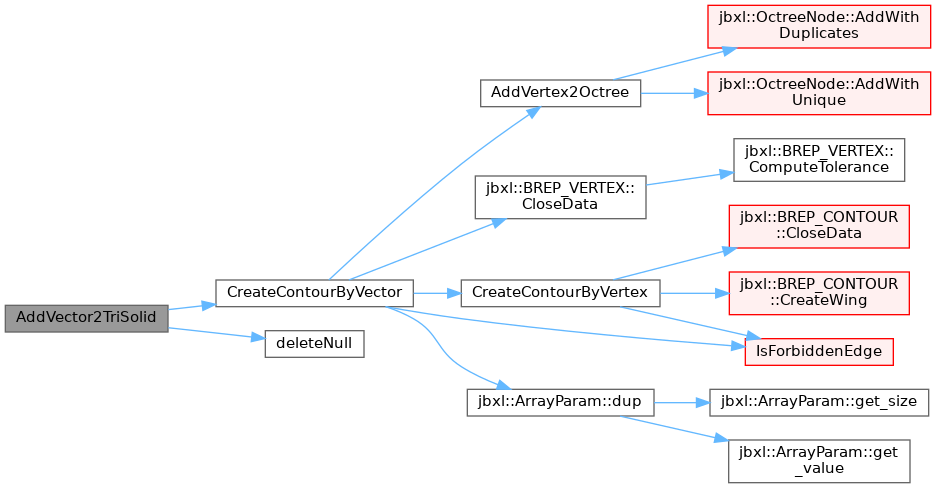
◆ AddVertex2Octree()
| DllExport BREP_VERTEX * AddVertex2Octree | ( | BREP_VERTEX * | vert, |
| OctreeNode * | octree, | ||
| bool | dupli = false ) |
BREP_VERTEX* jbxl::AddVertex2Octree(BREP_VERTEX* vert, OctreeNode* octree, bool dupli)
Vertex vert を octreeに登録する.
dupli がfalseの場合:
既に同じ位置に Vertexが登録されている場合(UVマップも比べる)は,vertは消去されて,既に登録されている Vertexが返される.
この関数を使用後は vertを使用してはいけない(deleteされている可能性があるので)
dupli が trueの場合:
既に同じ位置に Vertexが登録されていても,重複して登録する.
- Parameters
-
vert 登録する頂点データ octree 頂点データを格納するオクトツリー dupli true: 頂点の重複登録を許可する.false: 重複登録を許可しない.
- Returns
- オクトツリー中の頂点データ
- 使用例
- vert = AddVertex2Octree(vert, octree, false);DllExport BREP_VERTEX * AddVertex2Octree(BREP_VERTEX *vertex, OctreeNode *octree, bool dupli=false)Definition Brep.cpp:971
Definition at line 971 of file Brep.cpp.
References OctreeNode::AddWithDuplicates(), OctreeNode::AddWithUnique(), OctreeNode::solid, OctreeNode::vertex, and BREP_SOLID::vertexno.
Referenced by CreateContourByVector().


◆ ARGB2Int()
|
inline |
Definition at line 1000 of file Gdata.h.
References isBigEndian.
◆ ARGB2Word()
Definition at line 1025 of file Gdata.h.
References isBigEndian.
◆ BSplineInterp4()
|
inline |
4階(3次)Bスプライン曲線補間. 2次の導関数が両端で 0の条件有り.
P(t) = 1/6*(1-t)^3*Q0 + (1/2*t^3 - t^2 + 2/3)*Q1 + (-1/2*t^3 + 1/2*t^2 + 1/2*t + 1/6)*Q2 + 1/6*t^3*Q3 Q0 = 2*P(0) - P(1); Q1 = P(0) Q2 = P(1) Q3 = 2*P(1) - P(0)
Definition at line 334 of file Vector.h.
◆ Cast() [1/3]
Definition at line 622 of file Vector.h.
References UVMap< T >::d, UVMap< T >::u, and UVMap< T >::v.
◆ Cast() [2/3]
Definition at line 781 of file Vector.h.
References Vector4< T >::c, Vector4< T >::d, Vector4< T >::n, Vector4< T >::t, Vector4< T >::x, Vector4< T >::y, and Vector4< T >::z.
◆ Cast() [3/3]
Definition at line 126 of file Vector.h.
References Vector< T >::c, Vector< T >::d, Vector< T >::n, Vector< T >::x, Vector< T >::y, and Vector< T >::z.
◆ cat_MSGraph() [1/2]
template <typename T, typename R> void cat_MSGraph(MSGraph<R>* src, MSGraph<T>* dst)
MSGraph<R>型データのバッファ部を MSGraph<T>型のバッファ部へ上書き(追加)する.
位置,サイズは自動調整される.
- Parameters
-
src コピー元グラフィックデータ dst コピー先グラフィックデータ
Definition at line 475 of file Graph.h.
References MSGraph< T >::base, MSGraph< T >::free(), MSGraph< T >::gp, Max, MSGraph< T >::max, Min, MSGraph< T >::min, MSGraph< T >::rbound, MSGraph< T >::RZxy, MSGraph< T >::set(), RBound< T >::xmax, RBound< T >::xmin, MSGraph< T >::xs, RBound< T >::ymax, RBound< T >::ymin, MSGraph< T >::ys, MSGraph< T >::zero, RBound< T >::zmax, RBound< T >::zmin, and MSGraph< T >::zs.

◆ cat_MSGraph() [2/2]
template <typename T, typename R> void cat_MSGraph(MSGraph<R> src, MSGraph<T>& dst)
MSGraph<R>型データのバッファ部を MSGraph<T>型のバッファ部へ上書き(追加)する.
位置,サイズは自動調整される.
- Parameters
-
src コピー元グラフィックデータ dst コピー先グラフィックデータ
Definition at line 421 of file Graph.h.
References MSGraph< T >::base, MSGraph< T >::free(), MSGraph< T >::gp, Max, MSGraph< T >::max, Min, MSGraph< T >::min, MSGraph< T >::rbound, MSGraph< T >::RZxy, MSGraph< T >::set(), RBound< T >::xmax, RBound< T >::xmin, MSGraph< T >::xs, RBound< T >::ymax, RBound< T >::ymin, MSGraph< T >::ys, MSGraph< T >::zero, RBound< T >::zmax, RBound< T >::zmin, and MSGraph< T >::zs.

◆ CenterLine()
◆ centerLine()
template <typename T> MSGraph<T> centerLine(MSGraph<T> gx, int mode)
3D画像に対して,連結数に基づいた細線化を行う.
- Parameters
-
gx 3D画像. mode 26: 26近傍,その他: 6近傍
- Returns
- 細線化された画像データ.
- See also
- 信学論D-II, Vol.J79-D-II, pp.1675-1685, 1996.
Definition at line 41 of file Thinning.h.
References add_tList_node_bydata(), del_tList_node(), deletable(), euclidDistance(), MSGraph< T >::free(), MSGraph< T >::gp, init_tList_data(), Max, Min, new_tList_node(), nonZeroBoxel(), SINTMAX, MSGraph< T >::xs, MSGraph< T >::ys, MSGraph< T >::zero, and MSGraph< T >::zs.
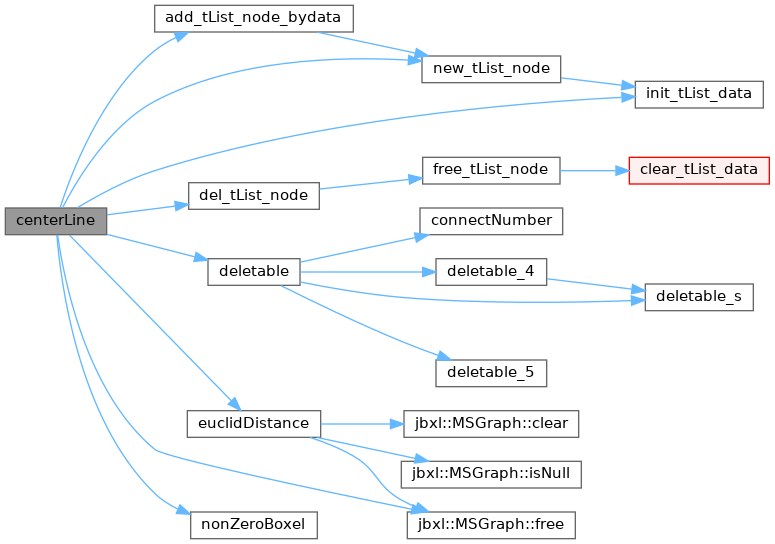
◆ ClearGlobalCounter()
|
inline |
◆ ClearGlobalDisplay()
|
inline |
◆ ClearGlobalFrame()
|
inline |
◆ ClearGlobalTextDocument()
|
inline |
Definition at line 122 of file ClassBox.h.
References GLTextDocument.
◆ CloseTriSolid()
| DllExport int CloseTriSolid | ( | BREP_SOLID * | solid, |
| bool | check = true, | ||
| CVCounter * | counter = NULL ) |
int jbxl::CloseTriSolid(BREP_SOLID* solid, bool check, CVCounter* counter)
AddVector2TriSolid() の最後に呼んで,データをクローズする. BREP_SOLIDに使用された有効なファセットの数を返す.
- Parameters
-
solid ソリッドデータへのポインタ check データのエラーチェックを行うか? 行う場合,不正データは削除される. counter 仮想カウンタ.
- Return values
-
-1 ソリッドがNULL
Definition at line 1459 of file TriBrep.cpp.
References BREP_SOLID::CloseData(), BREP_SOLID::contours, CreateContoursList(), CreateShortageWingsList(), CreateSurplusContoursList(), CreateWingsList(), CVCounter::DeleteChildCounter(), DeleteStraightEdges(), DeleteSurplusContours(), CVCounter::MakeChildCounter(), and BREP_SOLID::vcount.
Referenced by BrepSolidList::addSolid(), CreateTriSolidFromSTL(), CreateTriSolidFromVector(), and BrepSolidList::getMerge().
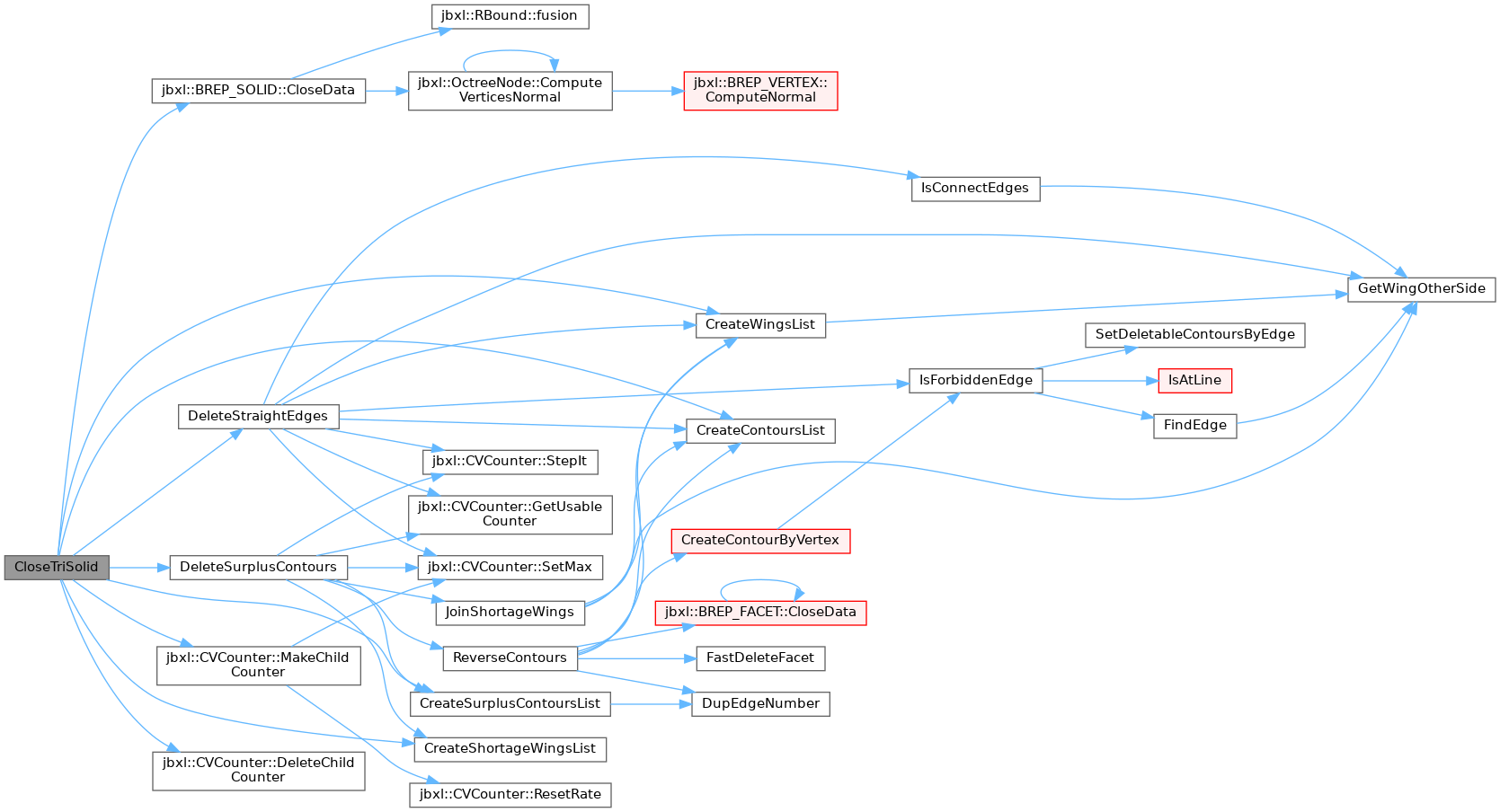

◆ CmnHeadBytePoint()
Definition at line 36 of file Gdata.h.
References CmnHead::grptr, CmnHead::xsize, and CmnHead::ysize.
◆ CollisionTriContour2D()
| DllExport bool CollisionTriContour2D | ( | BREP_CONTOUR * | contour1, |
| BREP_CONTOUR * | contour2 ) |
Definition at line 1053 of file TriBrep.cpp.
References Collision_Tolerance, BREP_CONTOUR::directR, BREP_CONTOUR::directRS, BREP_CONTOUR::directS, Max, Vector< T >::n, BREP_WING::next, Vector< T >::norm(), ProportionVector(), TVector< T >::t, TVectorMultiTolerance(), BREP_WING::vertex, Vertex2TVector(), BREP_CONTOUR::wing, Xabs, and Zero_Eps.
Referenced by IsCollisionContours().
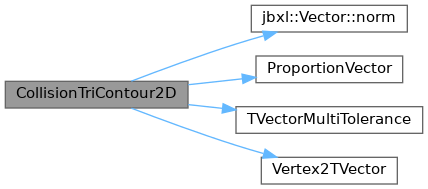

◆ CollisionTriContour3D()
| DllExport bool CollisionTriContour3D | ( | BREP_CONTOUR * | contour1, |
| BREP_CONTOUR * | contour2 ) |
bool jbxl::CollisionTriContour3D(BREP_CONTOUR* contour1, BREP_CONTOUR* contour2)
contour1と contour2が衝突しているかどうかをチェックする.
contour2->directRS, directR, directS が予め計算されていなければならない.→例えば ComputeDirectRS() を使用
Definition at line 991 of file TriBrep.cpp.
References Collision_Tolerance, BREP_CONTOUR::directR, BREP_CONTOUR::directRS, BREP_CONTOUR::directS, Max, Vector< T >::n, BREP_WING::next, TVector< T >::t, TVectorMultiTolerance(), BREP_WING::vertex, Vertex2TVector(), BREP_CONTOUR::wing, Xabs, and Zero_Eps.
Referenced by IsCollisionContours().


◆ CommonVertex()
| DllExport int CommonVertex | ( | BREP_CONTOUR * | contour1, |
| BREP_CONTOUR * | contour2 ) |
Definition at line 1191 of file TriBrep.cpp.
References BREP_WING::next, BREP_WING::vertex, and BREP_CONTOUR::wing.
Referenced by IsCollisionContours().

◆ CompareVertex()
| DllExport int CompareVertex | ( | BREP_VERTEX * | v1, |
| BREP_VERTEX * | v2 ) |
int jbxl::CompareVertex(BREP_VERTEX* v1, BREP_VERTEX* v2)
v2 に対する v1 の位置を検査する.
- Return values
-
0〜7 Vertex の位置 8 同じVertex
Definition at line 1007 of file Brep.cpp.
References BREP_VERTEX::point, BREP_VERTEX::tolerance, Vector< T >::x, Vector< T >::y, and Vector< T >::z.
Referenced by OctreeNode::AddWithDuplicates(), OctreeNode::AddWithUnique(), and OctreeNode::FindSubtree().

◆ connectNumber()
| int connectNumber | ( | int * | w, |
| int | c, | ||
| int | d ) |
int jbxl::connectNumber(int* w, int c, int d)
連結数の計算
- Parameters
-
w w[] 近傍の連結数 c 近傍数 d 次元数
- Returns
- 連結数
Definition at line 26 of file Thinning.cpp.
Referenced by deletable().

◆ ConnectWingToVertex()
void jbxl::ConnectWingToVertex(BREP_WING* wing)
WingのスタートVertexのリングに,この Wingを登録する.
Wingが実在する(使用されている)ためには,このリングに登録されてることと,Contourから(へ) リンクされることである.
Definition at line 802 of file Brep.cpp.
References BREP_WING::vertex.
◆ copy_morph_element()
| void copy_morph_element | ( | MSGraph< T > | vp, |
| int | x, | ||
| int | y, | ||
| int | z, | ||
| MSGraph< T > | xp ) |
template <typename T> void copy_morph_element(MSGraph<T> vp, int x, int y, int z, MSGraph<T> xp)
エレメントを対象画像にコピーする.
Definition at line 140 of file Morph.h.
References MSGraph< T >::gp, MSGraph< T >::xs, MSGraph< T >::ys, and MSGraph< T >::zs.
Referenced by fat_object_morph(), and opening_morph().

◆ copy_MSGraph() [1/2]
template <typename R, typename T> void copy_MSGraph(MSGraph<R>* src, MSGraph<T>* dst)
MSGraph<R>型データのバッファ部を MSGraph<T>型のバッファ部へコピーする.
dstのデータ部がある場合は破棄される.
- Parameters
-
src コピー元グラフィックデータ dst コピー先グラフィックデータ
Definition at line 566 of file Graph.h.
References MSGraph< T >::base, MSGraph< T >::color, MSGraph< T >::free(), MSGraph< T >::getm(), MSGraph< T >::gp, JBXL_GRAPH_MEMORY_ERROR, MSGraph< T >::max, MSGraph< T >::min, MSGraph< T >::state, MSGraph< T >::xs, MSGraph< T >::ys, MSGraph< T >::zero, and MSGraph< T >::zs.

◆ copy_MSGraph() [2/2]
template <typename R, typename T> void copy_MSGraph(MSGraph<R> src, MSGraph<T>& dst)
MSGraph<R>型データのバッファ部を MSGraph<T>型のバッファ部へコピーする.
dstのデータ部がある場合は破棄される.
- Parameters
-
src コピー元グラフィックデータ dst コピー先グラフィックデータ
Definition at line 530 of file Graph.h.
References MSGraph< T >::base, MSGraph< T >::color, MSGraph< T >::free(), MSGraph< T >::getm(), MSGraph< T >::gp, JBXL_GRAPH_MEMORY_ERROR, MSGraph< T >::max, MSGraph< T >::min, MSGraph< T >::state, MSGraph< T >::xs, MSGraph< T >::ys, MSGraph< T >::zero, and MSGraph< T >::zs.

◆ copyCmnHead2MSGraph()
| MSGraph< T > copyCmnHead2MSGraph | ( | CmnHead | hd, |
| unsigned int | mode = CH2MG_NORMAL, | ||
| bool | cnt = false ) |
template <typename T> MSGraph<T> copyCmnHead2MSGraph(CmnHead hd, unsigned int mode=CH2MG_NORMAL, bool cnt=false)
CmnHead から MSGraph<T>のデータを作り出す.
MSGraph<T>.gp のメモリ領域は別に作られる.グローバルカウンタが使用可能.
- Parameters
-
hd 共通ヘッダ mode CH2MG_NORMAL (0) ノーマルコピー(デフォルト)
CH2MG_NORZXY (1) Z軸の歪を処理しない.cnt カウンタを使用するか(デフォルト:使用しない false)
- Returns
- 画像データ.エラーの場合は,stateメンバに値が設定される.
- Return values
-
JBXL_GRAPH_HEADER_ERROR state ヘッダエラー JBXL_GRAPH_MEMORY_ERROR state メモリ確保エラー JBXL_GRAPH_CANCEL state ユーザによる中断
Definition at line 651 of file Gdata.h.
References MSGraph< T >::base, CmnHead::bsize, CmnHead::buf, CH2MG_NOPARM, checkBit, MSGraph< T >::color, CT_3D_VOL, CT_3DM, CT_DATA, CmnHead::depth, MSGraph< T >::free(), GetUsableGlobalCounter(), MSGraph< T >::gp, GRAPH_COLOR_MONO16, GRAPH_COLOR_RGB, CmnHead::grptr, HAS_BASE, HAS_RBOUND, HAS_RZXY, HEADER_NONE, MSGraph< T >::init(), CVCounter::isCanceled(), JBXL_GRAPH_CANCEL, JBXL_GRAPH_HEADER_ERROR, JBXL_GRAPH_MEMORY_ERROR, JPEG_MONO_DATA, JPEG_RGB_DATA, CmnHead::kind, Max, MSGraph< T >::max, Min, MSGraph< T >::min, CVCounter::PutFill(), MSGraph< T >::rbound, MSGraph< T >::RZxy, RZXY_RATE, MSGraph< T >::set(), CVCounter::SetMax(), MSGraph< T >::state, CVCounter::StepIt(), UN_KNOWN_DATA, RBound< T >::xmax, RBound< T >::xmin, MSGraph< T >::xs, CmnHead::xsize, RBound< T >::ymax, RBound< T >::ymin, MSGraph< T >::ys, CmnHead::ysize, RBound< T >::zmax, RBound< T >::zmin, MSGraph< T >::zs, and CmnHead::zsize.
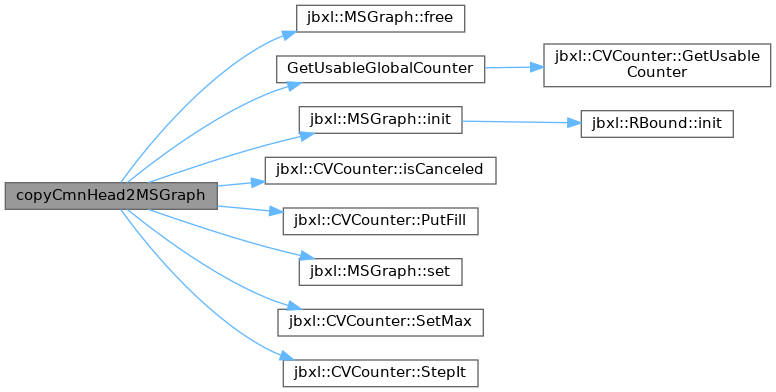
◆ copyMSGraph2CmnHead()
| CmnHead copyMSGraph2CmnHead | ( | MSGraph< T > & | vp, |
| unsigned int | mode = MG2CH_NORMAL, | ||
| bool | cnt = false ) |
template <typename T> CmnHead copyMSGraph2CmnHead(MSGraph<T>& vp, unsigned int mode=MG2CH_NORMAL, bool cnt=false)
MSGraph<T> から CmnHeadのデータを作り出す.
CmnHead.grptr のメモリ領域は別に作られる.vpに関しては vp.max, vp.minが設定される.
グローバルカウンタが使用可能.
- Parameters
-
vp コピー元のグラフィックデータ mode MG2CH_NORMAL (0) ノーマルコピー(デフォルト)
MG2CH_NORZXY (1) Z軸の歪を処理しない.
MG2CH_CONTRAST (2) コントラスト調整
MG2CH_OCTET (4) 8bitへ変換
cnt カウンタを使用するか(デフォルト:使用しない false)
- Returns
- 共通ヘッダ.エラーの場合は kind が HEADER_NONE になり,xsizeに値が設定される.
- Return values
-
HEADER_NONE kind エラー JBXL_GRAPH_HEADER_ERROR xsize ヘッダエラー JBXL_GRAPH_MEMORY_ERROR xsize メモリ確保エラー JBXL_GRAPH_CANCEL xsize ユーザによる中断
Definition at line 805 of file Gdata.h.
References MSGraph< T >::base, CmnHead::bsize, CmnHead::buf, checkBit, CTHead::cutdown, CTHead::cutright, CmnHead::depth, free_CmnHead(), GetUsableGlobalCounter(), MSGraph< T >::gp, CmnHead::grptr, HAS_BASE, HAS_RBOUND, HAS_RZXY, HEADER_NONE, CVCounter::isCanceled(), JBXL_GRAPH_CANCEL, JBXL_GRAPH_HEADER_ERROR, JBXL_GRAPH_MEMORY_ERROR, CmnHead::kind, CmnHead::lsize, Max, MSGraph< T >::max, MG2CH_CONTRAST, MG2CH_NOPARM, MG2CH_NORMAL, MG2CH_OCTET, Min, MSGraph< T >::min, CVCounter::PutFill(), MSGraph< T >::rbound, MSGraph< T >::RZxy, RZXY_RATE, CVCounter::SetMax(), CVCounter::StepIt(), RBound< T >::xmax, RBound< T >::xmin, MSGraph< T >::xs, CTHead::xsize, CmnHead::xsize, RBound< T >::ymax, RBound< T >::ymin, MSGraph< T >::ys, CTHead::ysize, CmnHead::ysize, RBound< T >::zmax, RBound< T >::zmin, MSGraph< T >::zs, and CmnHead::zsize.
Referenced by readGraphicSlices(), and writeRasFile().
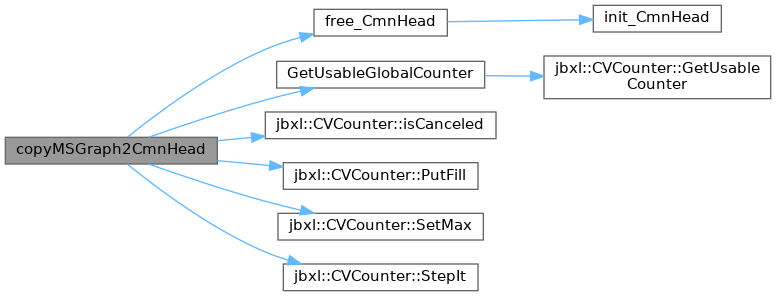

◆ copyMSGraph2CvMat()
| cv::Mat copyMSGraph2CvMat | ( | MSGraph< T > * | vp | ) |
template <typename R, typename T> cv::Mat copyMSGraph2CvMat(MSGraph<T>* vp)
MSGraph<T> vp から OpenCV用の Matデータ(型R)を作り出す.
型 T, R の整合性は呼び出し側の責任. 現在は T->R で単純にキャスト可能な場合にしか対応していない.
vp.color による Matの構成は今後....
- Parameters
-
vp 元のグラフィックデータ
- Returns
- OpenCV のMatデータ
Definition at line 114 of file OpenCVTool.h.
References MSGraph< T >::gp, MSGraph< T >::xs, MSGraph< T >::ys, and MSGraph< T >::zs.
◆ count_area_MSGraph()
| int count_area_MSGraph | ( | MSGraph< T > | xp | ) |
template <typename T> int count_area_MSGraph(MSGraph<T> xp)
面積を測る.
Definition at line 223 of file Graph.h.
References MSGraph< T >::gp, MSGraph< T >::xs, MSGraph< T >::ys, MSGraph< T >::zero, and MSGraph< T >::zs.
Referenced by dgree_circle_MSGraph().

◆ count_around_MSGraph()
| double count_around_MSGraph | ( | MSGraph< T > | vp | ) |
Definition at line 180 of file Graph.h.
References MSGraph< T >::free(), MSGraph< T >::isNull(), OFF, MSGraph< T >::point(), MSGraph< T >::xs, MSGraph< T >::ys, MSGraph< T >::zero, and zoom_MSGraph().
Referenced by dgree_circle_MSGraph().


◆ count_object_MSGraph()
| int count_object_MSGraph | ( | MSGraph< T > | xp, |
| int | mn, | ||
| int | mx ) |
Definition at line 234 of file Graph.h.
References MSGraph< T >::free(), MSGraph< T >::gp, MSGraph< T >::mimicry(), MSGraph_Paint(), MSGraph< T >::xs, MSGraph< T >::ys, MSGraph< T >::zero, and MSGraph< T >::zs.

◆ CreateContourByVector()
| DllExport BREP_CONTOUR * CreateContourByVector | ( | BREP_FACET * | facet, |
| Vector< double > * | vect, | ||
| Vector< double > * | nrml = NULL, | ||
| UVMap< double > * | uvmp = NULL, | ||
| ArrayParam< int > * | wght = NULL, | ||
| bool | dupli = false ) |
Facet と Vector[] から Contour を作る.
vect[0]〜vect[2] は3点の位置ベクトル(順序付けされている) nrml[0]〜nrml[2] は3点の法線ベクトル(NULL なら再計算される) uvmp[0]〜uvmp[2] は3点の曲面座標データ.
- Parameters
-
facet FACETデータへのポインタ vect 3個の頂点データ vect[3] へのポインタ nrml 頂点の法線ベクトルデータへのポインタ. uvmp 頂点の曲面座標データへのポインタ. wght 頂点の重みデータへのポインタ. dupli true: 頂点の重複登録を許可する.false: 重複登録を許可しない.
Definition at line 684 of file TriBrep.cpp.
References AddVertex2Octree(), BREP_VERTEX, BREP_VERTEX::calc_normal, BREP_VERTEX::CloseData(), CreateContourByVertex(), ArrayParam< T >::dup(), IsForbiddenEdge(), BREP_VERTEX::normal, BREP_SOLID::octree, BREP_VERTEX::point, BREP_FACET::shell, BREP_SHELL::solid, BREP_VERTEX::uvmap, and BREP_VERTEX::weight.
Referenced by BrepSolidList::addSolid(), AddVector2TriSolid(), CreateTriSolidFromSTL(), CreateTriSolidFromVector(), and BrepSolidList::getMerge().


◆ CreateContourByVertex()
| DllExport BREP_CONTOUR * CreateContourByVertex | ( | BREP_FACET * | facet, |
| BREP_VERTEX ** | vertex ) |
BREP_CONTOUR* jbxl::CreateContourByVertex(BREP_FACET* facet, BREP_VERTEX** vertex)
Facet と Vertex[3] から Vertex を作る. vertex[0]〜vertex[2] は 3点の Vertex(順序付けされている)
Definition at line 735 of file TriBrep.cpp.
References BREP_CONTOUR, BREP_CONTOUR::CloseData(), BREP_CONTOUR::CreateWing(), and IsForbiddenEdge().
Referenced by CreateContourByVector(), PatchupContour(), and ReverseContours().
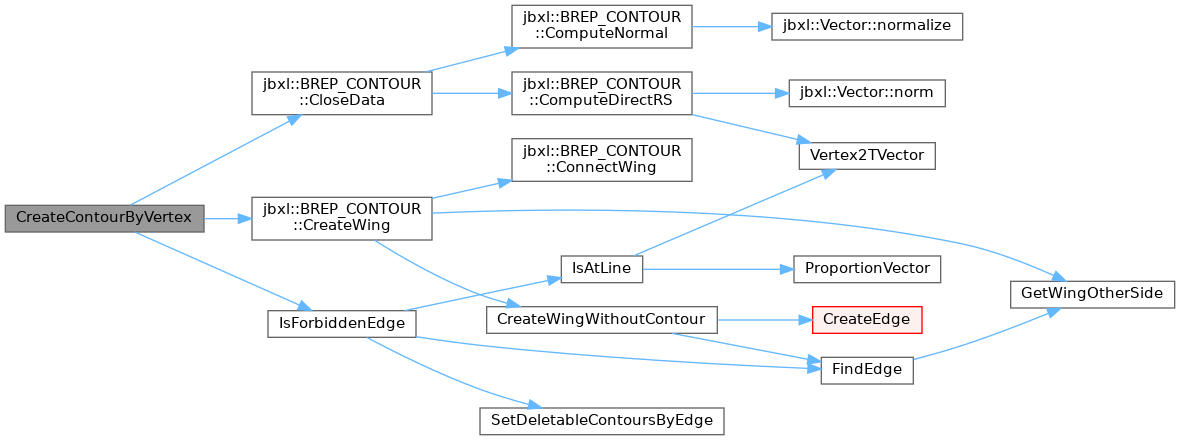

◆ CreateContoursList()
| DllExport void CreateContoursList | ( | BREP_SOLID * | solid | ) |
void jbxl:: CreateContoursList(BREP_SOLID* solid)
削除マークの付いたContour(Facet)を削除し,全Contour(Facet)の Listを作る.
ただし,読み込み(初期)データは削除しない.
Definition at line 22 of file TriBrep.cpp.
References BREP_SOLID::contours, BREP_SOLID::facetno, BREP_FACET::shell, and BREP_SOLID::shells.
Referenced by CloseTriSolid(), DeleteShortageWings(), DeleteStraightEdges(), FillShortageWings_Near(), FillShortageWings_Next(), JoinShortageWings(), and ReverseContours().

◆ CreateEdge()
| DllExport BREP_EDGE * CreateEdge | ( | BREP_VERTEX * | v1, |
| BREP_VERTEX * | v2 ) |
Definition at line 988 of file Brep.cpp.
References BREP_EDGE, and BREP_EDGE::CloseData().
Referenced by CreateWingWithoutContour().


◆ CreateShortageWingsList()
| DllExport void CreateShortageWingsList | ( | BREP_SOLID * | solid | ) |
void jbxl::CreateShortageWingsList(BREP_SOLID* solid)
不完全な Wingの Listを作る.WingsListを利用する.
CreateContoursList(), CreateWingsList()に依存する.
Definition at line 105 of file TriBrep.cpp.
References BREP_SOLID::shortage_wings, and BREP_SOLID::wings.
Referenced by CloseTriSolid(), DeleteSurplusContours(), and FillShortageWings().

◆ CreateSurplusContoursList()
| DllExport void CreateSurplusContoursList | ( | BREP_SOLID * | solid | ) |
void jbxl::CreateSurplusContoursList(BREP_SOLID* solid)
多重Edgeを持つ Contourの Listを作る.
CreateContoursList()に依存する.
Definition at line 84 of file TriBrep.cpp.
References BREP_SOLID::contours, DupEdgeNumber(), and BREP_SOLID::surplus_contours.
Referenced by CloseTriSolid(), and DeleteSurplusContours().


◆ CreateTriSolidFromSTL()
| DllExport int CreateTriSolidFromSTL | ( | BREP_SOLID * | solid, |
| STLData * | stldata, | ||
| int | fno, | ||
| bool | check = true ) |
int jbxl::CreateTriSolidFromSTL(BREP_SOLID* solid, STLData* stldata, int fno, bool check)
STLDataから BREP_SOLIDを生成する.BREP_SOLIDに使用された有効なファセットの数を返す.
STLData中の法線ベクトルは無視して再計算する.
カウンタ使用可能.
- Parameters
-
solid ソリッドデータへのポインタ stldata STLデータへのポインタ fno Facet(STLデータ)の数 check データの不正検査を行うか?
- Return values
-
-1 ソリッドがNULL,stldataがNULL またはソリッドの Octreeが NULL -3 操作がキャンセルされた.
Definition at line 1230 of file TriBrep.cpp.
References BREP_FACET, BREP_SHELL, CloseTriSolid(), BREP_SOLID::contours, BREP_SOLID::counter, CreateContourByVector(), deleteNull(), CVCounter::GetUsableCounter(), CVCounter::isCanceled(), Max, BREP_SOLID::octree, CVCounter::PutFill(), CVCounter::ResetRate(), CVCounter::SetMax(), CVCounter::StepIt(), STLData::vect, Vector< T >::x, Vector< T >::y, and Vector< T >::z.
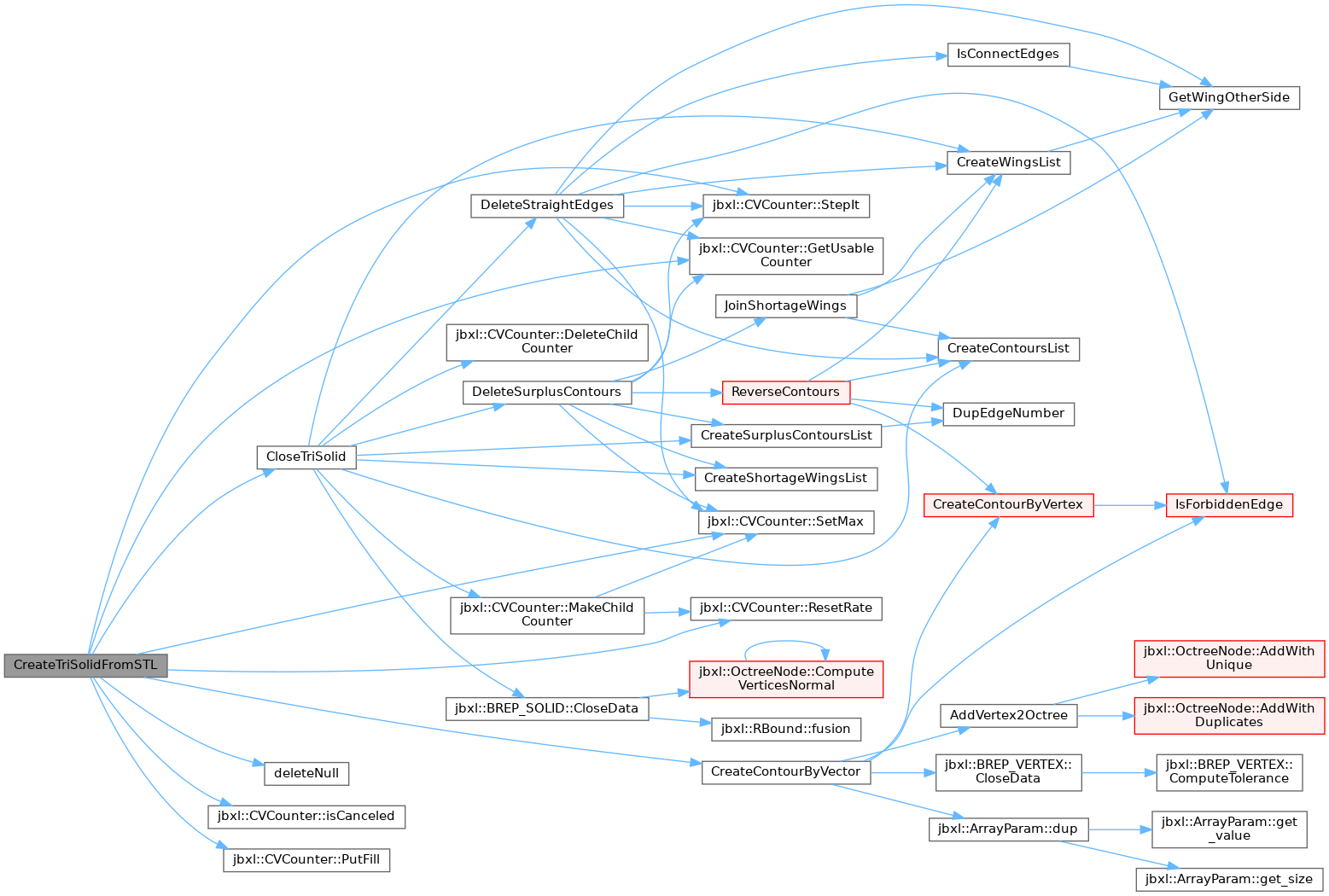
◆ CreateTriSolidFromVector()
| DllExport int CreateTriSolidFromVector | ( | BREP_SOLID * | solid, |
| int | vno, | ||
| Vector< double > * | vect, | ||
| Vector< double > * | nrml = NULL, | ||
| UVMap< double > * | uvmp = NULL, | ||
| ArrayParam< int > * | wght = NULL, | ||
| bool | dupli = false, | ||
| bool | check = true ) |
Vector<double>から BREP_SOLIDを生成する.BREP_SOLIDに使用された有効なファセットの数を返す.
カウンタ使用可能.
- Parameters
-
solid ソリッドデータへのポインタ vno 頂点データの数 vect 頂点の座標データへのポインタ. nrml 頂点の法線ベクトルデータへのポインタ. uvmp 頂点の曲面座標データへのポインタ. wght 頂点の重みデータへのポインタ. dupli true: 頂点の重複登録を許可する.false: 重複登録を許可しない. check データの不正検査を行うか?
- Return values
-
-1 ソリッドがNULL,stldataがNULL またはソリッドの Octreeが NULL -3 操作がキャンセルされた.
Definition at line 1321 of file TriBrep.cpp.
References BREP_FACET, BREP_SHELL, CloseTriSolid(), BREP_SOLID::contours, BREP_SOLID::counter, CreateContourByVector(), deleteNull(), CVCounter::GetUsableCounter(), CVCounter::isCanceled(), Max, BREP_SOLID::octree, CVCounter::PutFill(), CVCounter::ResetRate(), CVCounter::SetMax(), and CVCounter::StepIt().
Referenced by MeshFacetNode::computeVertexByBREP(), and MeshFacetNode::computeVertexByBREP().
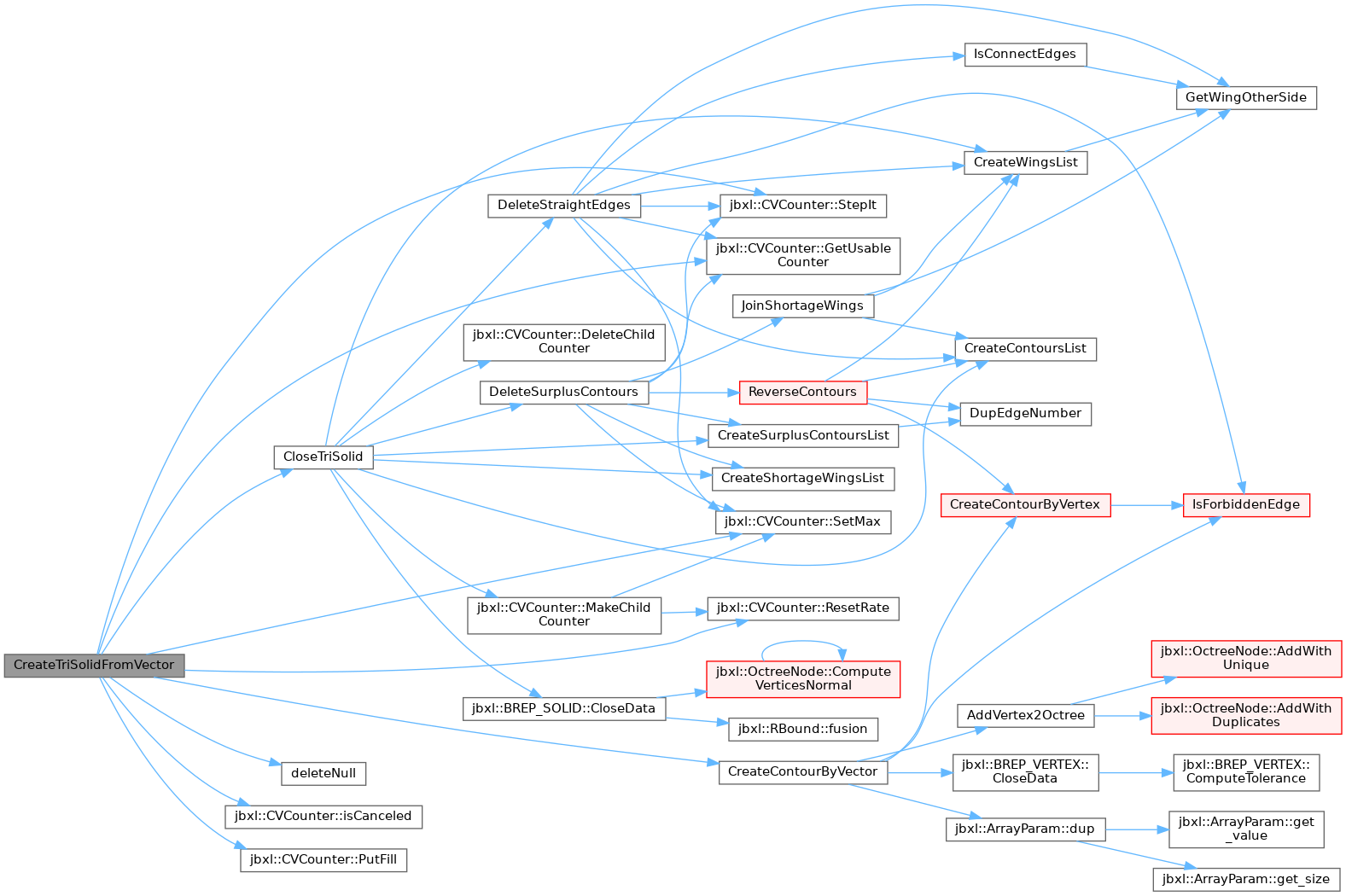

◆ CreateWingsList()
| DllExport void CreateWingsList | ( | BREP_SOLID * | solid | ) |
void jbxl::CreateWingsList(BREP_SOLID* solid)
全 Wingの Listを作る.(Contourに結び付けられていないものも含む)
CreateContoursList()に依存する.
Definition at line 58 of file TriBrep.cpp.
References BREP_EDGE::complete, BREP_SOLID::contours, BREP_WING::edge, GetWingOtherSide(), BREP_WING::next, and BREP_SOLID::wings.
Referenced by CloseTriSolid(), DeleteShortageWings(), DeleteStraightEdges(), FillShortageWings_Near(), FillShortageWings_Next(), JoinShortageWings(), and ReverseContours().


◆ CreateWingWithoutContour()
| DllExport BREP_WING * CreateWingWithoutContour | ( | BREP_VERTEX * | vertex1, |
| BREP_VERTEX * | vertex2 ) |
BREP_WING* jbxl::CreateWingWithoutContour(BREP_VERTEX* vertex1, BREP_VERTEX* vertex2)
vertex1をスタートVertexとしたWingを(必要ならEdgeも)作成して返す.
Wingが作成された時点では,WingはContourには関連付けられていない.
Definition at line 817 of file Brep.cpp.
References BREP_WING::contour, CreateEdge(), BREP_EDGE::edge_list, FindEdge(), BREP_WING::vertex, BREP_EDGE::wing1, and BREP_EDGE::wing2.
Referenced by BREP_CONTOUR::CreateWing().


◆ cut_object_MSGraph() [1/3]
| MSGraph< T > cut_object_MSGraph | ( | MSGraph< T > | vp, |
| int | mn, | ||
| int | mx, | ||
| int | blank = BOUNDARY_BLANK, | ||
| bool | ecnt = false ) |
template <typename T> MSGraph<T> cut_object_MSGraph(MSGraph<T> vp, int mn, int mx, int blank=BOUNDARY_BLANK, bool ecnt=false)
グラフィックデータから mn〜mx の輝度値を持つ部分を抜き出す.
- Parameters
-
vp 操作対象となるグラフィックデータ構造体. mn 抜き出す画像の輝度値の最小値. mx 抜き出す画像の輝度値の最大値. blank 境界の余白.あそび. ecnt カウンタを使用するかどうか.デフォルトは false
- Returns
- 抜き出されたグラフィックデータ.rboundメンバに境界情報が入る.
Definition at line 1435 of file Graph.h.
References MSGraph< T >::base, MSGraph< T >::color, RBound< T >::commonarea(), RBound< T >::cutdown(), RBound< T >::enlarge(), RBound< T >::fusion(), GetUsableGlobalCounter(), MSGraph< T >::gp, MSGraph< T >::init(), CVCounter::isCanceled(), MSGraph< T >::isNull(), JBXL_GRAPH_CANCEL, JBXL_GRAPH_MEMORY_ERROR, JBXL_GRAPH_NODATA_ERROR, Max, MSGraph< T >::max, Min, MSGraph< T >::min, MSGraph< T >::rbound, MSGraph< T >::RZxy, MSGraph< T >::set(), CVCounter::SetMax(), MSGraph< T >::state, CVCounter::StepIt(), RBound< T >::xmax, RBound< T >::xmin, MSGraph< T >::xs, RBound< T >::ymax, RBound< T >::ymin, MSGraph< T >::ys, MSGraph< T >::zero, RBound< T >::zmax, RBound< T >::zmin, and MSGraph< T >::zs.
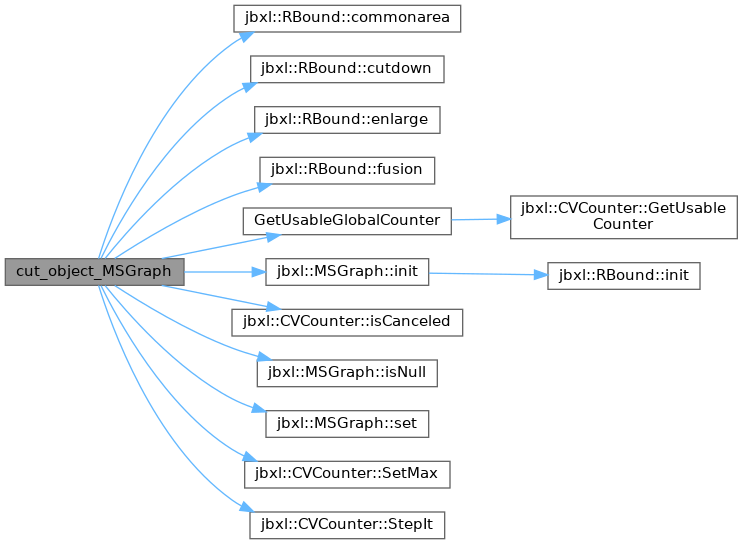
◆ cut_object_MSGraph() [2/3]
| MSGraph< T > cut_object_MSGraph | ( | MSGraph< T > | vp, |
| int | mn, | ||
| int | mx, | ||
| RBound< int > | rbound, | ||
| int | blank = BOUNDARY_BLANK, | ||
| bool | ecnt = false ) |
template <typename T> MSGraph<T> cut_object_MSGraph(MSGraph<T> vp, int mn, int mx, RBound<int> rbound, int blank=BOUNDARY_BLANK, bool ecnt=false)
グラフィックデータから rboundの範囲で mn〜mx の輝度値を持つ部分を抜き出す.
- Parameters
-
vp 操作対象となるグラフィックデータ構造体. mn 抜き出す画像の輝度値の最小値. mx 抜き出す画像の輝度値の最大値. rbound 切り抜き対象の範囲 blank 境界の余白.余裕. ecnt カウンタを使用するかどうか.デフォルトは false
- Returns
- 抜き出されたグラフィックデータ.rboundメンバに境界情報が入る.
Definition at line 1547 of file Graph.h.
References MSGraph< T >::base, MSGraph< T >::color, RBound< T >::commonarea(), RBound< T >::cutdown(), RBound< T >::enlarge(), RBound< T >::fusion(), GetUsableGlobalCounter(), MSGraph< T >::gp, MSGraph< T >::init(), CVCounter::isCanceled(), MSGraph< T >::isNull(), JBXL_GRAPH_CANCEL, JBXL_GRAPH_MEMORY_ERROR, JBXL_GRAPH_NODATA_ERROR, Max, MSGraph< T >::max, Min, MSGraph< T >::min, MSGraph< T >::rbound, MSGraph< T >::RZxy, MSGraph< T >::set(), CVCounter::SetMax(), MSGraph< T >::state, CVCounter::StepIt(), RBound< T >::xmax, RBound< T >::xmin, MSGraph< T >::xs, RBound< T >::ymax, RBound< T >::ymin, MSGraph< T >::ys, MSGraph< T >::zero, RBound< T >::zmax, RBound< T >::zmin, and MSGraph< T >::zs.
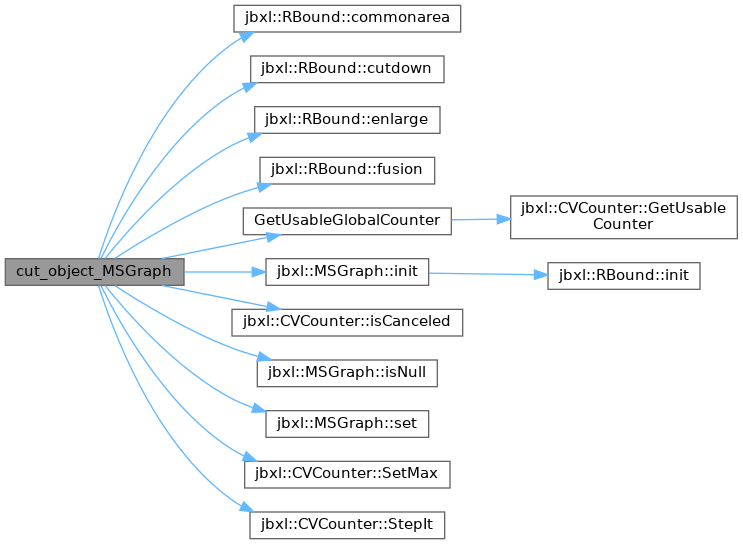
◆ cut_object_MSGraph() [3/3]
| MSGraph< T > cut_object_MSGraph | ( | MSGraph< T > | vp, |
| RBound< int > | rb, | ||
| bool | ecnt = false ) |
template <typename T> MSGraph<T> cut_object_MSGraph(MSGraph<T> vp, RBound<int> rb, bool ecnt=false)
グラフィックデータから rbound の範囲を抜き出す.
- Parameters
-
vp 操作対象となるグラフィックデータ構造体. rb 切り抜き対象の範囲 ecnt カウンタを使用するかどうか.デフォルトは false
- Returns
- 抜き出されたグラフィックデータ.rboundメンバに境界情報が入る.
Definition at line 1656 of file Graph.h.
References MSGraph< T >::base, MSGraph< T >::color, RBound< T >::commonarea(), RBound< T >::cutdown(), GetUsableGlobalCounter(), MSGraph< T >::gp, MSGraph< T >::init(), CVCounter::isCanceled(), MSGraph< T >::isNull(), JBXL_GRAPH_CANCEL, JBXL_GRAPH_MEMORY_ERROR, Max, MSGraph< T >::max, Min, MSGraph< T >::min, MSGraph< T >::rbound, MSGraph< T >::RZxy, MSGraph< T >::set(), CVCounter::SetMax(), MSGraph< T >::state, CVCounter::StepIt(), RBound< T >::xmax, RBound< T >::xmin, MSGraph< T >::xs, RBound< T >::ymax, RBound< T >::ymin, MSGraph< T >::ys, MSGraph< T >::zero, RBound< T >::zmax, RBound< T >::zmin, and MSGraph< T >::zs.
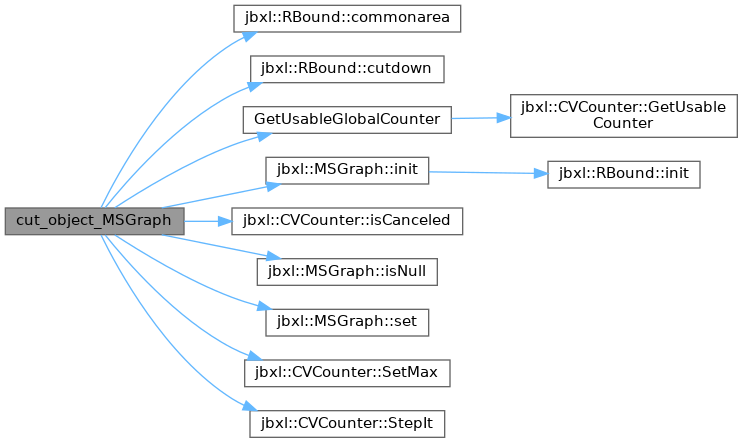
◆ cvDetectObjects()
| rectangle * cvDetectObjects | ( | cv::CascadeClassifier | cascade, |
| MSGraph< T > * | vp, | ||
| int & | num, | ||
| int | sz = 0, | ||
| double | scale = 1.0 ) |
- Parameters
-
cascade 識別エンジン vp 1plane(channel) MSGraphデータ(つまりモノクロ)へのポインタ [out] num 要素の数 sz 検出する最小のサイズ scale 縮小スケール
Definition at line 59 of file OpenCVTool.h.
◆ del_tList_object()
| void del_tList_object | ( | tList ** | lp | ) |
Definition at line 224 of file tools++.h.
References del_tList().

◆ deletable()
| bool deletable | ( | MSGraph< T > | vp, |
| int | n, | ||
| int | c, | ||
| int | d ) |
template <typename T> bool deletable(MSGraph<T> vp, int n, int c, int d)
n で示されるボクセルが削除可能かどうか判定する.
- Parameters
-
vp 画像データ n ボクセルのID c 近傍数 d 次元数
- Returns
- true 削除可能
- false 削除不能
Definition at line 268 of file Thinning.h.
References connectNumber(), DEBUG_MODE, deletable_4(), deletable_5(), deletable_s(), MSGraph< T >::gp, PRINT_MESG, MSGraph< T >::xs, and MSGraph< T >::ys.
Referenced by centerLine().
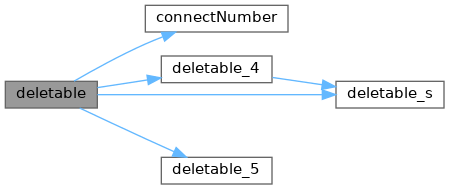

◆ deletable_4()
| bool deletable_4 | ( | int * | v | ) |
Definition at line 104 of file Thinning.cpp.
References deletable_s().
Referenced by deletable().


◆ deletable_5()
| bool deletable_5 | ( | int * | v | ) |
Definition at line 140 of file Thinning.cpp.
Referenced by deletable().

◆ deletable_s()
| bool deletable_s | ( | int * | v | ) |
Definition at line 86 of file Thinning.cpp.
Referenced by deletable(), and deletable_4().

◆ delete_noise_MSGraph()
| void delete_noise_MSGraph | ( | MSGraph< T > | vp, |
| int | size, | ||
| int | mode = 8, | ||
| int | work_color = 0 ) |
template <typename T> void delete_noise_MSGraph(MSGraph<T> vp, int size, int mode=8, int work_color=0)
背景(vp.zero)に浮かぶ孤立ノイズを除去する.
-work_color〜-1, work_color〜 を作業領域として使用するので,この区間にデータがある場合は誤作動する.
Definition at line 2437 of file Graph.h.
References addPaint_MSGraph(), MSGraph< T >::get_minmax(), MSGraph< T >::gp, MSGraph< T >::max, MSGraph< T >::xs, MSGraph< T >::ys, and MSGraph< T >::zero.

◆ deleteNull()
|
inline |
Definition at line 39 of file common++.h.
Referenced by BrepSolidList::addSolid(), AddVector2TriSolid(), CreateTriSolidFromSTL(), CreateTriSolidFromVector(), and BrepSolidList::getMerge().

◆ DeleteShortageWings()
| DllExport void DeleteShortageWings | ( | BREP_SOLID * | solid | ) |
void jbxl::DeleteShortageWings(BREP_SOLID* solid)
不完全 Wing(Edge)を持つFacet(Contour)を削除
Contours List と Wings Listの内容は保障される.
- 要求データ
- ShortageWings List.CreateShortageWingsList()で作成しても良い
Definition at line 250 of file TriBrep.cpp.
References BREP_WING::contour, BREP_SOLID::counter, CreateContoursList(), CreateWingsList(), BREP_FACET::deletable, BREP_CONTOUR::facet, CVCounter::GetUsableCounter(), GetWingOtherSide(), CVCounter::SetMax(), BREP_SOLID::shortage_wings, and CVCounter::StepIt().
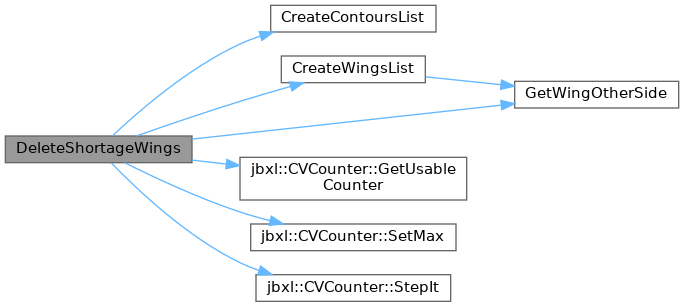
◆ DeleteStraightEdges()
| DllExport void DeleteStraightEdges | ( | BREP_SOLID * | solid | ) |
void jbxl::DeleteStraightEdges(BREP_SOLID* solid)
複数のVertexが直線に並んだ場合,両端のVertex間に作られた Edge(Wing)に関連する Contour(Facet)を削除.
Contours List と Wings Listの内容は保障される.
- 要求データ
- 全てのWingの List(Wings List).
- 外側の関数で行う.CreateWingsList()を使用しても良い.
- Contourに関連付けられていない(使用されていない)Wingが格納された作業List(ShortageWings List).
- 外側の関数で行う.CreateShortageWingsList() を使用しても良い.
- 全てのWingの List(Wings List).
Definition at line 210 of file TriBrep.cpp.
References BREP_SOLID::counter, CreateContoursList(), CreateWingsList(), CVCounter::GetUsableCounter(), GetWingOtherSide(), IsConnectEdges(), IsForbiddenEdge(), CVCounter::SetMax(), BREP_SOLID::shortage_wings, CVCounter::StepIt(), and BREP_WING::vertex.
Referenced by CloseTriSolid().
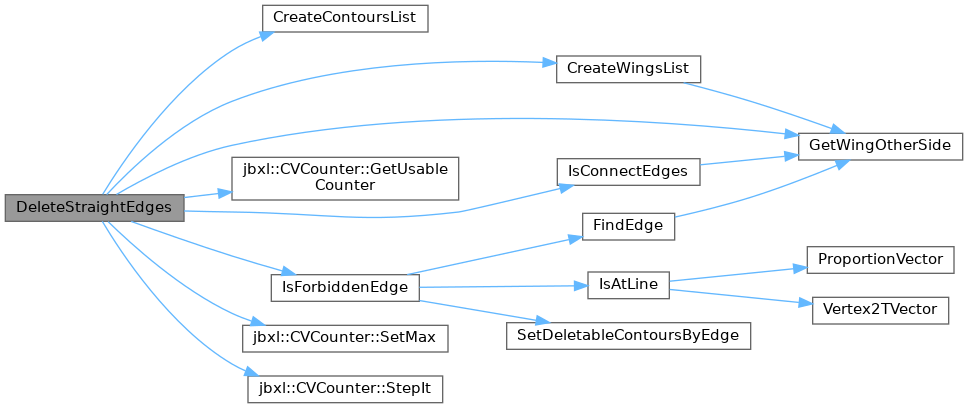

◆ DeleteSurplusContours()
| DllExport void DeleteSurplusContours | ( | BREP_SOLID * | solid | ) |
void jbxl::DeleteSurplusContours(BREP_SOLID* solid)
多重Edgeを持つ Contour(Facet)の削除
Contours List と Wings Listの内容は保障される.
- 要求データ
- 全てのContour(Facet)の List (Contours List).
- 外側の関数で行う.CreateContoursList()を使用しても良い.
- 多重エッジの数が1以上のContour(Facet)が格納された作業List(SurplusContours List).
- 外側の関数で行う.CreateSuplusContoursList()を使用しても良い
- 全てのContour(Facet)の List (Contours List).
- アルゴリズム
- 作業Listの中にある3辺が多重EdgeのFacetに削除マークをつける(高速化のため)
- 該当Facet(Contour)を削除し,そのFacet(Contour)を裏返して登録する (ReverseContours)
- 多重Edgeが一つでもある場合は登録を中止
- 2辺が多重Edgeの Facetに削除マークをつける.1と同様の処理を行う.
- 1辺が多重Edgeの Facetに削除マークをつける.1と同様の処理を行う.
- この段階で,作業Listの中には Facetは存在しないはず.まだ存在する場合はエラー.
- 作業Listの中にある3辺が多重EdgeのFacetに削除マークをつける(高速化のため)
Definition at line 140 of file TriBrep.cpp.
References BREP_SOLID::counter, CreateShortageWingsList(), CreateSurplusContoursList(), CVCounter::GetUsableCounter(), JoinShortageWings(), ReverseContours(), CVCounter::SetMax(), CVCounter::StepIt(), and BREP_SOLID::surplus_contours.
Referenced by CloseTriSolid().


◆ DelMeshFacetNode()
| MeshFacetNode * DelMeshFacetNode | ( | MeshFacetNode * | node | ) |
Definition at line 489 of file MeshFacetNode.cpp.
References freeMeshFacetNode(), MeshFacetNode::next, and MeshFacetNode::prev.

◆ Density_Filter()
| MSGraph< T > Density_Filter | ( | MSGraph< T > | vp, |
| int | size, | ||
| double | rate, | ||
| int | mode = 8, | ||
| int | work_color = 0 ) |
template <typename T> MSGraph<T> Density_Filter(MSGraph<T> vp, int size, double rate, int mode=8, int work_color=0)
密度フィルター
画像データの密度マスクを適用して返す.
- Parameters
-
vp 画像データ size マスクのサイズ rate 密度の閾値 mode 近傍(4 or 8) work_color 作業用輝度値
- Returns
- 処理結果の画像データ
Definition at line 2381 of file Graph.h.
References MSGraph< T >::base, MSGraph< T >::free(), MSGraph< T >::get_minmax(), MSGraph< T >::gp, MSGraph< T >::max, MSGraph< T >::mimicry(), MSGraph< T >::set(), MSGraph< T >::state, MSGraph< T >::xs, MSGraph< T >::ys, and MSGraph< T >::zero.

◆ Density_Mask()
| MSGraph< T > Density_Mask | ( | MSGraph< T > | vp, |
| double | rate, | ||
| int | mode = 8, | ||
| int | work_color = 0 ) |
template <typename T> MSGraph<T> Density_Mask(MSGraph<T> vp, double rate, int mode=8, int work_color=0)
密度マスク
区画の中で縁に接して,かつ zeroでない画素の数を数え,全体の画素の 数に対して rate 以上の比率の場合,その画素パターンを返す.
rateに満たない場合は zero で埋められたパターンを返す.
- Parameters
-
vp 画像データ rate 密度 mode モード. 8:8近傍の塗りつぶし. その他:4近傍の塗りつぶし work_color 作業用輝度値
- Returns
- 処理結果の画像データ
Definition at line 2307 of file Graph.h.
References MSGraph< T >::base, MSGraph< T >::clear(), MSGraph< T >::color, MSGraph< T >::free(), MSGraph< T >::get_minmax(), MSGraph< T >::gp, MSGraph< T >::max, MSGraph< T >::mimicry(), MSGraph_Paint(), OFF, ON, MSGraph< T >::RZxy, MSGraph< T >::set(), set_around_MSGraph(), MSGraph< T >::state, MSGraph< T >::xs, MSGraph< T >::ys, and MSGraph< T >::zero.

◆ DestroyWing()
void jbxl::DestroyWing(BREP_WING* wing)
Definition at line 865 of file Brep.cpp.
References BREP_EDGE::complete, BREP_WING::contour, BREP_CONTOUR::DisconnectWing(), BREP_VERTEX::DisconnectWing(), BREP_WING::edge, BREP_WING::vertex, BREP_EDGE::wing1, and BREP_EDGE::wing2.
Referenced by BREP_CONTOUR::DestroyWings().
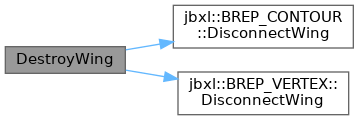

◆ dgree_circle_MSGraph()
template <typename T> Vector<double> dgree_circle_MSGraph(MSGraph<T> vp)
2D画像において,vp.zero以外の輝度値のオブジェクトの分散度(円形度の逆数)を計算する.
穴空きのオブジェクトも計算可能.独自アルゴリズム.
- Parameters
-
vp 画像データ
- Bug
- 縁にかかる画像にかんしては正確に外周を計算できない.=> 縁をvp.zeroで埋めること.
Definition at line 86 of file Graph.h.
References count_area_MSGraph(), count_around_MSGraph(), PI, Vector< T >::x, Vector< T >::y, and Vector< T >::z.

◆ dicomHeader()
| int dicomHeader | ( | FILE * | fp, |
| int | fsize, | ||
| int * | dsize, | ||
| int * | xsize, | ||
| int * | ysize, | ||
| int * | depth, | ||
| double * | rzxy ) |
int jbxl::dicomHeader(FILE* fp, int fsize, int* dsize, int* xsize, int* ysize, int* depth, double* rzxy)
DICOM型式のファイルからヘッダを読みだす.
- Parameters
-
fp DICOM型式ファイルへのファイル識別子 fsize ファイルのサイズ. [out] dsize グラフィックデータの大きさが格納される. [out] xsize グラフィックデータの Xサイズが格納される. [out] ysize グラフィックデータの Yサイズが格納される. [out] depth グラフィックデータのデプス(Bit)が格納される. [out] rzxy Z軸の歪.0.0 なら不明.
- Return values
-
>0 読みこんだヘッダの大きさ (Byte単位). 0 ヘッダの区切りを識別できなかった. JBXL_GRAPH_INVARG_ERROR 不正な引数 (fp, fsize, dsize) JBXL_GRAPH_MEMORY_ERROR メモリ不足
Definition at line 471 of file Gio.cpp.
References DICOM_DEPTH_ELEMENT, DICOM_IMAGE_GROUP, DICOM_INT_VR, DICOM_PIXCEL_VR, DICOM_PIXEL_ELEMENT, DICOM_PIXEL_GROUP, DICOM_PXLSPC_ELEMENT, DICOM_STR_VR, DICOM_XSIZE_ELEMENT, DICOM_YSIZE_ELEMENT, JBXL_FILE_READ_ERROR, JBXL_GRAPH_IVDARG_ERROR, JBXL_GRAPH_MEMORY_ERROR, LNAME, OFF, and ON.
Referenced by readDicomData(), and readXHead().

◆ disJunctBounds()
template <typename T> inline bool disJunctBounds(RBound<T> b1, RBound<T> b2)
境界領域b1とb2が重なっているかどうかをチェック
- Return values
-
true 重なっていない false 重なっている
Definition at line 580 of file Vector.h.
References RBound< T >::xmax, RBound< T >::xmin, RBound< T >::ymax, RBound< T >::ymin, RBound< T >::zmax, and RBound< T >::zmin.
Referenced by IsCollisionContours().

◆ DisPatcher()
| void DisPatcher | ( | int | sno = 0, |
| ... ) |
Windows用 ディスパッチャー
void WinDisPatcher(int sno=0, unsigned int signal1, unsigned int signal2, ...);
機能:シグナル(メッセージ)キューに溜まったシグナル(メッセージ)をディスパッチする. 引数に,無視する(ディスパッチしない)シグナル(メッセージ)を複数(可変)個指定可能. プログラム自体を終了させるシグナル(メッセージ)がキューにあった場合は,プログラムを 強制終了させる.Windowsの場合は WM_QUIT (0x0111)
Windows 用のみ実装.Linux の処理の仕方は知らない.......(不勉強です)
引数:無視するシグナル(メッセージ)の数,無視するシグナル1,無視するシグナル2,......... シグナル(メッセージ)自体は unsigned int で指定する. 無視するシグナル(メッセージ)を指定しない場合は,引数無しで呼び出し可能
例 :DisPatcher(1, WM_NCLBUTTONDOWN); DisPatcher(); DisPatcher(0) と同じ
Definition at line 33 of file tools++.cpp.
◆ dup_Matrix()
template <typename T> Matrix<T> dup_Matrix(Matrix<T> a)
同じ Matrixデータを作り出す.ただしメモリ部は共有しない
Definition at line 250 of file Matrix++.h.
References Matrix< T >::d, Matrix< T >::err, Matrix< T >::getm(), Matrix< T >::mx, Matrix< T >::n, Matrix< T >::r, and Matrix< T >::sz.
Referenced by Matrix< T >::dup().


◆ dup_MSGraph() [1/2]
template <typename T> MSGraph<T>* dup_MSGraph(MSGraph<T>* src)
MSGraph<T>型データのコピーを作成する.
- Parameters
-
src コピー元グラフィックデータ
- Returns
- コピーされた MSGraph<T>型のデータ
Definition at line 634 of file Graph.h.
References MSGraph< T >::getm(), MSGraph< T >::gp, MSGraph< T >::init(), MSGraph< T >::isNull(), JBXL_GRAPH_MEMORY_ERROR, JBXL_GRAPH_NODATA_ERROR, MSGraph< T >::state, MSGraph< T >::xs, MSGraph< T >::ys, MSGraph< T >::zero, and MSGraph< T >::zs.

◆ dup_MSGraph() [2/2]
template <typename T> MSGraph<T> dup_MSGraph(MSGraph<R> src)
MSGraph<T>型データのコピーを作成する.
- Parameters
-
src コピー元グラフィックデータ
- Returns
- コピーされた MSGraph<T>型のデータ
Definition at line 602 of file Graph.h.
References MSGraph< T >::getm(), MSGraph< T >::gp, MSGraph< T >::init(), MSGraph< T >::isNull(), JBXL_GRAPH_MEMORY_ERROR, JBXL_GRAPH_NODATA_ERROR, MSGraph< T >::state, MSGraph< T >::xs, MSGraph< T >::ys, MSGraph< T >::zero, and MSGraph< T >::zs.

◆ DupEdgeNumber()
| DllExport int DupEdgeNumber | ( | BREP_CONTOUR * | contour | ) |
int jbxl::DupEdgeNumber(BREP_CONTOUR* contour)
Contourの多重Edgeの数を数える.
Definition at line 651 of file TriBrep.cpp.
References BREP_CONTOUR::dup_edge, BREP_WING::edge, BREP_EDGE::edge_list, BREP_WING::next, and BREP_CONTOUR::wing.
Referenced by CreateSurplusContoursList(), PatchupContour(), and ReverseContours().

◆ dupTriPolygonData()
| TriPolygonData * dupTriPolygonData | ( | TriPolygonData * | data, |
| int | num ) |
Definition at line 267 of file ContourBaseData.cpp.
References TriPolygonData::dup().

◆ dupVector()
◆ dupVector4()
◆ edgeEnhance()
template <typename R, typename T> MSGraph<R> edgeEnhance(MSGraph<T> gd, int mode=0)
グラフィックデータのラプラシアンを使ったエッジ強調.(2Dのみ)
- Parameters
-
gd 計算対象となるグラフィックデータ構造体. mode モード.4: 4近傍ラプラシアン
8: 8近傍ラプラシアン 3x3
その他: Sobelのラプラシアン(24近傍) 5x5
- Returns
- 処理されたグラフィックデータ.
Definition at line 768 of file Gmt.h.
References DEBUG_MODE, MSGraph< T >::free(), MSGraph< T >::gp, MSGraph< T >::isNull(), JBXL_GRAPH_MEMORY_ERROR, MSGraph< T >::mimicry(), PRINT_MESG, MSGraph< T >::state, MSGraph< T >::xs, MSGraph< T >::ys, and MSGraph< T >::zs.

◆ euclidDistance()
template <typename T> MSGraph<int> euclidDistance(MSGraph<T> vp, int bc, int& rr)
WSGグラフィック上を 2値化し,各点における輝度値0の点からの ユークリッド距離の 2乗の最小を求める.
- Parameters
-
vp 操作対象となるグラフィックデータ構造体. bc 輝度値の 2値化の値.これより小さいものは0,これ以上は 1. rr 指定しない.画像中のユークリッド距離の 2乗の最大値が入る.
- Returns
- 輝度値の代わりにユークリッド距離が記入されたグラフィックデータ.
Definition at line 864 of file Gmt.h.
References MSGraph< T >::base, MSGraph< T >::clear(), DEBUG_MODE, MSGraph< T >::free(), MSGraph< T >::gp, MSGraph< T >::isNull(), JBXL_GRAPH_MEMORY_ERROR, Max, Min, PRINT_MESG, MSGraph< T >::RZxy, MSGraph< T >::state, MSGraph< T >::xs, MSGraph< T >::ys, MSGraph< T >::zero, and MSGraph< T >::zs.
Referenced by centerLine().
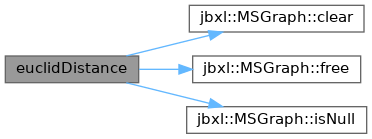

◆ ExtEulerXYZ2Quaternion()
|
inline |
Definition at line 236 of file Rotation.h.
References Quaternion< T >::setExtEulerXYZ().

◆ ExtEulerXYZ2RotMatrix()
Definition at line 504 of file Rotation.h.
References Matrix< T >::element(), Vector< T >::element1(), Vector< T >::element2(), and Vector< T >::element3().

◆ ExtEulerXZY2Quaternion()
|
inline |
Definition at line 238 of file Rotation.h.
References Quaternion< T >::setExtEulerXZY().

◆ ExtEulerXZY2RotMatrix()
Definition at line 554 of file Rotation.h.
References Matrix< T >::element(), Vector< T >::element1(), Vector< T >::element2(), and Vector< T >::element3().
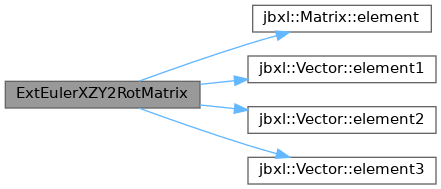
◆ ExtEulerYXZ2Quaternion()
|
inline |
Definition at line 240 of file Rotation.h.
References Quaternion< T >::setExtEulerYXZ().

◆ ExtEulerYXZ2RotMatrix()
Definition at line 629 of file Rotation.h.
References Matrix< T >::element(), Vector< T >::element1(), Vector< T >::element2(), and Vector< T >::element3().
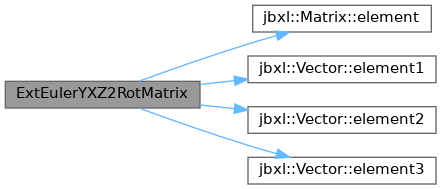
◆ ExtEulerYZX2Quaternion()
|
inline |
Definition at line 239 of file Rotation.h.
References Quaternion< T >::setExtEulerYZX().

◆ ExtEulerYZX2RotMatrix()
Definition at line 579 of file Rotation.h.
References Matrix< T >::element(), Vector< T >::element1(), Vector< T >::element2(), and Vector< T >::element3().
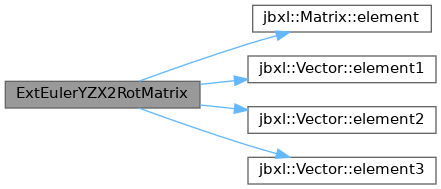
◆ ExtEulerZXY2Quaternion()
|
inline |
Definition at line 241 of file Rotation.h.
References Quaternion< T >::setExtEulerZXY().

◆ ExtEulerZXY2RotMatrix()
Definition at line 604 of file Rotation.h.
References Matrix< T >::element(), Vector< T >::element1(), Vector< T >::element2(), and Vector< T >::element3().
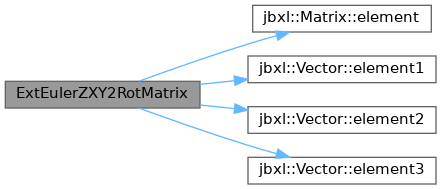
◆ ExtEulerZYX2Quaternion()
|
inline |
Definition at line 237 of file Rotation.h.
References Quaternion< T >::setExtEulerZYX().

◆ ExtEulerZYX2RotMatrix()
Definition at line 529 of file Rotation.h.
References Matrix< T >::element(), Vector< T >::element1(), Vector< T >::element2(), and Vector< T >::element3().
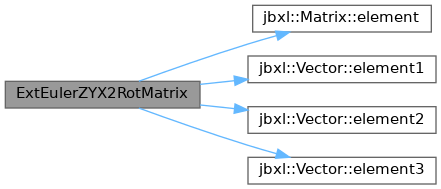
◆ FastDeleteFacet()
| DllExport void FastDeleteFacet | ( | BREP_FACET * | facet | ) |
void jbxl::FastDeleteFacet(BREP_FACET* facet)
直前に生成した Facetを高速に削除する.
直前に生成したものでない Facetを指定した場合は誤作動する.
Facetの数が多い場合,delete(Facet) または ~BREP_FACET()を実行すると一々find()を呼び出すので時間が掛かる.
Definition at line 787 of file TriBrep.cpp.
References BREP_CONTOUR::facet, BREP_SHELL::facets, BREP_FACET::outer_contours, and BREP_FACET::shell.
Referenced by PatchupContour(), and ReverseContours().

◆ fat_object_morph()
template <typename T> MSGraph<T> fat_object_morph(MSGraph<T> vp, MSGraph<T> xp, int cc)
画像を太らせる処理(何て言うんだっけ?)
Definition at line 171 of file Morph.h.
References copy_morph_element(), MSGraph< T >::gp, MSGraph< T >::isNull(), point_fat_object_morph(), MSGraph< T >::xs, MSGraph< T >::ys, and MSGraph< T >::zs.
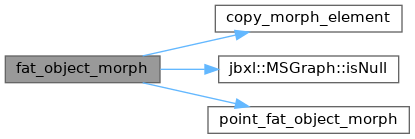
◆ FillShortageWings()
| DllExport void FillShortageWings | ( | BREP_SOLID * | solid, |
| int | method, | ||
| bool | mode ) |
void jbxl::FillShortageWings(BREP_SOLID* solid, int method, bool mode)
足りないContourを補充する(全ての不足Contourが無くなるか,補充不可能になるまで).
Contours List, Wings List, SohrtageWins Listの内容は保障される.
- 要求データ
- ShortageWings List.CreateShortageWingsList()で作成しても良い
- Parameters
-
solid ソリッドデータへのポインタ method 1: 三番目のVertexを探すアルゴリズムは Next. method 2: 三番目のVertexを探すアルゴリズムは Near. mode true : 多重Edgeを認める. mode false: 多重Edgeを認めない.
Definition at line 292 of file TriBrep.cpp.
References BREP_SOLID::counter, CreateShortageWingsList(), FillShortageWings_Near(), FillShortageWings_Next(), CVCounter::GetUsableCounter(), JBXL_BREP_MAX_LOOPCNT, CVCounter::SetMax(), and BREP_SOLID::shortage_wings.
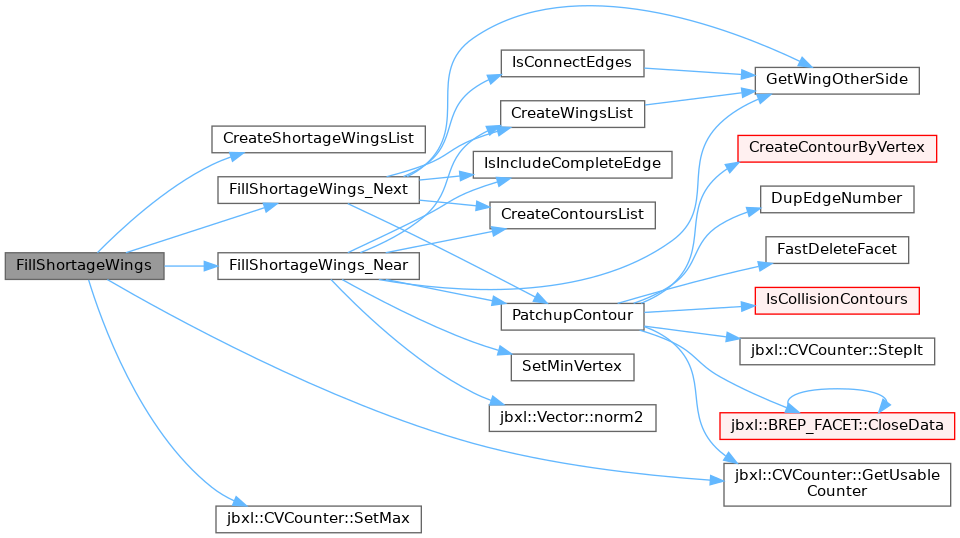
◆ FillShortageWings_Near()
| DllExport int FillShortageWings_Near | ( | BREP_SOLID * | solid, |
| bool | mode ) |
DllExport int jbxl::FillShortageWings_Near(BREP_SOLID* solid, bool mode)
足りないContourを補充する(一周期のみ).Nearアルゴリズム
Edgeの中心から近いVertexを探して三角形(Contour)を作る.
Contours List と Wings Listの内容は保障される.
- 要求データ
- ShortageWings List.CreateShortageWingsList()で作成しても良い
- Parameters
-
solid ソリッドデータへのポインタ mode true : 多重Edgeを認める. mode false: 多重Edgeを認めない.
Definition at line 383 of file TriBrep.cpp.
References BREP_WING::contour, CreateContoursList(), CreateWingsList(), BREP_VERTEX::distance2, BREP_CONTOUR::facet, GetWingOtherSide(), IsIncludeCompleteEdge(), JBXL_BREP_MAX_QUEUESIZE, Vector< T >::norm2(), PatchupContour(), BREP_VERTEX::point, SetMinVertex(), BREP_FACET::shell, BREP_SOLID::shortage_wings, and BREP_WING::vertex.
Referenced by FillShortageWings().


◆ FillShortageWings_Next()
| DllExport int FillShortageWings_Next | ( | BREP_SOLID * | solid, |
| bool | mode ) |
int jbxl::FillShortageWings_Next(BREP_SOLID* solid, bool mode)
足りないContourを補充する(一周期のみ).Nextアルゴリズム
Edgeに繋がっているEdgeを探してそのVertexから三角形(Contour)を作る.
Contours List と Wings Listの内容は保障される.
- 要求データ
- ShortageWings List.CreateShortageWingsList()で作成しても良い
- Parameters
-
solid ソリッドデータへのポインタ mode true : 多重Edgeを認める. mode false: 多重Edgeを認めない.
Definition at line 337 of file TriBrep.cpp.
References BREP_WING::contour, CreateContoursList(), CreateWingsList(), BREP_CONTOUR::facet, GetWingOtherSide(), IsConnectEdges(), IsIncludeCompleteEdge(), PatchupContour(), BREP_FACET::shell, BREP_SOLID::shortage_wings, and BREP_WING::vertex.
Referenced by FillShortageWings().
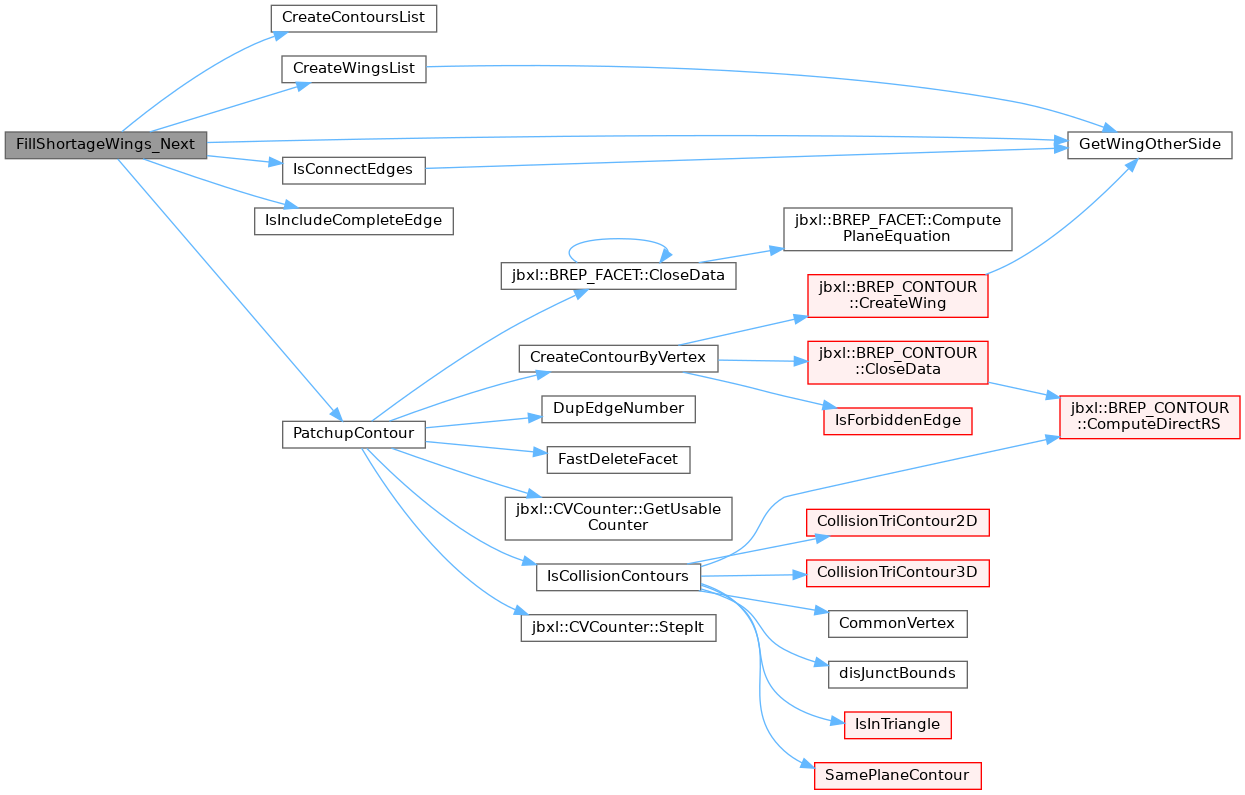

◆ FindConnectEdgeVertex()
| DllExport BREP_VERTEX * FindConnectEdgeVertex | ( | BREP_VERTEX * | vert | ) |
BREP_VERTEX* jbxl::FindConnectEdgeVertex(BREP_VERTEX* vert)
vertexと Edgeで繋がった vertexの内,最初に見つけたものを返す.
Definition at line 465 of file TriBrep.cpp.
References GetWingOtherSide(), BREP_WING::vertex, and BREP_VERTEX::wing_list.

◆ FindEdge()
| DllExport BREP_EDGE * FindEdge | ( | BREP_VERTEX * | vertex1, |
| BREP_VERTEX * | vertex2 ) |
BREP_EDGE* jbxl::FindEdge(BREP_VERTEX* vertex1, BREP_VERTEX* vertex2)
vertex1と vertex2が既にエッジで結ばれているかどうかをチェックする.
もし結ばれていれば,最初に見つけた Edgeを返す.
Definition at line 889 of file Brep.cpp.
References BREP_WING::edge, GetWingOtherSide(), BREP_WING::vertex, and BREP_VERTEX::wing_list.
Referenced by CreateWingWithoutContour(), and IsForbiddenEdge().


◆ free_CmnHead()
| void free_CmnHead | ( | CmnHead * | hd | ) |
void jbxl::free_CmnHead(CmnHead* hd)
共通ヘッダのメモリ領域を開放する.cmnHead.kind は HEADER_ERRになる
initCmnHead()を内包している.
- Parameters
-
hd 開放する共通ヘッダ
Definition at line 25 of file Gdata.cpp.
References CmnHead::buf, CmnHead::grptr, and init_CmnHead().
Referenced by copyMSGraph2CmnHead(), ExCmnHead::ffree(), ExCmnHead::free(), ExCmnHead::mfree(), readCmnHeadFile(), readGraphicFile(), readGraphicSlices(), readUserSetData(), readXHead(), and readXHeadFile().

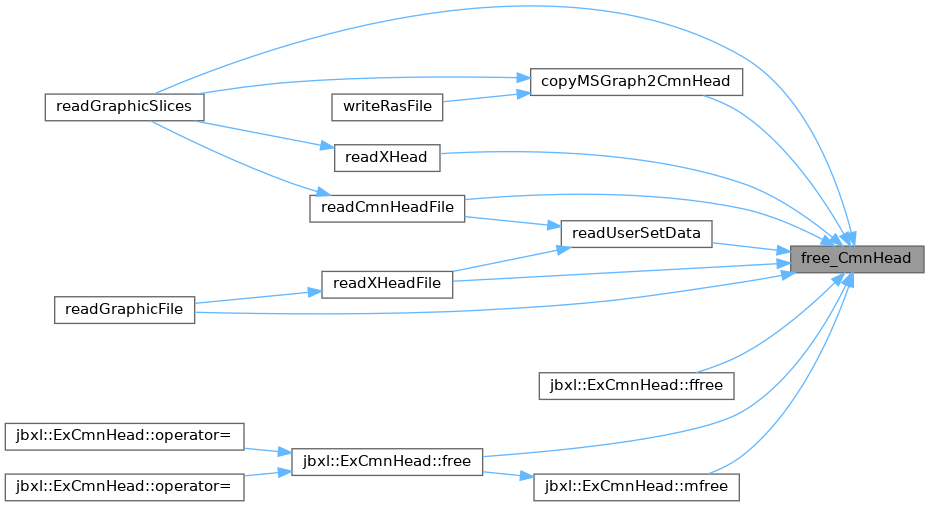
◆ freeAffineTrans()
|
inline |
Definition at line 141 of file AffineTrans.h.
References AffineTrans< T >::free().
Referenced by FBXData::delAffineTrans(), MeshObjectData::delAffineTrans(), OBJData::delAffineTrans(), and OBJFacetGeoNode::free().

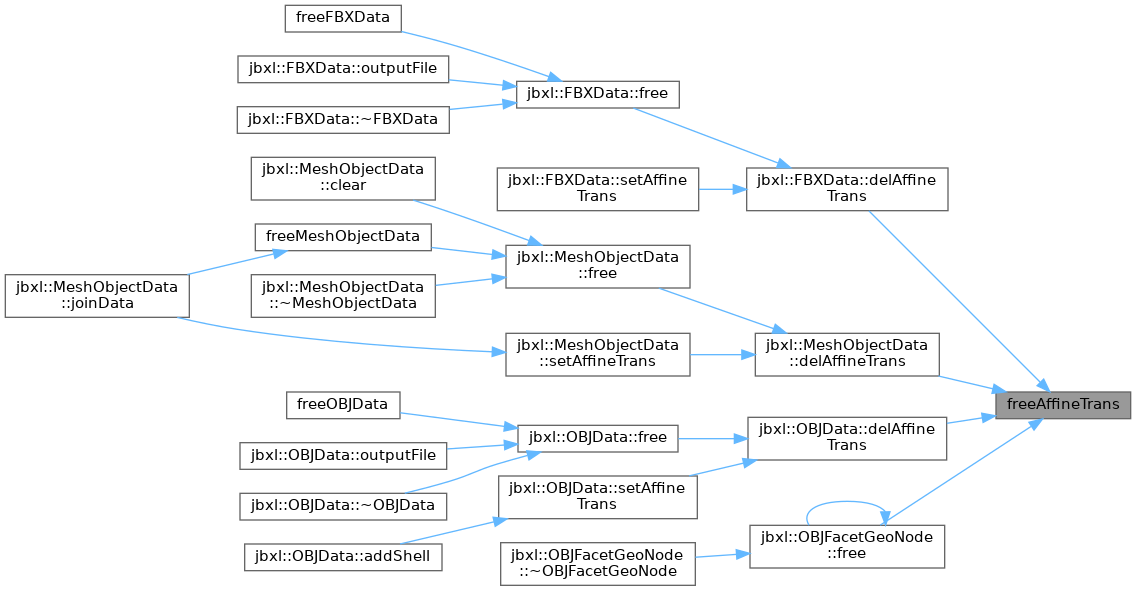
◆ freeArrayParams()
| void freeArrayParams | ( | ArrayParam< T > * | p, |
| int | num ) |
void freeArrayParams(ArrayParam<T>* p, int num)
ArrayParam の配列を解放する.
この関数呼び出し後に,必ず p = NULL とすること.
Definition at line 155 of file tools++.h.
References ArrayParam< T >::free().

◆ freeBrepSolid()
|
inline |
Definition at line 105 of file Brep.h.
References BREP_SOLID::FreeData().
Referenced by MeshFacetNode::computeVertexByBREP(), MeshFacetNode::computeVertexByBREP(), and BrepSolidList::free().


◆ freeBrepSolidList()
|
inline |
Definition at line 51 of file BrepLib.h.
References BrepSolidList::free().

◆ freeColladaXML()
|
inline |
Definition at line 145 of file ColladaTool.h.
References ColladaXML::free().

◆ freeContourBaseData()
|
inline |
Definition at line 178 of file ContourBaseData.h.
References ContourBaseData::free().

◆ freeFBXData()
|
inline |
Definition at line 69 of file FBXDataTool.h.
References FBXData::free().

◆ freeGLTFData()
|
inline |
Definition at line 304 of file GLTFDataTool.h.
References GLTFData::free().

◆ freeMeshFacetList()
| void freeMeshFacetList | ( | MeshFacetNode *& | node | ) |
Definition at line 475 of file MeshFacetNode.cpp.
References freeMeshFacetList(), freeMeshFacetNode(), and MeshFacetNode::next.
Referenced by MeshObjectData::free(), and freeMeshFacetList().


◆ freeMeshFacetNode()
|
inline |
Definition at line 89 of file MeshFacetNode.h.
References MeshFacetNode::free().
Referenced by DelMeshFacetNode(), and freeMeshFacetList().


◆ freeMeshObjectData()
|
inline |
Definition at line 81 of file MeshObjectData.h.
References MeshObjectData::free().
Referenced by MeshObjectData::joinData().


◆ freeNull()
|
inline |
Definition at line 37 of file common++.h.
References isNull().
Referenced by ColladaXML::addGeometry(), MeshObjectData::addNode(), OBJData::addShell(), ContourBaseData::free(), SkinJointData::free(), MeshFacetNode::free_value(), MeshObjectData::free_value(), MeshObjectData::importTriData(), MeshObjectData::importTriData(), readGraphicSlices(), readMoonData(), readRasData(), and readUserSetData().

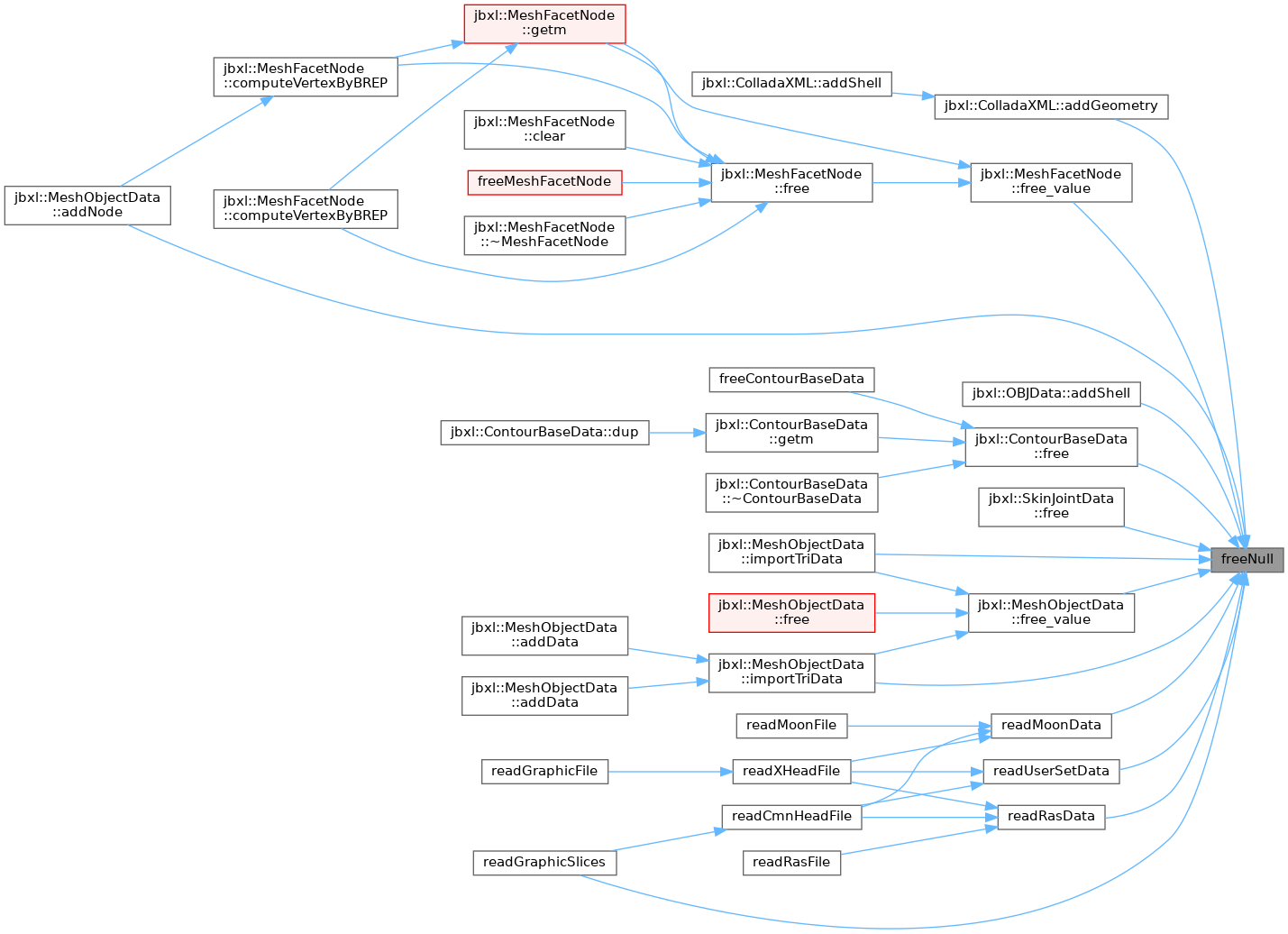
◆ freeOBJData()
|
inline |
Definition at line 96 of file OBJDataTool.h.
References OBJData::free().

◆ freeSTL()
◆ freeTriPolygonData() [1/2]
|
inline |
Definition at line 139 of file ContourBaseData.h.
References TriPolygonData::free().
Referenced by joinTriPolygonData().


◆ freeTriPolygonData() [2/2]
| void freeTriPolygonData | ( | TriPolygonData *& | tridata, |
| int | n ) |
Definition at line 311 of file ContourBaseData.cpp.
References TriPolygonData::free().

◆ get_boundary_MSGraph()
template <typename T> RBound<int> get_boundary_MSGraph(MSGraph<T> vp, T mn, T mx)
3Dオブジェクト境界を得る.
Definition at line 386 of file Graph.h.
References RBound< T >::cutdown(), RBound< T >::fusion(), MSGraph< T >::gp, MSGraph< T >::rbound, RBound< T >::set(), MSGraph< T >::xs, MSGraph< T >::ys, and MSGraph< T >::zs.

◆ getinfo_CmnHead()
CmnHead jbxl::getinfo_CmnHead(CmnHead hd)
ヘッダ情報のみをコピーする.
Definition at line 58 of file Gdata.cpp.
References CmnHead::bsize, CmnHead::buf, and CmnHead::grptr.
Referenced by readGraphicSlices().

◆ getMSGraphFromCvMat()
| MSGraph< T > * getMSGraphFromCvMat | ( | cv::Mat | mat | ) |
template <typename T> MSGraph<T>* getMSGraphFromCvMat(cv::Mat mat)
MSGraph<T> から OpenCV用の Matデータを作り出す.
T を cv::Mat の型と合わせるのは,呼び出し側の責任. cv::Matの型と(長さなどが)合わない型Tを指定した場合,戻り値のデータ内容は保障されない.
Mat のチャンネル数は 1と 3のみをサポート. 浮動小数点の depth(CV_32F, CV_64F)は変換できない.
T は uByte, sByte, uWord, sWord または unsigned int を指定する.
- Parameters
-
mat 元のMatデータ
- Returns
- MSGraph<>データ.失敗した場合は NULL
- Attention
- cv::imread()関数の戻り値のチャンネル数は通常3(RGB)となるので,モノクロデータを imread()関数で 読み込で,uWordのデータに変換するには場合は以下のようにする. cv::Mat src_img = cv::imread("suba.ras");MSGraph<uByte>* zp = getMSGraphFromCvMat<uByte>(src_img); // <uWord> にすると精度が落ちるxp = new MSGraph<sWord>();copy_MSGraph(*zp, *xp);delete(zp);またはcv::Mat gray, src_img = cv::imread("suba.ras");cv::cvtColor(src_img, gray, CV_BGR2GRAY);xp = getMSGraphFromCvMat<sWord>(gray);
Definition at line 203 of file OpenCVTool.h.
◆ GetOctreeVertices()
| DllExport BREP_VERTEX ** GetOctreeVertices | ( | OctreeNode * | octree, |
| long int * | vertexno ) |
要free
Definition at line 913 of file Brep.cpp.
References OctreeGetter().
Referenced by BrepSolidList::addSolid(), MeshFacetNode::computeVertexByBREP(), and MeshFacetNode::computeVertexByBREP().


◆ GetUsableGlobalCounter()
|
inline |
Definition at line 185 of file ClassBox.h.
References CVCounter::GetUsableCounter(), and GLCounter.
Referenced by copyCmnHead2MSGraph(), copyMSGraph2CmnHead(), cut_object_MSGraph(), cut_object_MSGraph(), cut_object_MSGraph(), readCmnHeadFile(), readGraphicFile(), readGraphicSlices(), readUserSetData(), readXHeadFile(), writeCmnHeadData(), writeGraphicFile(), x_reverse_MSGraph(), xSobel(), xxSobel(), ySobel(), yySobel(), zSobel(), and zzSobel().

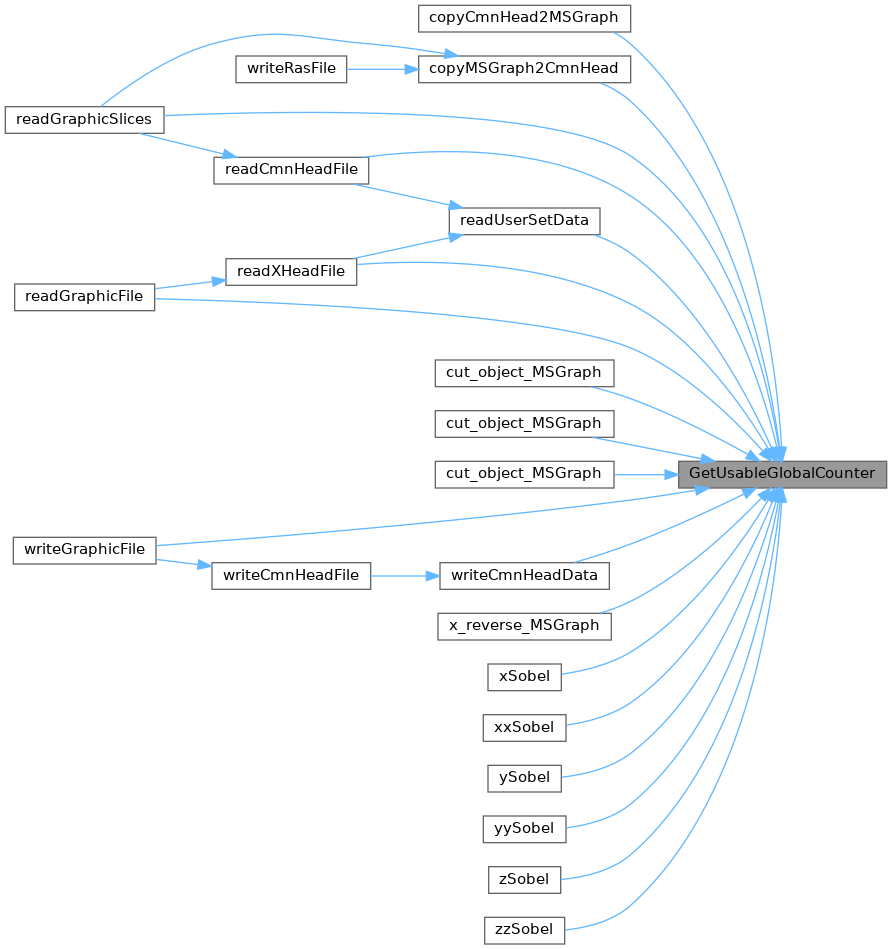
◆ GetWingOtherSide()
BREP_WING* jbxl::GetWingOtherSide(BREP_WING* wing)
Edgeに関連付けられたもう一方の Wing を返す.
Definition at line 1028 of file Brep.cpp.
References BREP_WING::edge, BREP_EDGE::wing1, and BREP_EDGE::wing2.
Referenced by BREP_CONTOUR::CreateWing(), CreateWingsList(), DeleteShortageWings(), DeleteStraightEdges(), FillShortageWings_Near(), FillShortageWings_Next(), FindConnectEdgeVertex(), FindEdge(), IsConnectEdges(), and JoinShortageWings().
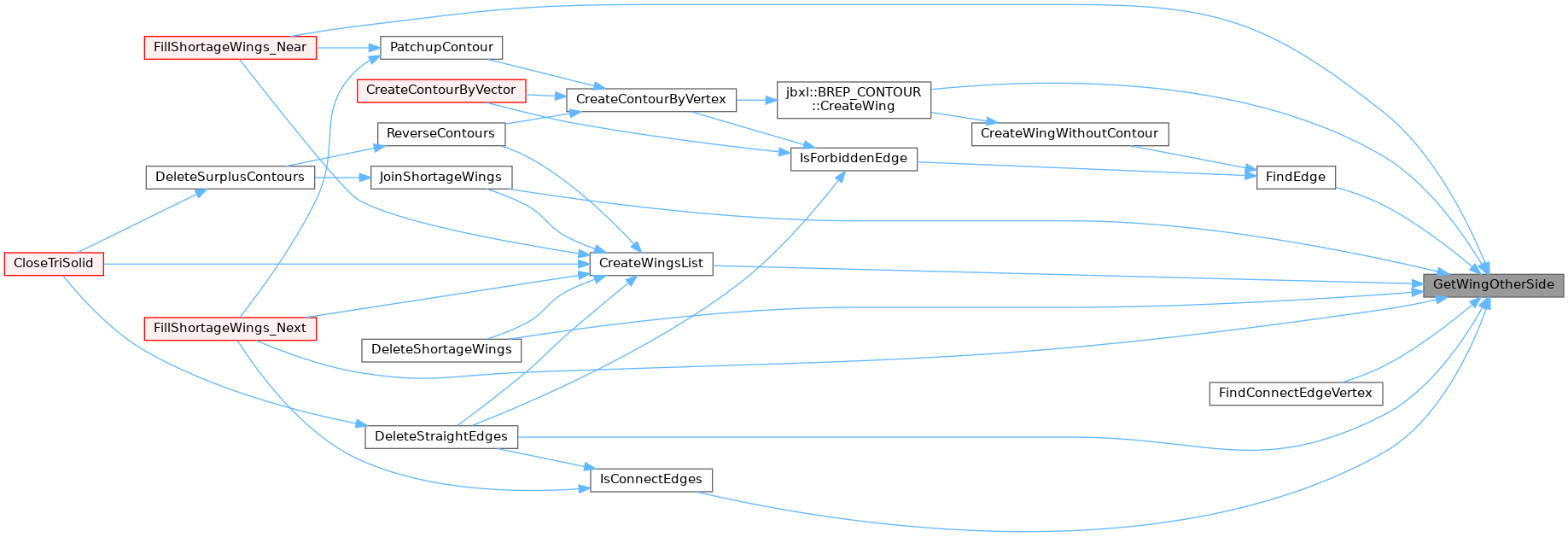
◆ grab_MSGraph() [1/2]
| MSGraph< T > * grab_MSGraph | ( | MSGraph< T > * | vp, |
| int | x1, | ||
| int | y1, | ||
| int | x2, | ||
| int | y2, | ||
| int | zs = 0, | ||
| int | ze = 0 ) |
template <typename T> MSGraph<T>* grab_MSGraph(MSGraph<T>* vp, int x1, int y1, int x2, int y2, int zs=0, int ze=0)
MSGraph<T>型データvpの (x1,y1)-(x2,y2)の矩形部分だけを取り出す.
(x1,y1)-(x2,y2)が元のデータの範囲を越える場合は,元のデータに合わせられる.
輝度値の最大(max),最小(min) も設定される.
- Parameters
-
vp 操作対象グラフィックデータ (x1,y1),(x2,y2) 矩形の対角の座標. zs,ze z軸の範囲
- Returns
- 取り出したグラフィックデータ.bound メンバに切り出した範囲が入る.
Definition at line 2143 of file Graph.h.
References MSGraph< T >::base, MSGraph< T >::color, MSGraph< T >::init(), Max, MSGraph< T >::max, Min, MSGraph< T >::min, MSGraph< T >::point(), MSGraph< T >::rbound, MSGraph< T >::set(), RBound< T >::xmax, RBound< T >::xmin, MSGraph< T >::xs, RBound< T >::ymax, RBound< T >::ymin, MSGraph< T >::ys, MSGraph< T >::zero, RBound< T >::zmax, RBound< T >::zmin, and MSGraph< T >::zs.

◆ grab_MSGraph() [2/2]
| MSGraph< T > grab_MSGraph | ( | MSGraph< T > | vp, |
| int | x1, | ||
| int | y1, | ||
| int | x2, | ||
| int | y2, | ||
| int | zs = 0, | ||
| int | ze = 0 ) |
template <typename T> MSGraph<T> grab_MSGraph(MSGraph<T> vp, int x1, int y1, int x2, int y2, int zs=0, int ze=0)
MSGraph<T>型データvpの (x1,y1)-(x2,y2)の矩形部分だけを取り出す.
(x1,y1)-(x2,y2)が元のデータの範囲を越える場合は,元のデータに合わせられる.
- Parameters
-
vp 操作対象グラフィックデータ (x1,y1),(x2,y2) 矩形の対角の座標. zs,ze z軸の範囲
- Returns
- 取り出したグラフィックデータ.bound メンバに切り出した範囲が入る.
Definition at line 2079 of file Graph.h.
References MSGraph< T >::base, MSGraph< T >::color, MSGraph< T >::init(), MSGraph< T >::isNull(), Max, MSGraph< T >::max, Min, MSGraph< T >::min, MSGraph< T >::point(), MSGraph< T >::rbound, MSGraph< T >::set(), RBound< T >::xmax, RBound< T >::xmin, MSGraph< T >::xs, RBound< T >::ymax, RBound< T >::ymin, MSGraph< T >::ys, MSGraph< T >::zero, RBound< T >::zmax, RBound< T >::zmin, and MSGraph< T >::zs.

◆ init_CmnHead()
| void init_CmnHead | ( | CmnHead * | hd | ) |
void jbxl::init_CmnHead(CmnHead* hd)
共通ヘッダのメモリ領域を初期化する.cmnHead.kind は HEADER_ERRになる
- Parameters
-
hd 初期化する共通ヘッダ
Definition at line 42 of file Gdata.cpp.
References CmnHead::bsize, CmnHead::buf, CmnHead::depth, CmnHead::grptr, HEADER_NONE, CmnHead::kind, CmnHead::lsize, CmnHead::xsize, CmnHead::ysize, and CmnHead::zsize.
Referenced by free_CmnHead(), ExCmnHead::getm(), ExCmnHead::init(), readUserSetData(), and ExCmnHead::set().
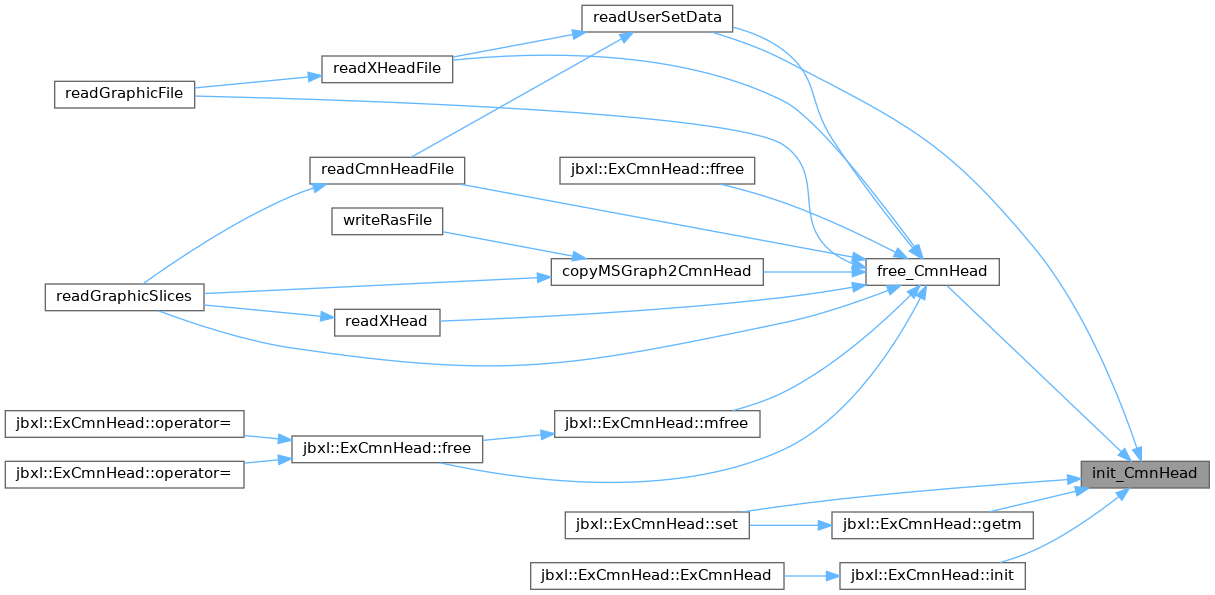
◆ IsAtLine()
| DllExport int IsAtLine | ( | BREP_VERTEX ** | v | ) |
Definition at line 853 of file TriBrep.cpp.
References Max, ProportionVector(), Vertex2TVector(), and Zero_Eps.
Referenced by IsForbiddenEdge().


◆ IsCollisionContours()
| DllExport bool IsCollisionContours | ( | BREP_SOLID * | solid, |
| BREP_CONTOUR * | contour, | ||
| BREP_CONTOUR ** | collision ) |
bool jbxl::IsCollisionContours(BREP_SOLID* solid, BREP_CONTOUR* contour, BREP_CONTOUR** collision)
Contour が他の Contourと衝突しているかどうかをチェックする.
- Note
- 処理スピードは遅い
Definition at line 930 of file TriBrep.cpp.
References CollisionTriContour2D(), CollisionTriContour3D(), CommonVertex(), BREP_CONTOUR::ComputeDirectRS(), BREP_SOLID::contours, disJunctBounds(), BREP_CONTOUR::facet, BREP_CONTOUR::hasCollisionVector, IsInTriangle(), BREP_FACET::rbound, and SamePlaneContour().
Referenced by PatchupContour().


◆ IsConnectEdges()
Definition at line 1489 of file TriBrep.cpp.
References GetWingOtherSide(), and BREP_WING::vertex.
Referenced by DeleteStraightEdges(), and FillShortageWings_Next().


◆ IsForbiddenEdge()
| DllExport bool IsForbiddenEdge | ( | BREP_VERTEX ** | vert | ) |
bool jbxl::IsForbiddenEdge(BREP_VERTEX** vert)
Vertex vert[0]〜vert[2] が一直線に並んでいるか調べる.
一直線の場合は,該当Edgeを禁止する.また,既にその Edgeがある場合は関連 Contourを削除する.
Definition at line 886 of file TriBrep.cpp.
References FindEdge(), BREP_VERTEX::forbidden_list, IsAtLine(), and SetDeletableContoursByEdge().
Referenced by CreateContourByVector(), CreateContourByVertex(), and DeleteStraightEdges().


◆ IsIncludeCompleteEdge()
bool jbxl::IsIncludeCompleteEdge(BREP_WING* wing)
Wingに関連したEdge及びその多重Edgeは完全か?
そこにあるEdgeの内,最低一つは閉じているか?
Definition at line 765 of file TriBrep.cpp.
References BREP_EDGE::complete, BREP_WING::edge, and BREP_EDGE::edge_list.
Referenced by FillShortageWings_Near(), and FillShortageWings_Next().

◆ IsInTriangle()
| DllExport bool IsInTriangle | ( | BREP_CONTOUR * | contour1, |
| BREP_CONTOUR * | contour2 ) |
Definition at line 1132 of file TriBrep.cpp.
References Collision_Tolerance, BREP_CONTOUR::directR, BREP_CONTOUR::directRS, BREP_CONTOUR::directS, Max, Vector< T >::n, BREP_WING::next, ProportionVector(), TVector< T >::t, BREP_WING::vertex, Vertex2TVector(), and BREP_CONTOUR::wing.
Referenced by IsCollisionContours().


◆ isNull()
|
inline |
Definition at line 24 of file common++.h.
References WIN_DD_NULL.
Referenced by ExMSGraph< T >::ffree(), CRingBuffer::free(), ExMSGraph< T >::free(), freeNull(), and ExMSGraph< T >::operator=().
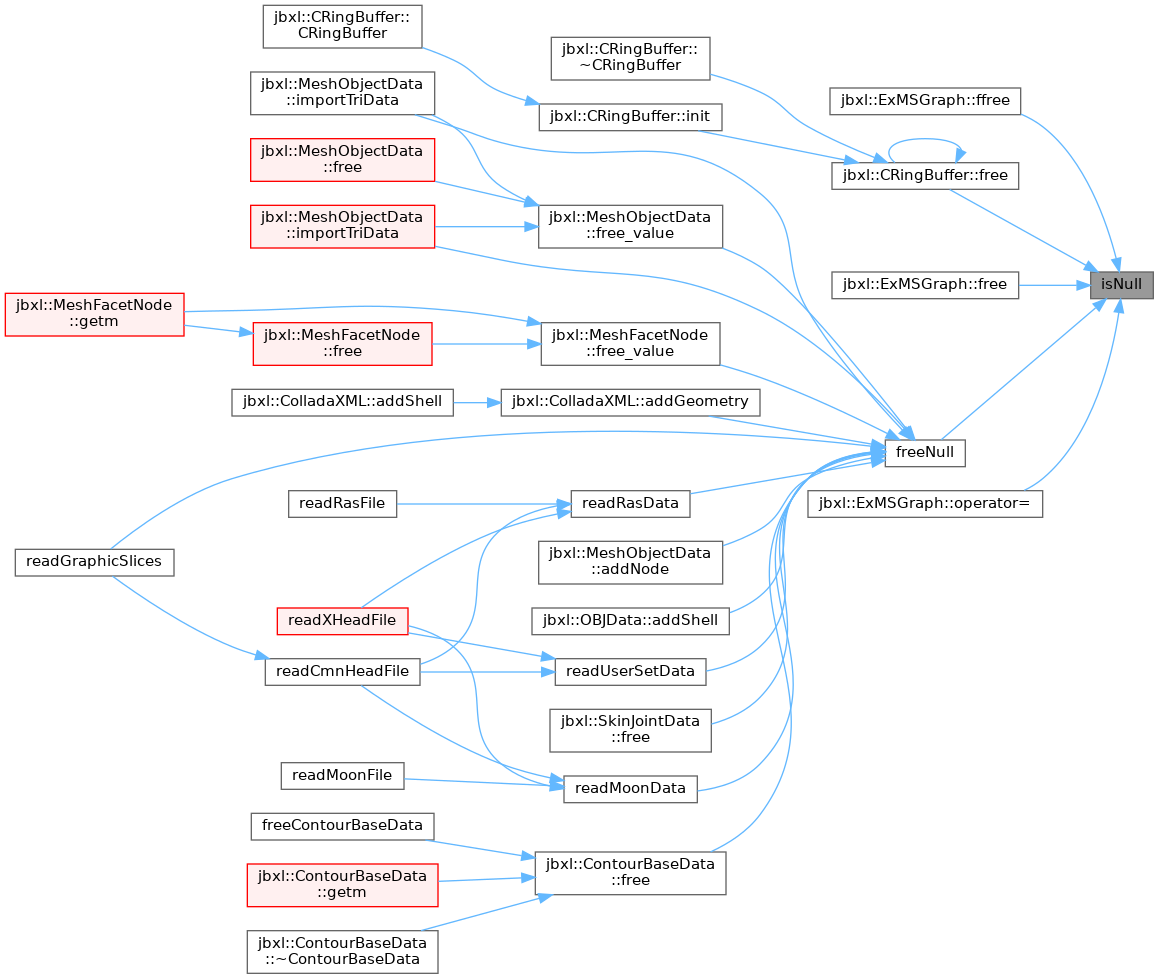
◆ isSameDimension()
Definition at line 443 of file Matrix++.h.
References Matrix< T >::n, Matrix< T >::r, and Matrix< T >::sz.
Referenced by operator+(), operator-(), and operator==().
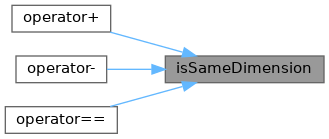
◆ isSameMaterial()
| bool isSameMaterial | ( | MaterialParam | a, |
| MaterialParam | b ) |
マテリアルのパラメータを比べる.
Definition at line 420 of file MaterialParam.cpp.
References MaterialParam::bumpmap, MaterialParam::getBase64Params(), isSameTexture(), MaterialParam::specmap, and MaterialParam::texture.
Referenced by MeshFacetNode::setMaterialParam().

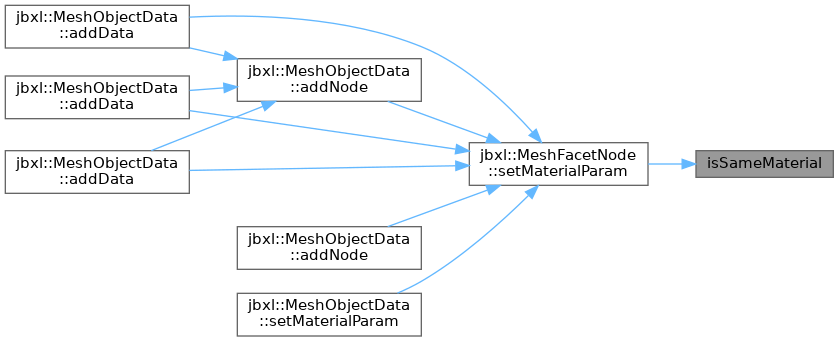
◆ isSameTexture()
| bool isSameTexture | ( | TextureParam | a, |
| TextureParam | b ) |
テクスチャ名,カラーを比べる
Definition at line 182 of file MaterialParam.cpp.
References TextureParam::getColor(), and TextureParam::getName().
Referenced by isSameMaterial().
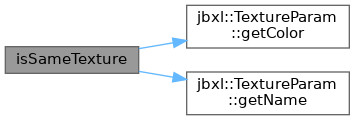

◆ JoinShortageWings()
| DllExport void JoinShortageWings | ( | BREP_SOLID * | solid | ) |
void jbxl::JoinShortageWings(BREP_SOLID* solid)
不完全かつ多重Edgeになっているが,実は一つのEdgeにまとめることができるものを一つにまとめる.
Contours List と Wings Listの内容は保障される.
- 要求データ
- ShortageWings List.CreateShortageWingsList()で作成しても良い
Definition at line 592 of file TriBrep.cpp.
References BREP_EDGE::complete, BREP_WING::contour, CreateContoursList(), CreateWingsList(), BREP_WING::edge, BREP_EDGE::edge_list, GetWingOtherSide(), BREP_SOLID::shortage_wings, BREP_WING::vertex, BREP_EDGE::wing1, and BREP_EDGE::wing2.
Referenced by DeleteSurplusContours().


◆ joinTriPolygonData()
| TriPolygonData * joinTriPolygonData | ( | TriPolygonData *& | first, |
| int | num_f, | ||
| TriPolygonData *& | next, | ||
| int | num_n ) |
Definition at line 283 of file ContourBaseData.cpp.
References TriPolygonData::dup(), freeTriPolygonData(), and TriPolygonData::polygonNum.

◆ Laplacian()
template <typename R, typename T> MSGraph<R> Laplacian(MSGraph<T> vp, int mode=0)
2Dグラフィックデータのラプラシアンを計算する.
- Parameters
-
vp 計算対象となるグラフィックデータ構造体. mode モード.4: 4近傍ラプラシアン
8: 8近傍ラプラシアン
その他: Sobelのラプラシアン(24近傍)
- Returns
- 処理されたグラフィックデータ.
- Note
- 3D化したい.
Definition at line 58 of file Gmt.h.
References MSGraph< T >::base, DEBUG_MODE, MSGraph< T >::gp, MSGraph< T >::isNull(), JBXL_GRAPH_MEMORY_ERROR, MSGraph< T >::mimicry(), PRINT_MESG, MSGraph< T >::state, MSGraph< T >::xs, MSGraph< T >::ys, and MSGraph< T >::zero.

◆ Local2World()
| void Local2World | ( | MSGraph< T > | gd, |
| MSGraph< T > | vp, | ||
| Vector< R > | oq, | ||
| Vector< R > | op, | ||
| Vector< R > | ex, | ||
| double * | pcsf = NULL, | ||
| double * | psnf = NULL ) |
template <typename T, typename R>
void Local2World(MSGraph<T> gd, MSGraph<T> vp, Vector<R> oq, Vector<R> op, Vector<R> ex, double pcsf=0.0, double psnf=1.0)
ローカルな観測座標系のグラフィック vpをグローバル座標系のグラフィック gd に埋めこむ.
ローカルな観測座標系 → ローカルな極座標系 → グローバル座標系
変換先の点の周りの格子点全てに値を設定する.
- Parameters
-
gd グローバル座標系のグラフィック空間. vp 観測座標系のグラフィックデータ(左上が原点). oq グローバル座標系から見たローカルな極座標系の原点の座標. op 観測座標系から見たローカルな極座標系の原点の座標. ex ローカルな極座標系から見た観測座標系のx軸(ローカルな極座標系でのz軸)の向き. pcsf sinθ≒0 の場合に *csfに代入される.連続計算の場合に直前の cosφの値を指定する. psnf sinθ≒0 の場合に *snfに代入される.連続計算の場合に直前の sinφの値を指定する.
Definition at line 730 of file Graph.h.
References MSGraph< T >::gp, ON, MSGraph< T >::set_vPoint(), ToPola(), Vector< T >::x, MSGraph< T >::xs, Vector< T >::y, MSGraph< T >::ys, Vector< T >::z, MSGraph< T >::zero, and MSGraph< T >::zs.
Referenced by MSGraph_Circle3D(), MSGraph_Pool(), and MSGraph_Torus().


◆ make_element_morph()
| MSGraph< T > make_element_morph | ( | Parameter32 | x | ) |
template <typename T> MSGraph<T> make_element_morph(Parameter x)
モルフォロジー演算のエレメントを生成する.
Definition at line 235 of file Morph.h.
References DEBUG_MODE, MSGraph< T >::getm(), MSGraph< T >::gp, MSGraph< T >::isNull(), Max, Min, ON, Parameter32::pm, PRINT_MESG, SPHERE_ELEMENT, Xabs, MSGraph< T >::xs, MSGraph< T >::ys, and MSGraph< T >::zs.

◆ medianFilter()
template <typename T> MSGraph<T> medianFilter(WSGraph<T> xp, int ms=3)
メディアンフィルタ処理を行なう.3D処理可.
- Parameters
-
xp 対象となるグラフィックデータ構造体. ms フィルタの大きさ.
- Returns
- メディアンフィルタ処理されたグラフィックデータ.
Definition at line 800 of file Gmt.h.
References DEBUG_MODE, MSGraph< T >::gp, MSGraph< T >::isNull(), JBXL_GRAPH_MEMORY_ERROR, MSGraph< T >::mimicry(), Min, PRINT_MESG, MSGraph< T >::state, MSGraph< T >::xs, MSGraph< T >::ys, and MSGraph< T >::zs.

◆ MidPoint() [1/2]
◆ MidPoint() [2/2]
◆ Morphology()
| MSGraph< T > Morphology | ( | MSGraph< T > | vp, |
| MSGraph< T > | xp, | ||
| int | cc, | ||
| int | mode ) |
template <typename T> MSGraph<T> Morphology(MSGraph<T> vp, MSGraph<T> xp, int cc, int mode)
画像vpに対して,エレメントxpで,modeのモルフォロジー演算を行う.
現在は OPENING のmodeしかサポートしていない.
- Parameters
-
vp 処理対象の元データ xp エレメント画像 cc 閾値.この輝度値以上の画素に対して演算を行う mode 演算の種類を指定
- Returns
- 処理結果の画像
Definition at line 51 of file Morph.h.
References DEBUG_MODE, OPENING, opening_morph(), and PRINT_MESG.

◆ MSGraph2TGAImage()
template <typename T> TGAImage MSGraph2TGAImage(MSGraph<T> vp, bool rle)
MSGraph型イメージデータを TGAイメージデータに変換する ヘッダ情報は変換しない(別途変換する).
- Parameters
-
vp MSGraph型イメージデータ rle RLE(連長圧縮)を行うかどうか
- Returns
- TGAイメージデータ
- Return values
-
JBXL_GRAPH_NODATA_ERROR state データ無し JBXL_GRAPH_MEMORY_ERROR state メモリ確保エラー
Definition at line 168 of file TgaTool.h.
References TGAImage::col, MSGraph< T >::color, TGAImage::free(), MSGraph< T >::gp, GRAPH_COLOR_ABGR, GRAPH_COLOR_ARGB, GRAPH_COLOR_BGR, GRAPH_COLOR_BGRA, GRAPH_COLOR_GRAY, GRAPH_COLOR_MA, GRAPH_COLOR_RGB, GRAPH_COLOR_RGBA, GRAPH_COLOR_UNKNOWN, TGAImage::init(), MSGraph< T >::isNull(), TGAImage::isNull(), JBXL_GRAPH_IVDARG_ERROR, JBXL_GRAPH_NODATA_ERROR, TGAImage::length, TGAImage::point(), setupTGAData(), TGAImage::setzero(), TGAImage::state, MSGraph< T >::xs, TGAImage::xs, MSGraph< T >::ys, TGAImage::ys, and MSGraph< T >::zs.
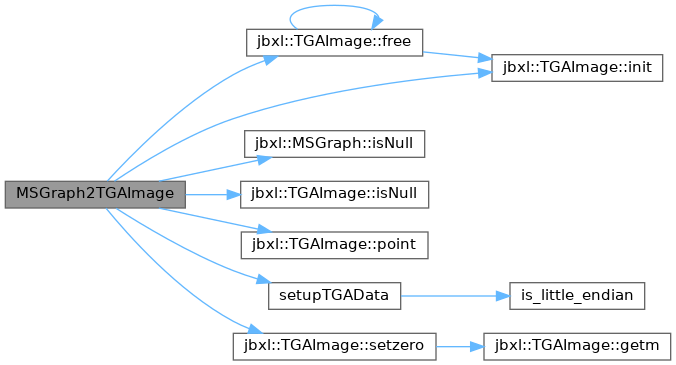
◆ MSGraph_Box()
| void MSGraph_Box | ( | MSGraph< T > | vp, |
| int | x1, | ||
| int | y1, | ||
| int | x2, | ||
| int | y2, | ||
| int | cc, | ||
| int | mode = OFF ) |
template <typename T> void MSGraph_Box(MSGraph<T> vp, int x1, int y1, int x2, int y2, int cc, int mode=OFF)
点(x1,y1)-(x2,y2)を対角とした四角形を描く.線の濃度は cc.
modeが 1以上なら,四角形の内部を塗りつぶす.
- Parameters
-
vp 操作対象となるグラフィックデータ構造体. (x1,y1),(x2,y2) 四角形の対角の座標. cc 線の濃度. mode ON なら四角形の内部の vp.zero〜cc-1 をccで塗りつぶす.
- 使用例
- box(vp, 100, 100, 200, 200, 1000, 0); // 100,100),(200,200)を対角とした四角形を描く
Definition at line 1036 of file Graph.h.
References MSGraph_Line(), MSGraph_Paint(), ON, and MSGraph< T >::zero.

◆ MSGraph_changeColor()
| void MSGraph_changeColor | ( | MSGraph< T > | vp, |
| int | f, | ||
| int | t ) |
Definition at line 769 of file Graph.h.
References MSGraph< T >::gp, MSGraph< T >::xs, MSGraph< T >::ys, and MSGraph< T >::zs.
◆ MSGraph_Circle()
| void MSGraph_Circle | ( | MSGraph< T > | vp, |
| int | x, | ||
| int | y, | ||
| int | r, | ||
| int | cc, | ||
| int | mode = OFF ) |
template <typename T> void MSGraph_Circle(MSGraph<T> vp, int x, int y, int r, int cc, int mode=OFF)
2Dの円の描画.点(x,y)を中心に半径rで濃度 ccの円を書く.
- Parameters
-
vp 操作対象となるグラフィックデータ構造体. x,y 円の中心の座標. r 円の半径. cc 線の濃度. mode ON なら円の内部の vp.zero〜cc-1 をccで塗りつぶす.
Definition at line 1160 of file Graph.h.
References MSGraph< T >::gp, MSGraph_Paint(), ON, MSGraph< T >::point(), MSGraph< T >::xs, MSGraph< T >::ys, and MSGraph< T >::zero.
Referenced by MSGraph_Circle3D(), MSGraph_Pool(), and MSGraph_Sphere().


◆ MSGraph_Circle3D()
| void MSGraph_Circle3D | ( | MSGraph< T > | vp, |
| Vector<> | ox, | ||
| Vector<> | ex, | ||
| int | rr, | ||
| int | cc, | ||
| int | mode = OFF ) |
template <typename T> void MSGraph_Circle3D(MSGraph<T> vp, Vector<> ox, Vector<> ex, int rr, int cc, int mode=OFF)
3D円の描画.
- Parameters
-
vp 操作対象となるグラフィックデータ構造体. ox 円の中心の座標ベクトル. ex 円の中心の法線ベクトル. rr 円の半径. cc 線の濃度. mode ON なら円の内部の vp.zero〜cc-1 をccで塗りつぶす.
Definition at line 1263 of file Graph.h.
References MSGraph< T >::free(), MSGraph< T >::gp, Local2World(), MSGraph_Circle(), MSGraph< T >::xs, and MSGraph< T >::ys.
Referenced by MSGraph_Torus(), and wCircle3D().


◆ MSGraph_Line()
| void MSGraph_Line | ( | MSGraph< T > | vp, |
| int | x1, | ||
| int | y1, | ||
| int | x2, | ||
| int | y2, | ||
| int | cc ) |
template <typename T> void MSGraph_Line(MSGraph<T> vp, int x1, int y1, int x2, int y2, int cc)
2Dのラインの描画.点(x1,y1) から点(x2,y2)へ濃度 cc の線を引く.
座標の範囲チェックあり.
- Parameters
-
vp 操作対象となるグラフィックデータ構造体. x1,y1 線の始点の座標. x2,y2 線の終点の座標. cc 線の濃度.
- 使用例
- MSGraph_Line(vp, 100, 200, 300, 300, 200); // (100,200)から(300,300)へ濃度 200の線を引く
Definition at line 939 of file Graph.h.
References MSGraph< T >::point(), and MSGraph< T >::ys.
Referenced by MSGraph_Box(), and MSGraph_Triangle().


◆ MSGraph_Line3D()
| void MSGraph_Line3D | ( | MSGraph< T > | vp, |
| int | x1, | ||
| int | y1, | ||
| int | z1, | ||
| int | x2, | ||
| int | y2, | ||
| int | z2, | ||
| int | cc ) |
template <typename T> void MSGraph_Line3D(MSGraph<T> vp, int x1, int y1, int z1, int x2, int y2, int z2, int cc)
3Dのラインの描画.点(x1,y1,z1)から点(x2,y2,z2)へ濃度 ccの線を引く.
座標の範囲チェックあり.
- Parameters
-
vp 操作対象となるグラフィックデータ構造体. x1,y1,z1 線の始点の座標. x2,y2,z2 線の終点の座標. cc 線の濃度.
Definition at line 1061 of file Graph.h.
References MSGraph< T >::point(), and MSGraph< T >::zs.

◆ MSGraph_Paint()
| int MSGraph_Paint | ( | MSGraph< T > | vp, |
| int | x, | ||
| int | y, | ||
| int | mn, | ||
| int | mx, | ||
| int | cc, | ||
| int | mode = 8 ) |
template <typename T> int MSGraph_Paint(MSGraph<T> vp, int x, int y, int mn, int mx, int cc, int mode=8)
2Dグラフィックの塗りつぶし.
2Dグラフィック vpの点(x,y)から始めて, mn〜mx の輝度値を cc で塗りつぶす.
- Parameters
-
vp グラフィックデータ構造体. x 塗りつぶしを始める点の x座標. y 塗りつぶしを始める点の y座標. mn 塗りつぶされる輝度値の最小値 mx 塗りつぶされる輝度値の最大値. cc 塗りつぶしの輝度値. mode モード. 8:8近傍の塗りつぶし. その他:4近傍の塗りつぶし
- Returns
- 塗りつぶした面積(ピクセル数)
Definition at line 793 of file Graph.h.
References DEBUG_MODE, MSGraph< T >::gp, MSGraph_Paint(), PRINT_MESG, Xabs, MSGraph< T >::xs, and MSGraph< T >::ys.
Referenced by count_object_MSGraph(), Density_Mask(), MSGraph_Box(), MSGraph_Circle(), MSGraph_Paint(), MSGraph_Paint3D(), MSGraph_Triangle(), and object_feature_MSGraph().

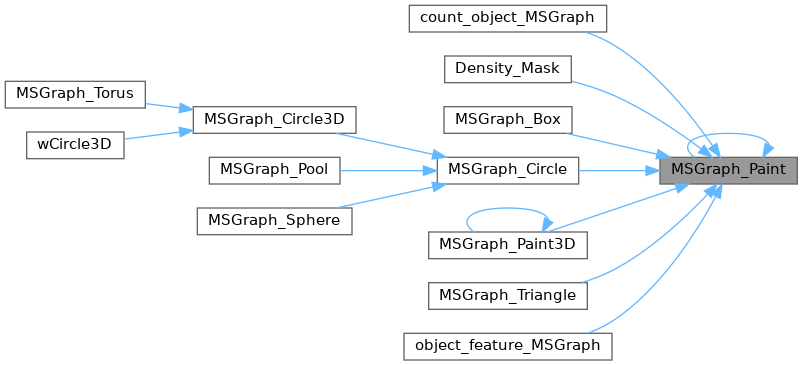
◆ MSGraph_Paint3D()
| int MSGraph_Paint3D | ( | MSGraph< T > | vp, |
| int | x, | ||
| int | y, | ||
| int | z, | ||
| int | mn, | ||
| int | mx, | ||
| int | cc, | ||
| int | mode = 8 ) |
template <typename T> int MSGraph_Paint3D(MSGraph<T> vp, int x, int y, int z, int mn, int mx, int cc, int mode=8)
3Dグラフィックの塗りつぶし.
3Dグラフィック vpの点(x,y,z)から始めて, mn〜mx の輝度値を cc で塗りつぶす.
- Parameters
-
vp グラフィックデータ構造体. x 塗りつぶしを始める点の x座標. y 塗りつぶしを始める点の y座標. z 塗りつぶしを始める点の z座標. mn 塗りつぶされる輝度値の最小値 mx 塗りつぶされる輝度値の最大値. cc 塗りつぶしの輝度値. mode モード.マイナスの場合は途中経過(z)を表示.
+-8:平面上で8近傍の塗りつぶし. その他:平面上で4近傍の塗りつぶし
- Returns
- 塗りつぶした体積(ボクセル数)
Definition at line 883 of file Graph.h.
References DEBUG_MODE, MSGraph< T >::gp, MSGraph_Paint(), MSGraph_Paint3D(), PRINT_MESG, MSGraph< T >::xs, MSGraph< T >::ys, and MSGraph< T >::zs.
Referenced by MSGraph_Paint3D().


◆ MSGraph_Pool()
template <typename T> void MSGraph_Pool(MSGraph<T> vp, Vector<> a, Vector<> b, int rr, int cc)
3D円柱の描画.中身はccで塗りつぶされる.
- Parameters
-
vp 操作対象となるグラフィックデータ構造体. a 円柱上面の円の中心の座標ベクトル. b 円柱底面の円の中心の座標ベクトル. rr 円柱の半径. cc 線と塗りつぶしの濃度.
Definition at line 1288 of file Graph.h.
References MSGraph< T >::free(), MSGraph< T >::gp, Local2World(), MSGraph_Circle(), Vector< T >::n, Vector< T >::norm(), ON, MSGraph< T >::set(), Vector< T >::set(), MSGraph< T >::xs, MSGraph< T >::ys, and MSGraph< T >::zs.
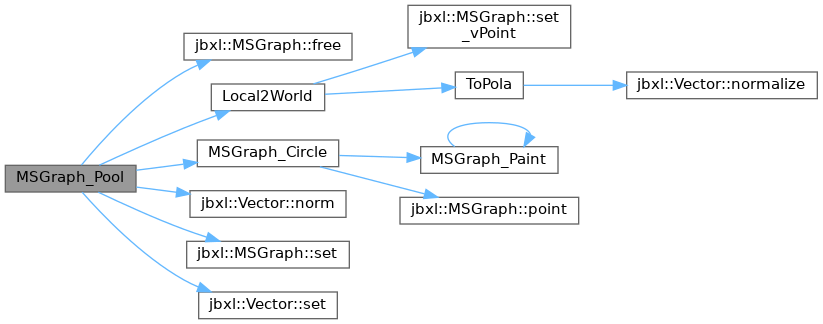
◆ MSGraph_Sphere()
| void MSGraph_Sphere | ( | MSGraph< T > | vp, |
| Vector<> | a, | ||
| int | r, | ||
| int | cc, | ||
| int | mode = 1 ) |
template <typename T> void MSGraph_Sphere(MSGraph<T> vp, Vector<> a, int r, int cc, int mode=1)
球の描画.境界チェックあり.
- Parameters
-
vp 操作対象となるグラフィックデータ構造体. a 球の中心の座標ベクトル. r 球の半径. cc 線と塗りつぶしの濃度(mode=1のとき) mode モード.
1: 円を重ねて球を作る.中身はccで塗りつぶされる.それぞれの円の中心が,領域内にないと塗りつぶしに失敗する.
-1: 極座標で球を作る.vpとの境界に壁を作る.set_vPoint()を使用.
それ以外: 極座標で球を作る.set_vPoint()を使用.
Definition at line 1373 of file Graph.h.
References MSGraph< T >::gp, MSGraph_Circle(), ON, PI, MSGraph< T >::set_vPoint(), Vector< T >::x, MSGraph< T >::xs, Vector< T >::y, MSGraph< T >::ys, Vector< T >::z, and MSGraph< T >::zs.

◆ MSGraph_Torus()
| void MSGraph_Torus | ( | MSGraph< T > | vp, |
| Vector<> | ox, | ||
| Vector<> | ex, | ||
| int | rr, | ||
| int | ra, | ||
| int | cc ) |
template <typename T>
void MSGraph_Torus(MSGraph<T> vp, Vector<> ox, Vector<> ex, int rr, int ra, int cc)
3Dトーラスの描画.中身はccで塗りつぶされる.
- Parameters
-
vp 操作対象となるグラフィックデータ構造体. ox トーラスの中心の座標ベクトル. ex トーラスの中心の法線ベクトル. rr トーラスの半径(トーラスの中心から断面の円の中心まで). ra トーラスの断面の円の半径 cc 線と塗りつぶしの濃度.
Definition at line 1327 of file Graph.h.
References MSGraph< T >::free(), MSGraph< T >::gp, Local2World(), MSGraph_Circle3D(), ON, PI, MSGraph< T >::set(), Vector< T >::set(), MSGraph< T >::xs, MSGraph< T >::ys, and MSGraph< T >::zs.

◆ MSGraph_Triangle()
| void MSGraph_Triangle | ( | MSGraph< T > | vp, |
| int | x1, | ||
| int | y1, | ||
| int | x2, | ||
| int | y2, | ||
| int | x3, | ||
| int | y3, | ||
| int | cc, | ||
| int | mode = OFF ) |
template <typename T> void MSGraph_Triangle(MSGraph<T> vp, int x1, int y1, int x2, int y2, int x3, int y3, int cc, int mode=OFF)
2Dの三角形の描画.
点(x1,y1),(x2,y2),(x3,y3)の三点を頂点とした三角形を描く.
線の濃度は cc. modeが 1以上なら,三角形の内部を塗りつぶす.
- Parameters
-
vp 操作対象となるグラフィックデータ構造体. x1,y1 三角形の頂点1の座標. x2,y2 三角形の頂点2の座標. x3,y3 三角形の頂点3の座標. cc 線の濃度. mode ON なら三角形の内部の vp.zero〜cc-1 をccで塗りつぶす.
- 使用例
- // (100,100),(100,200),(200,100)を頂点とした三角形(直角三角形)を描き,内部を塗りつぶすtriangle(vp, 100, 100, 100, 200, 200, 100, 1000, 1);
Definition at line 1007 of file Graph.h.
References MSGraph_Line(), MSGraph_Paint(), ON, and MSGraph< T >::zero.

◆ MSMaskFilter()
| MSGraph< R > MSMaskFilter | ( | MSGraph< R > | vp, |
| MSGraph< T > | filter, | ||
| int | mode = FILTER_NON ) |
Definition at line 988 of file Gmt.h.
References DEBUG_MODE, FILTER_ABS, FILTER_MINMAX, FILTER_NORM, MSGraph< T >::get_minmax(), MSGraph< T >::gp, JBXL_GRAPH_NODATA_ERROR, MSGraph< T >::max, MSGraph< T >::mimicry(), MSGraph< T >::min, MSGraph< T >::norm, MSGraph< T >::point(), PRINT_MESG, MSGraph< T >::state, MSGraph< T >::xs, MSGraph< T >::ys, and MSGraph< T >::zs.

◆ Nabla()
template <typename R, typename T> MSGraph<R> Nabla(MSGraph<T> vp)
グラフィックデータの ナブラの絶対値を計算する(Sobel).
- Parameters
-
vp 計算対象となるグラフィックデータ構造体.
- Returns
- ナブラ.スカラ型グラフィックデータ.
Definition at line 707 of file Gmt.h.
References DEBUG_MODE, MSGraph< T >::free(), MSGraph< T >::gp, MSGraph< T >::isNull(), JBXL_GRAPH_MEMORY_ERROR, MSGraph< T >::mimicry(), PRINT_MESG, MSGraph< T >::state, MSGraph< T >::xs, MSGraph< T >::ys, and MSGraph< T >::zs.

◆ newAffineTrans()
|
inline |
Definition at line 151 of file AffineTrans.h.
References AffineTrans< T >::dup().

◆ NewellMethod()
|
inline |
Definition at line 288 of file Vector.h.
References Vector< T >::c, Min, Vector< T >::n, Vector< T >::x, Vector< T >::y, and Vector< T >::z.
Referenced by ContourTriData::ComputeTriNormal(), TriPolygonData::ComputeTriNormal(), and NewellMethod3().
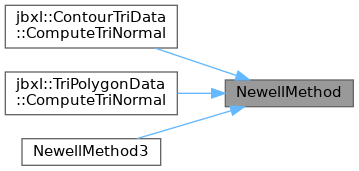
◆ NewellMethod3()
|
inline |
Definition at line 303 of file Vector.h.
References NewellMethod().

◆ NewellMethod4()
|
inline |
Definition at line 309 of file Vector.h.
References Vector< T >::c, Min, Vector< T >::n, Vector< T >::x, Vector< T >::y, and Vector< T >::z.
◆ newMaterialParam()
|
inline |
Definition at line 243 of file MaterialParam.h.
References MaterialParam::dup().

◆ nonZeroBoxel()
| int nonZeroBoxel | ( | MSGraph< T > | vp, |
| int | n ) |
Definition at line 216 of file Thinning.h.
References MSGraph< T >::gp, MSGraph< T >::xs, and MSGraph< T >::ys.
Referenced by centerLine().

◆ object_feature_MSGraph()
template <typename T> Vector<double> object_feature_MSGraph(MSGraph<T> vp, int mn, int mx)
2D画像において,mn〜mxの輝度値のオブジェクトの分散度(円形度の逆数)を計算する.
穴空きのオブジェクトも計算可能.独自アルゴリズム.
- Parameters
-
vp 画像データ mn 輝度値の最小 mx 輝度値の最大
- Return values
-
Vector<double>.x 領域の個数 Vector<double>.y 全面積 Vector<double>.z 分散度
Definition at line 126 of file Graph.h.
References MSGraph< T >::free(), MSGraph< T >::gp, MSGraph< T >::mimicry(), MSGraph_Paint(), Vector< T >::x, MSGraph< T >::xs, MSGraph< T >::ys, MSGraph< T >::zero, and MSGraph< T >::zs.

◆ OctreeGetter()
| long int OctreeGetter | ( | OctreeNode * | p, |
| BREP_VERTEX ** | vtx, | ||
| long int | counter ) |
Definition at line 932 of file Brep.cpp.
References OctreeNode::child, BREP_VERTEX::index, OctreeGetter(), and OctreeNode::vertex.
Referenced by GetOctreeVertices(), and OctreeGetter().


◆ opening_morph()
template <typename T> MSGraph<T> opening_morph(MSGraph<T> vp, MSGraph<T> xp, int cc)
画像vpに対して,エレメントxpで,modeのモルフォロジー演算のオープニングを行う.
元画像は保持される.
- Parameters
-
vp 処理対象の元データ xp エレメント画像 cc 閾値.この輝度値以上の画素に対して演算を行う
- Returns
- 処理結果の画像
Definition at line 75 of file Morph.h.
References copy_morph_element(), MSGraph< T >::gp, MSGraph< T >::isNull(), point_open_morph(), MSGraph< T >::xs, MSGraph< T >::ys, and MSGraph< T >::zs.
Referenced by Morphology().
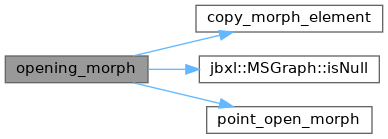

◆ operator!=() [1/5]
|
inline |
Definition at line 109 of file Rotation.h.
References Quaternion< T >::s, Quaternion< T >::x, Quaternion< T >::y, and Quaternion< T >::z.
◆ operator!=() [2/5]
Definition at line 154 of file TVector.h.
References TVector< T >::t, Vector< T >::x, Vector< T >::y, and Vector< T >::z.
◆ operator!=() [3/5]
Definition at line 676 of file Vector.h.
References UVMap< T >::u, and UVMap< T >::v.
◆ operator!=() [4/5]
Definition at line 855 of file Vector.h.
References Vector4< T >::t, Vector4< T >::x, Vector4< T >::y, and Vector4< T >::z.
◆ operator!=() [5/5]
Definition at line 209 of file Vector.h.
References Vector< T >::x, Vector< T >::y, and Vector< T >::z.
◆ operator*() [1/21]
|
inline |
変換の合成:A*B => Bの変換 -> Aの変換
Definition at line 163 of file AffineTrans.h.
References AffineTrans< T >::computeComponents(), AffineTrans< T >::computeMatrix(), and AffineTrans< T >::element().

◆ operator*() [2/21]
template <typename T> Matrix<T> operator * (const Matrix<T> a, const Matrix<T> b)
マトリックスの掛け算.
マトリックス a, bを掛け算して,結果のマトリックスを返す.
- Parameters
-
a 掛けられるマトリックス. b 掛けるマトリックス.
- Returns
- 掛け算結果のマトリックス.掛け算不能,または失敗の場合は空のマトリックス.
Definition at line 285 of file Matrix++.h.
References Matrix< T >::getm(), Matrix< T >::mx, Matrix< T >::n, Matrix< T >::r, and Matrix< T >::sz.

◆ operator*() [3/21]
Definition at line 418 of file Matrix++.h.
References Matrix< T >::mx, Matrix< T >::n, Matrix< T >::r, and Matrix< T >::sz.
◆ operator*() [4/21]
template <typename T> Matrix<T> operator * (const Matrix<T> a, const Matrix<T> b)
マトリックスとベクトルの掛け算.
マトリックス a と 3Dベクトル vを掛け算して,結果のベクトルを返す.
- Parameters
-
a 掛けられるマトリックス. v 掛けるベクトル.
- Returns
- 掛け算結果のベクトル.掛け算不能,または失敗の場合は 0ベクトル.
Definition at line 355 of file Matrix++.h.
References Vector< T >::c, Matrix< T >::free(), Matrix< T >::mx, Vector< T >::x, Vector< T >::y, and Vector< T >::z.

◆ operator*() [5/21]
|
inline |
演算順序 A*B = Bの回転 -> Aの回転
Definition at line 146 of file Rotation.h.
References Quaternion< T >::c, Quaternion< T >::init(), Min, Quaternion< T >::s, Quaternion< T >::set(), Quaternion< T >::x, Quaternion< T >::y, and Quaternion< T >::z.

◆ operator*() [6/21]
|
inline |
Definition at line 135 of file Rotation.h.
References Quaternion< T >::c, Quaternion< T >::n, Quaternion< T >::s, Quaternion< T >::x, Quaternion< T >::y, and Quaternion< T >::z.
◆ operator*() [7/21]
|
inline |
Definition at line 157 of file Rotation.h.
References Quaternion< T >::c, Vector< T >::c, Quaternion< T >::init(), Min, Vector< T >::n, Quaternion< T >::s, Quaternion< T >::set(), Quaternion< T >::x, Vector< T >::x, Quaternion< T >::y, Vector< T >::y, Quaternion< T >::z, and Vector< T >::z.

◆ operator*() [8/21]
Definition at line 409 of file Matrix++.h.
References Matrix< T >::mx, Matrix< T >::n, Matrix< T >::r, and Matrix< T >::sz.
◆ operator*() [9/21]
|
inline |
Definition at line 131 of file Rotation.h.
References Quaternion< T >::c, Quaternion< T >::n, Quaternion< T >::s, Quaternion< T >::x, Quaternion< T >::y, and Quaternion< T >::z.
◆ operator*() [10/21]
|
inline |
Definition at line 129 of file TVector.h.
References TVector< T >::t, Vector< T >::x, Xabs, Vector< T >::y, and Vector< T >::z.
◆ operator*() [11/21]
Definition at line 656 of file Vector.h.
References UVMap< T >::d, UVMap< T >::u, and UVMap< T >::v.
◆ operator*() [12/21]
|
inline |
Definition at line 815 of file Vector.h.
References Vector4< T >::c, Vector4< T >::d, Vector4< T >::n, Vector4< T >::t, Vector4< T >::x, Vector4< T >::y, and Vector4< T >::z.
◆ operator*() [13/21]
Definition at line 160 of file Vector.h.
References Vector< T >::c, Vector< T >::d, Vector< T >::n, Vector< T >::x, Vector< T >::y, and Vector< T >::z.
◆ operator*() [14/21]
|
inline |
Definition at line 133 of file TVector.h.
References TVector< T >::t, Vector< T >::x, Xabs, Vector< T >::y, and Vector< T >::z.
◆ operator*() [15/21]
Definition at line 178 of file TVector.h.
References Vector< T >::x, Vector< T >::y, and Vector< T >::z.
◆ operator*() [16/21]
Definition at line 660 of file Vector.h.
References UVMap< T >::d, UVMap< T >::u, and UVMap< T >::v.
◆ operator*() [17/21]
|
inline |
Definition at line 819 of file Vector.h.
References Vector4< T >::c, Vector4< T >::d, Vector4< T >::n, Vector4< T >::t, Vector4< T >::x, Vector4< T >::y, and Vector4< T >::z.
◆ operator*() [18/21]
Definition at line 847 of file Vector.h.
References Vector4< T >::t, Vector4< T >::x, Vector4< T >::y, and Vector4< T >::z.
◆ operator*() [19/21]
Definition at line 164 of file Vector.h.
References Vector< T >::c, Vector< T >::d, Vector< T >::n, Vector< T >::x, Vector< T >::y, and Vector< T >::z.
◆ operator*() [20/21]
Definition at line 201 of file Vector.h.
References Vector< T >::x, Vector< T >::y, and Vector< T >::z.
◆ operator*() [21/21]
|
inline |
Definition at line 168 of file Rotation.h.
References Quaternion< T >::c, Vector< T >::c, Quaternion< T >::init(), Min, Vector< T >::n, Quaternion< T >::s, Quaternion< T >::set(), Quaternion< T >::x, Vector< T >::x, Quaternion< T >::y, Vector< T >::y, Quaternion< T >::z, and Vector< T >::z.

◆ operator+() [1/14]
Definition at line 386 of file Matrix++.h.
References Matrix< T >::getm(), isSameDimension(), Matrix< T >::mx, Matrix< T >::n, Matrix< T >::r, and Matrix< T >::sz.

◆ operator+() [2/14]
|
inline |
Definition at line 123 of file Rotation.h.
References Quaternion< T >::c, Min, Quaternion< T >::s, Quaternion< T >::x, Quaternion< T >::y, and Quaternion< T >::z.
◆ operator+() [3/14]
Definition at line 640 of file Vector.h.
References UVMap< T >::d, UVMap< T >::u, and UVMap< T >::v.
◆ operator+() [4/14]
Definition at line 799 of file Vector.h.
References Vector4< T >::c, Vector4< T >::d, Vector4< T >::t, Vector4< T >::x, Vector4< T >::y, and Vector4< T >::z.
◆ operator+() [5/14]
Definition at line 144 of file Vector.h.
References Vector< T >::c, Vector< T >::d, Vector< T >::x, Vector< T >::y, and Vector< T >::z.
◆ operator+() [6/14]
|
inline |
Definition at line 100 of file TVector.h.
References TVector< T >::t, Vector< T >::x, Vector< T >::y, and Vector< T >::z.
◆ operator+() [7/14]
|
inline |
Definition at line 104 of file TVector.h.
References TVector< T >::t, Vector< T >::x, Vector< T >::y, and Vector< T >::z.
◆ operator+() [8/14]
Definition at line 87 of file TVector.h.
References TVector< T >::t, Vector< T >::x, Xabs, Vector< T >::y, and Vector< T >::z.
◆ operator+() [9/14]
Definition at line 632 of file Vector.h.
References UVMap< T >::d, UVMap< T >::u, and UVMap< T >::v.
◆ operator+() [10/14]
Definition at line 636 of file Vector.h.
References UVMap< T >::d, UVMap< T >::u, and UVMap< T >::v.
◆ operator+() [11/14]
Definition at line 791 of file Vector.h.
References Vector4< T >::c, Vector4< T >::d, Min, Vector4< T >::t, Vector4< T >::x, Vector4< T >::y, and Vector4< T >::z.
◆ operator+() [12/14]
Definition at line 795 of file Vector.h.
References Vector4< T >::c, Vector4< T >::d, Vector4< T >::t, Vector4< T >::x, Vector4< T >::y, and Vector4< T >::z.
◆ operator+() [13/14]
Definition at line 136 of file Vector.h.
References Vector< T >::c, Vector< T >::d, Min, Vector< T >::x, Vector< T >::y, and Vector< T >::z.
◆ operator+() [14/14]
Definition at line 140 of file Vector.h.
References Vector< T >::c, Vector< T >::d, Vector< T >::x, Vector< T >::y, and Vector< T >::z.
◆ operator+=() [1/6]
◆ operator+=() [2/6]
◆ operator+=() [3/6]
◆ operator+=() [4/6]
◆ operator+=() [5/6]
◆ operator+=() [6/6]
◆ operator-() [1/20]
Definition at line 378 of file Matrix++.h.
References Matrix< T >::mx, Matrix< T >::n, Matrix< T >::r, and Matrix< T >::sz.
◆ operator-() [2/20]
Definition at line 397 of file Matrix++.h.
References Matrix< T >::getm(), isSameDimension(), Matrix< T >::mx, Matrix< T >::n, Matrix< T >::r, and Matrix< T >::sz.

◆ operator-() [3/20]
|
inline |
Definition at line 119 of file Rotation.h.
References Quaternion< T >::c, Quaternion< T >::n, Quaternion< T >::s, Quaternion< T >::x, Quaternion< T >::y, and Quaternion< T >::z.
◆ operator-() [4/20]
|
inline |
Definition at line 127 of file Rotation.h.
References Quaternion< T >::c, Min, Quaternion< T >::s, Quaternion< T >::x, Quaternion< T >::y, and Quaternion< T >::z.
◆ operator-() [5/20]
Definition at line 652 of file Vector.h.
References UVMap< T >::d, UVMap< T >::u, and UVMap< T >::v.
◆ operator-() [6/20]
|
inline |
Definition at line 121 of file TVector.h.
References TVector< T >::t, Vector< T >::x, Vector< T >::y, and Vector< T >::z.
◆ operator-() [7/20]
Definition at line 83 of file TVector.h.
References Vector< T >::n, TVector< T >::t, Vector< T >::x, Vector< T >::y, and Vector< T >::z.
◆ operator-() [8/20]
|
inline |
Definition at line 125 of file TVector.h.
References TVector< T >::t, Vector< T >::x, Vector< T >::y, and Vector< T >::z.
◆ operator-() [9/20]
Definition at line 108 of file TVector.h.
References TVector< T >::t, Vector< T >::x, Xabs, Vector< T >::y, and Vector< T >::z.
◆ operator-() [10/20]
Definition at line 628 of file Vector.h.
References UVMap< T >::d, UVMap< T >::u, and UVMap< T >::v.
◆ operator-() [11/20]
Definition at line 644 of file Vector.h.
References UVMap< T >::d, UVMap< T >::u, and UVMap< T >::v.
◆ operator-() [12/20]
Definition at line 648 of file Vector.h.
References UVMap< T >::d, UVMap< T >::u, and UVMap< T >::v.
◆ operator-() [13/20]
Definition at line 787 of file Vector.h.
References Vector4< T >::c, Vector4< T >::d, Vector4< T >::n, Vector4< T >::t, Vector4< T >::x, Vector4< T >::y, and Vector4< T >::z.
◆ operator-() [14/20]
Definition at line 803 of file Vector.h.
References Vector4< T >::c, Vector4< T >::d, Min, Vector4< T >::t, Vector4< T >::x, Vector4< T >::y, and Vector4< T >::z.
◆ operator-() [15/20]
Definition at line 807 of file Vector.h.
References Vector4< T >::c, Vector4< T >::d, Vector4< T >::t, Vector4< T >::x, Vector4< T >::y, and Vector4< T >::z.
◆ operator-() [16/20]
Definition at line 132 of file Vector.h.
References Vector< T >::c, Vector< T >::d, Vector< T >::n, Vector< T >::x, Vector< T >::y, and Vector< T >::z.
◆ operator-() [17/20]
Definition at line 148 of file Vector.h.
References Vector< T >::c, Vector< T >::d, Min, Vector< T >::x, Vector< T >::y, and Vector< T >::z.
◆ operator-() [18/20]
Definition at line 152 of file Vector.h.
References Vector< T >::c, Vector< T >::d, Vector< T >::x, Vector< T >::y, and Vector< T >::z.
◆ operator-() [19/20]
Definition at line 811 of file Vector.h.
References Vector4< T >::c, Vector4< T >::d, Vector4< T >::t, Vector4< T >::x, Vector4< T >::y, and Vector4< T >::z.
◆ operator-() [20/20]
Definition at line 156 of file Vector.h.
References Vector< T >::c, Vector< T >::d, Vector< T >::x, Vector< T >::y, and Vector< T >::z.
◆ operator-=() [1/6]
◆ operator-=() [2/6]
◆ operator-=() [3/6]
◆ operator-=() [4/6]
◆ operator-=() [5/6]
◆ operator-=() [6/6]
◆ operator/() [1/10]
Definition at line 427 of file Matrix++.h.
References Matrix< T >::mx, Matrix< T >::n, Matrix< T >::r, and Matrix< T >::sz.
◆ operator/() [2/10]
|
inline |
Definition at line 139 of file Rotation.h.
References Quaternion< T >::c, Quaternion< T >::n, Quaternion< T >::s, Quaternion< T >::x, Quaternion< T >::y, and Quaternion< T >::z.
◆ operator/() [3/10]
|
inline |
Definition at line 141 of file TVector.h.
References Vector< T >::norm2(), TVector< T >::t, Vector< T >::x, Xabs, Vector< T >::y, and Vector< T >::z.

◆ operator/() [4/10]
Definition at line 668 of file Vector.h.
References UVMap< T >::d, UVMap< T >::u, and UVMap< T >::v.
◆ operator/() [5/10]
|
inline |
Definition at line 827 of file Vector.h.
References Vector4< T >::c, Vector4< T >::d, Vector4< T >::t, Vector4< T >::x, Vector4< T >::y, and Vector4< T >::z.
◆ operator/() [6/10]
Definition at line 172 of file Vector.h.
References Vector< T >::c, Vector< T >::d, Vector< T >::x, Vector< T >::y, and Vector< T >::z.
◆ operator/() [7/10]
|
inline |
Definition at line 137 of file TVector.h.
References TVector< T >::t, Vector< T >::x, Xabs, Vector< T >::y, and Vector< T >::z.
◆ operator/() [8/10]
Definition at line 664 of file Vector.h.
References UVMap< T >::d, UVMap< T >::u, and UVMap< T >::v.
◆ operator/() [9/10]
|
inline |
Definition at line 823 of file Vector.h.
References Vector4< T >::c, Vector4< T >::d, Vector4< T >::n, Vector4< T >::t, Vector4< T >::x, Vector4< T >::y, and Vector4< T >::z.
◆ operator/() [10/10]
Definition at line 168 of file Vector.h.
References Vector< T >::c, Vector< T >::d, Vector< T >::n, Vector< T >::x, Vector< T >::y, and Vector< T >::z.
◆ operator<() [1/2]
Definition at line 872 of file Vector.h.
References Vector4< T >::t, Vector4< T >::x, Vector4< T >::y, and Vector4< T >::z.
◆ operator<() [2/2]
◆ operator==() [1/6]
Definition at line 435 of file Matrix++.h.
References isSameDimension(), Matrix< T >::mx, and Matrix< T >::r.

◆ operator==() [2/6]
|
inline |
Definition at line 105 of file Rotation.h.
References Quaternion< T >::s, Quaternion< T >::x, Quaternion< T >::y, and Quaternion< T >::z.
◆ operator==() [3/6]
Definition at line 145 of file TVector.h.
References TVector< T >::t, Vector< T >::x, Vector< T >::y, and Vector< T >::z.
◆ operator==() [4/6]
Definition at line 672 of file Vector.h.
References UVMap< T >::u, and UVMap< T >::v.
◆ operator==() [5/6]
Definition at line 851 of file Vector.h.
References Vector4< T >::t, Vector4< T >::x, Vector4< T >::y, and Vector4< T >::z.
◆ operator==() [6/6]
Definition at line 205 of file Vector.h.
References Vector< T >::x, Vector< T >::y, and Vector< T >::z.
◆ operator^() [1/2]
Definition at line 164 of file TVector.h.
References Vector< T >::n, TVector< T >::t, Vector< T >::x, Xabs, Vector< T >::y, and Vector< T >::z.
◆ operator^() [2/2]
◆ operator~()
|
inline |
Definition at line 114 of file Rotation.h.
References Quaternion< T >::c, Quaternion< T >::n, Quaternion< T >::s, Quaternion< T >::x, Quaternion< T >::y, and Quaternion< T >::z.
◆ out_around_MSGraph()
| RBound< int > out_around_MSGraph | ( | MSGraph< T > | vp, |
| int | x, | ||
| int | y, | ||
| int | mode = 8 ) |
template <typename T> RBound<int> out_around_MSGraph(MSGraph<T> vp, int x, int y, int mode=8)
2Dグラフィックデータ構造体 vpの(x,y)にあるオブジェクトの周囲長を得る.
- Parameters
-
vp 操作対象となる 2D グラフィックデータ構造体. x,y 情報を得たいオブジェクト内の左上縁(境界)の座標.
または,左上方向のオブジェクト外の座標(この場合,上記の座標を探す)
この座標の左横に情報を得たいオブジェクトの一部が在ってはいけない.mode モード.4: 4近傍探索.その他:8近傍探索.
- Returns
- 境界構造体rb
- Return values
-
rb.xmax オブジェクトの x座標の最大値. rb.xmin オブジェクトの x座標の最小値. rb.ymax オブジェクトの y座標の最大値. rb.ymin オブジェクトの y座標の最小値. rb.zmax 8近傍モード時の斜めの距離の回数. rb.zmin オブジェクトの周囲長.ただし,8近傍モードの場合,斜めの距離も1と数える.
周囲長を rb.zmin + rb.zmax*{sqrt(2.)-1} で計算する場合もある.
- Attention
- 1ドットの長さは 1と数える.
Definition at line 295 of file Graph.h.
References MSGraph< T >::gp, Max, Min, RBound< T >::xmax, RBound< T >::xmin, MSGraph< T >::xs, RBound< T >::ymax, RBound< T >::ymin, MSGraph< T >::ys, MSGraph< T >::zero, RBound< T >::zmax, and RBound< T >::zmin.
◆ PatchupContour()
| DllExport bool PatchupContour | ( | BREP_SHELL * | shell, |
| BREP_VERTEX ** | vert, | ||
| bool | mode ) |
bool jbxl::PatchupContour(BREP_SHELL* shell, BREP_VERTEX** vert, bool mode)
Shellに対して,vert[0]〜vert[2]の三角形Contourを補充する.
- Parameters
-
shell シェルデータへのポインタ [in,out] vert 頂点情報.補填された三角形の頂点情報が追加される. mode true: 多重Edgeを認める. mode false: 多重Edgeを認めない.
Definition at line 487 of file TriBrep.cpp.
References BREP_FACET, BREP_FACET::CloseData(), BREP_SOLID::contours, BREP_SOLID::counter, CreateContourByVertex(), DupEdgeNumber(), FastDeleteFacet(), BREP_VERTEX::forbidden_list, CVCounter::GetUsableCounter(), IsCollisionContours(), BREP_SHELL::solid, and CVCounter::StepIt().
Referenced by FillShortageWings_Near(), and FillShortageWings_Next().
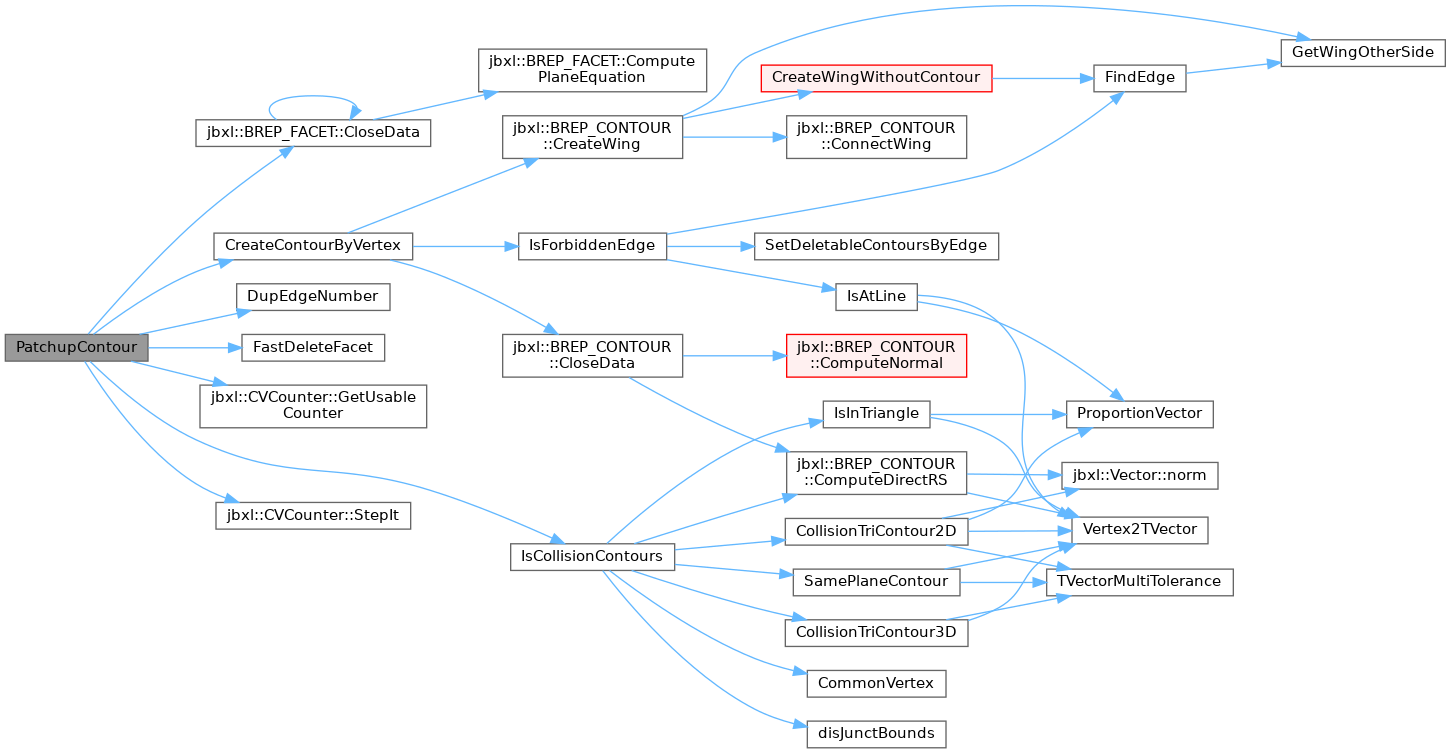

◆ point_fat_object_morph()
| bool point_fat_object_morph | ( | MSGraph< T > | vp, |
| int | x, | ||
| int | y, | ||
| int | z, | ||
| MSGraph< T > | xp, | ||
| int | cc ) |
template <typename T> bool point_fat_object_morph(MSGraph<T> vp, int x, int y, int z, MSGraph<T> xp, int cc)
Definition at line 199 of file Morph.h.
References MSGraph< T >::gp, MSGraph< T >::xs, MSGraph< T >::ys, and MSGraph< T >::zs.
Referenced by fat_object_morph().

◆ point_open_morph()
| bool point_open_morph | ( | MSGraph< T > | vp, |
| int | x, | ||
| int | y, | ||
| int | z, | ||
| MSGraph< T > | xp, | ||
| int | cc ) |
template <typename T> bool point_open_morph(MSGraph<T> vp, int x, int y, int z, MSGraph<T> xp, int cc)
オープニング可能かどうかチェックする.
Definition at line 105 of file Morph.h.
References MSGraph< T >::gp, MSGraph< T >::xs, MSGraph< T >::ys, and MSGraph< T >::zs.
Referenced by opening_morph().

◆ PPPQuaternion()
| Quaternion< T > PPPQuaternion | ( | Vector< T > | a, |
| Vector< T > | b, | ||
| Vector< T > | c ) |
Definition at line 1320 of file Rotation.h.
References Vector< T >::c.
◆ PPVQuaternion()
| Quaternion< T > PPVQuaternion | ( | Vector< T > | a, |
| Vector< T > | b, | ||
| Vector< T > | c ) |
Definition at line 1342 of file Rotation.h.
References Vector< T >::c.
◆ print_Matrix()
| void print_Matrix | ( | FILE * | fp, |
| Matrix< T > | a ) |
template <typename T> void print_Matrix(FILE* fp, Matrix<T> a)
実数マトリックスの要素を標準出力に書き出す.デバッグ用.
- Parameters
-
fp 出力先のファイルディスクリプタ a プリントするマトリックス
Definition at line 236 of file Matrix++.h.
References Matrix< T >::mx, Matrix< T >::n, Matrix< T >::r, and Matrix< T >::sz.
◆ println_FacetAsciiSTL()
| DllExport void println_FacetAsciiSTL | ( | BREP_CONTOUR * | contour | ) |
void jbxl::println_FacetAsciiSTL(BREP_CONTOUR* contour)
contourの情報を STLのアスキー形式で表示する readSTLFileA()で読み込み可
Definition at line 413 of file STL.cpp.
References BREP_WING::next, BREP_CONTOUR::normal, BREP_VERTEX::point, PRINT_MESG, BREP_WING::vertex, BREP_CONTOUR::wing, Vector< T >::x, Vector< T >::y, and Vector< T >::z.
◆ ProportionVector()
template <typename T> double ProportionVector(TVector<T> v1, TVector<T> v2, T& t)
ベクトルv1, v2が一直線上にあるかどうかをチェックする.
v1 = c*v2 の cを返す. tには誤差が入る.
Definition at line 62 of file TVector.h.
References Max, Vector< T >::n, TVector< T >::t, and Zero_Eps.
Referenced by CollisionTriContour2D(), IsAtLine(), and IsInTriangle().

◆ Quaternion2ExtEulerXYZ()
| Vector< T > Quaternion2ExtEulerXYZ | ( | Quaternion< T > | qut, |
| Vector< T > * | vct = NULL ) |
Definition at line 1100 of file Rotation.h.
References Matrix< T >::free(), and Quaternion< T >::getRotMatrix().

◆ Quaternion2ExtEulerXZY()
| Vector< T > Quaternion2ExtEulerXZY | ( | Quaternion< T > | qut, |
| Vector< T > * | vct = NULL ) |
Definition at line 1122 of file Rotation.h.
References Matrix< T >::free(), Quaternion< T >::getRotMatrix(), and RotMatrix2ExtEulerXZY().

◆ Quaternion2ExtEulerYXZ()
| Vector< T > Quaternion2ExtEulerYXZ | ( | Quaternion< T > | qut, |
| Vector< T > * | vct = NULL ) |
Definition at line 1144 of file Rotation.h.
References Matrix< T >::free(), Quaternion< T >::getRotMatrix(), and RotMatrix2ExtEulerYXZ().

◆ Quaternion2ExtEulerYZX()
| Vector< T > Quaternion2ExtEulerYZX | ( | Quaternion< T > | qut, |
| Vector< T > * | vct = NULL ) |
Definition at line 1133 of file Rotation.h.
References Matrix< T >::free(), Quaternion< T >::getRotMatrix(), and RotMatrix2ExtEulerYZX().

◆ Quaternion2ExtEulerZXY()
| Vector< T > Quaternion2ExtEulerZXY | ( | Quaternion< T > | qut, |
| Vector< T > * | vct = NULL ) |
Definition at line 1155 of file Rotation.h.
References Matrix< T >::free(), Quaternion< T >::getRotMatrix(), and RotMatrix2ExtEulerZXY().

◆ Quaternion2ExtEulerZYX()
| Vector< T > Quaternion2ExtEulerZYX | ( | Quaternion< T > | qut, |
| Vector< T > * | vct = NULL ) |
Definition at line 1111 of file Rotation.h.
References Matrix< T >::free(), Quaternion< T >::getRotMatrix(), and RotMatrix2ExtEulerZYX().

◆ readCmnHeadFile()
CmnHead jbxl::readCmnHeadFile(const char* fn, CmnHead* chd, bool cnt=false)
データ種別を chdで指定して,グラフィックデータを読み込み,Common 形式に変換する.
サポートしているデータ形式は,
- Common 形式 : Common 形式にしたがって読み込む.(CT_RGN_SLは未サポート)
- Sun Raster : Common 形式に変換する.ヘッダは RAS_DATA になる
- Moon(CT) : Common 形式に変換する.ヘッダは MOON_DATA になる.
- DICOM : Common 形式に変換する.512x512xZ固定.ヘッダは DICOM_DATAになる.
- USERSET_DATA : CmnHead* chd でヘッダ情報を指定して,読み込みを行う.ヘッダは USERSET_DATAになる.
- Jpeg : Common 形式に変換する.ヘッダは JPEG_RGB_DATAになる.ただしモノクロJPEGの場合は JPEG_MONO_DATA
- Tiff : 未サポート.Common 形式に変換する.ヘッダは TIFF_DATAになる.
- Parameters
-
fn 読み込むを行うファイル名. [in,out] chd ファイルのヘッダ情報を入れる. cnt 仮想カウンタを使用するか?
- Returns
- 読み込んだグラフィックデータを記述する共通ヘッダ.
エラーなら kind = HEADER_NONE となる.またエラーの種類により xsizeが変化する.
- Return values
-
JBXL_GRAPH_OPFILE_ERROR xsize ファイルオープンエラー. JBXL_GRAPH_MEMORY_ERROR xsize メモリエラー. JBXL_GRAPH_CANCEL xsize キャンセル by ユーザ
- Bug
- Common形式の画素深度が 24,32bitの場合のエンディアン処理が未実装
Definition at line 1314 of file Gio.cpp.
References CTHead::anydata, CmnHead::bsize, CmnHead::buf, checkBit, DEBUG_MODE, CmnHead::depth, DICOM_DATA, CmnHead::entry, file_size(), free_CmnHead(), GetUsableGlobalCounter(), MSGraph< T >::gp, CmnHead::grptr, HAS_LENDIAN, HAS_RZXY, HEADER_NONE, is_little_endian(), CVCounter::isCanceled(), JBXL_FILE_READ_ERROR, JBXL_GRAPH_CANCEL, JBXL_GRAPH_HEADER_ERROR, JBXL_GRAPH_MEMORY_ERROR, JBXL_GRAPH_NOFILE_ERROR, JBXL_GRAPH_OPFILE_ERROR, JPEG_MONO_DATA, JPEG_RGB_DATA, CmnHead::kind, CmnHead::lsize, MOON_DATA, ntoh_ar, ntoh_st, PRINT_MESG, CVCounter::PutFill(), RAS_DATA, readDicomData(), readMoonData(), readRasData(), readUserSetData(), MSGraph< T >::RZxy, RZXY_RATE, CVCounter::SetMax(), CVCounter::SetPos(), CVCounter::StepIt(), UN_KNOWN_DATA, USERSET_DATA, MSGraph< T >::xs, CTHead::xsize, CmnHead::xsize, MSGraph< T >::ys, CTHead::ysize, CmnHead::ysize, MSGraph< T >::zs, and CmnHead::zsize.
Referenced by readGraphicSlices().


◆ readDicomData()
Definition at line 654 of file Gio.cpp.
References dicomHeader(), MSGraph< T >::gp, JBXL_FILE_READ_ERROR, JBXL_GRAPH_HEADER_ERROR, MSGraph< T >::set(), and MSGraph< T >::xs.
Referenced by readCmnHeadFile(), readDicomFile(), and readXHeadFile().


◆ readDicomFile()
MSGraph<sWord> jbxl::readDicomFile(const char* fn)
DICOM形式のデータを読み込む.
- Attention
- 現在はまだ限定的な機能しか持たない.
- Bug
- depth = 16bit 固定
Definition at line 628 of file Gio.cpp.
References file_size(), JBXL_GRAPH_NOFILE_ERROR, JBXL_GRAPH_OPFILE_ERROR, readDicomData(), and MSGraph< T >::xs.

◆ readGraphicFile()
| MSGraph< T > readGraphicFile | ( | const char * | fname, |
| CmnHead * | chd = NULL, | ||
| bool | cnt = false ) |
template <typename T> MSGraph<T> readGraphicFile(const char* fname, CmnHead* chd=NULL, bool cnt=false)
色々なグラフィックファイルを読み込んで,MSGraph<T>に格納.
サポートしているデータ形式は,
- Common 形式 : Common 形式にしたがって読み込む.(CT_RGN_SLは未サポート)
- Sun Raster : Common 形式に変換する.ヘッダは RAS_DATA になる
- Moon(CT) : Common 形式に変換する.ヘッダは MOON_DATA になる.
- USERSET_DATA : CmnHead* chd でヘッダ情報を指定して,読み込みを行う.ヘッダは USERSET_DATAになる.
- DICOM_DATA : DICOM ファイル
- JPEG_RGB_DATA : JPEG ファイル
- JPEG_MONO_DATA : モノクロ JPEG
- unkonwn : ファイルをそのまま,hd->grptrへ読み込む.ヘッダは UN_KNOWN_DATA になる.
ただし,UN_KNOWN_DATAの場合は CmnHaedの hd->kind, hd->lsize, hd->gptr のみ有効.
- Parameters
-
fname 読み込むを行うファイル名. [in] chd USERSET_DATA指定の場合,ファイルのヘッダ情報を入れた CmnHead [out] chd CmnHeadにも格納したい場合は,そのアドレスを指定.
cnt カウンタ(プログレスバー)を使用するかどうか?
- Returns
- 読み込んだグラフィックデータと,それを記述する共通ヘッダ.
エラーなら MSGraph.isNull()が真,または CmnHead.kind = HEADER_NONE となる.
またエラーの種類により MSGraph.stateが変化する.
- Return values
-
JBXL_GRAPH_HEADER_ERROR state ファイルのヘッダ読み取りエラー. JBXL_GRAPH_MEMORY_ERROR state メモリエラー.
- CmnHeadのヘッダ情報 (chd!=NULLのときのみ) chd->kind
- HEADER_NONE: データ読み込み失敗.
- UN_KNOWN_DATA: ヘッダが解析できないのでファイルイメージのまま chd->grptrに格納した.
- chd->kind, chd->lsize, chd->gptrのみ有効.MSGraph<T>.gp は NULL.
- その他: MSGraph<T> に画像データが入る.*chd にはヘッダ情報のみが入る.
- chd->buf, chd->gptr は NULL. CT_DATA, RAS_DATA, CT_3DM など.
- Bug
- Common 形式の画素深度が 24,32bitの場合のエンディアン処理が未実装
Definition at line 169 of file Gio.h.
References MSGraph< T >::base, CH2MG_NORMAL, CVCounter::DeleteChildCounter(), free_CmnHead(), GetUsableGlobalCounter(), MSGraph< T >::gp, CmnHead::grptr, HEADER_NONE, MSGraph< T >::init(), JBXL_GRAPH_HEADER_ERROR, CmnHead::kind, CVCounter::MakeChildCounter(), CVCounter::PutFill(), readXHeadFile(), CVCounter::SetMax(), CVCounter::SetTitle(), MSGraph< T >::state, UN_KNOWN_DATA, MSGraph< T >::xs, CmnHead::xsize, MSGraph< T >::ys, ZeroBase, and MSGraph< T >::zs.
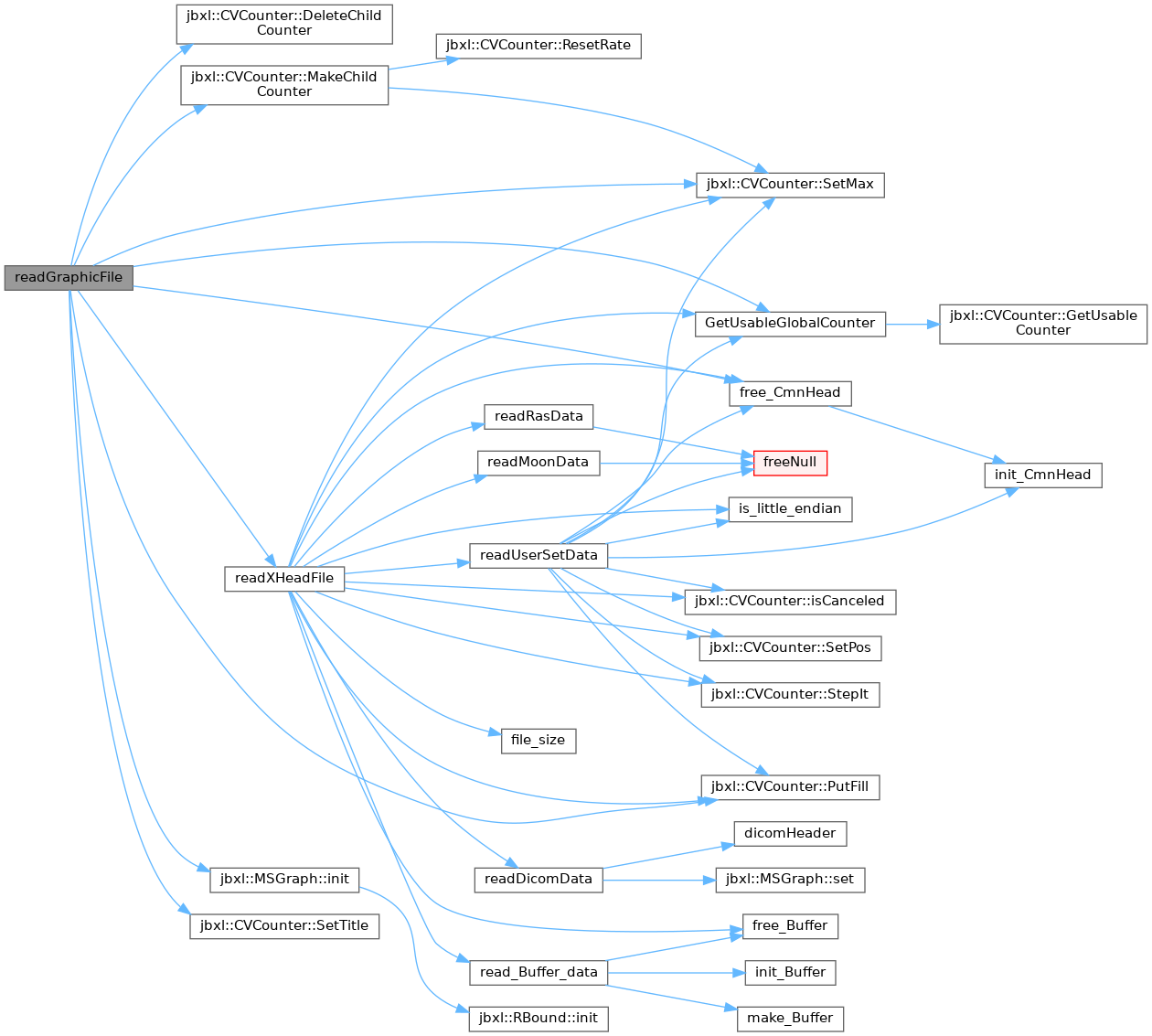
◆ readGraphicSlices()
| MSGraph< T > readGraphicSlices | ( | const char * | fmt, |
| int | fst, | ||
| int | fnd, | ||
| CmnHead * | chd = NULL, | ||
| bool | cnt = false ) |
template <typename T> MSGraph<T> readGraphicSlices(const char* fmt, int fst, int fnd, CmnHead* chd=NULL, bool cnt=false)
色々なグラフィックファイルをスライスデータとして読み込んで,3D画像として MSGraph<T>に格納.また,chd!=NULL ならCommon(CmnHead)形式にも変換する.
Z方向の歪率をサポート(CmnHead, Moon形式のファイルのみ)
グローバルカウンタが使用可能.カウンタによるキャンセル機能を持つ.
readGraphicFile()と殆ど同じ手法を用いているので,その他は readGraphicFile()に準じる.
- Parameters
-
fmt 読み込むを行うファイル名(dなどの入った書式). fst 最初に読み込むファイルの番号(ファイル名の中にその数字がなければならない) fnd 最後に読み込むファイルの番号(ファイル名の中にその数字がなければならない) chd CmnHeadにもデータを格納したい場合はそのアドレスを指定.
または DICOM_DATA, USERSET_DATA指定時のヘッダ情報を格納する.cnt 仮想カウンタを使用するか?
- Returns
- MSGraph型の読み込んだ画像データ
- 例
- MSGraph< T > readGraphicSlices(const char *fmt, int fst, int fnd, CmnHead *chd=NULL, bool cnt=false)Definition Gio.h:258
Definition at line 258 of file Gio.h.
References MSGraph< T >::base, CmnHead::buf, CH2MG_NOPARM, checkBit, MSGraph< T >::color, copyMSGraph2CmnHead(), CT_3DM, CT_DATA, DEBUG_MESG, DEBUG_MODE, CmnHead::depth, DICOM_DATA, MSGraph< T >::free(), free_CmnHead(), freeNull(), getinfo_CmnHead(), MSGraph< T >::getm(), GetUsableGlobalCounter(), MSGraph< T >::gp, GRAPH_COLOR_MONO, GRAPH_COLOR_MONO16, HAS_BASE, HAS_RBOUND, HAS_RZXY, HEADER_NONE, MSGraph< T >::init(), CVCounter::isCanceled(), MSGraph< T >::isNull(), JBXL_GRAPH_CANCEL, JBXL_GRAPH_HEADER_ERROR, JBXL_GRAPH_MEMORY_ERROR, CmnHead::kind, Max, MSGraph< T >::max, Min, MSGraph< T >::min, numbering_name(), PRINT_MESG, CVCounter::PutFill(), MSGraph< T >::rbound, readCmnHeadFile(), readXHead(), MSGraph< T >::RZxy, RZXY_RATE, RBound< T >::set(), CVCounter::SetMax(), CVCounter::SetPos(), CVCounter::SetTitle(), Sign, MSGraph< T >::state, CVCounter::StepIt(), UN_KNOWN_DATA, USERSET_DATA, Xabs, RBound< T >::xmax, RBound< T >::xmin, MSGraph< T >::xs, CmnHead::xsize, RBound< T >::ymax, RBound< T >::ymin, MSGraph< T >::ys, CmnHead::ysize, ZeroBase, RBound< T >::zmax, RBound< T >::zmin, MSGraph< T >::zs, and CmnHead::zsize.
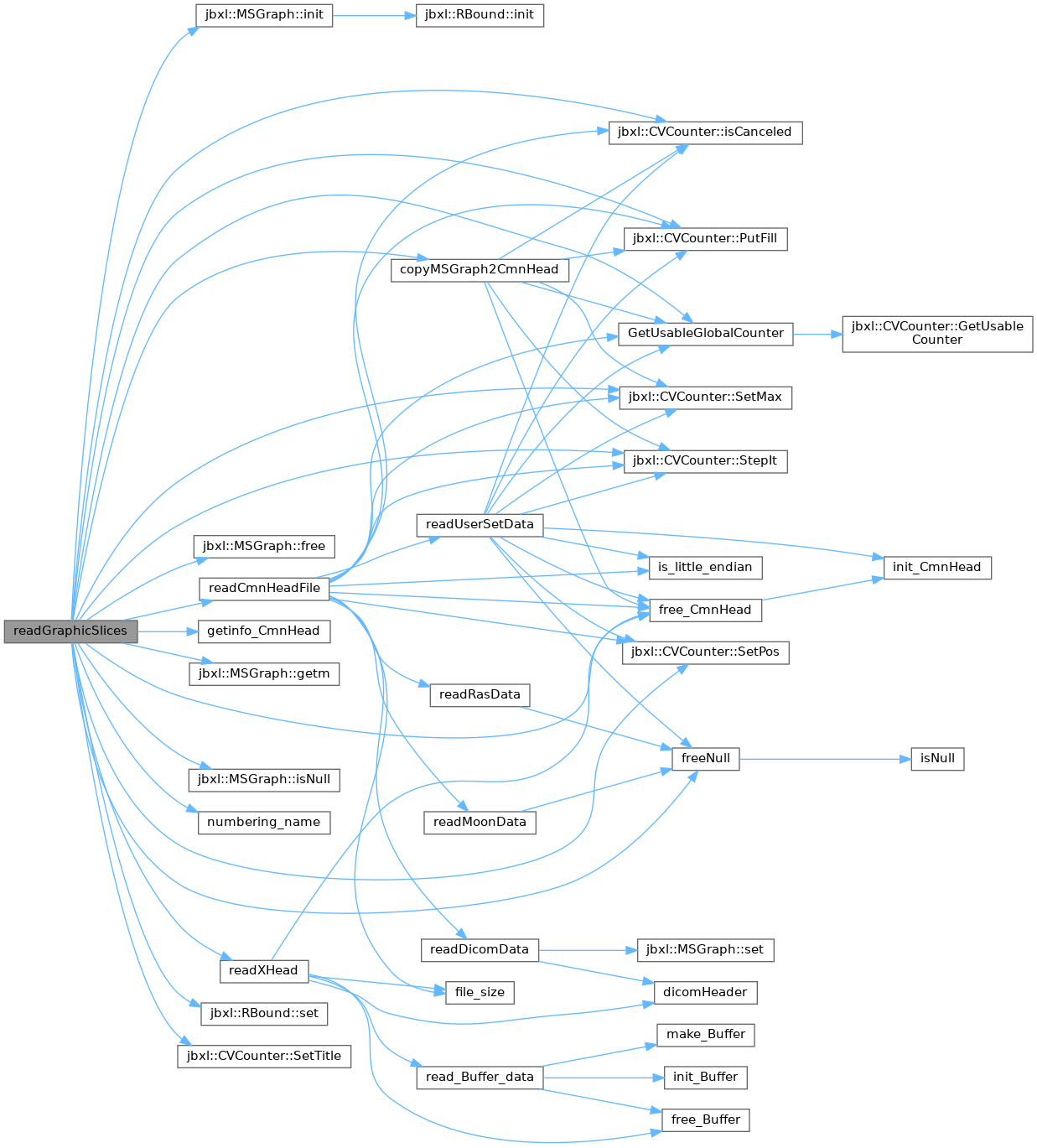
◆ readMoonData()
| CmnHead readMoonData | ( | FILE * | fp, |
| unsigned int | fsz = 0, | ||
| bool | no_ntoh = false ) |
CmnHead jbxl::readMoonData(FILE* fp, unsigned int fsz, bool no_ntoh)
MOON_DATA形式(16bit)のグラフィックファイルを読み込む.
- Parameters
-
fp 読み込むを行うファイルのファイル識別子. fsz ファイルのサイズ(チェックに使用, 0以下ならチェックしない) no_ntoh trueの場合,エンディアンの変換を行わない.
- Returns
- 読み込んだグラフィックデータの共通ヘッダ.
エラー場合 kindメンバは HEADER_NONEとなる.またエラーの種類により xsizeが変化する.
- Return values
-
-2 xsize メモリエラー.
Definition at line 388 of file Gio.cpp.
References CmnHead::bsize, CmnHead::buf, CTHead::cutdown, CTHead::cutleft, CTHead::cutright, CTHead::cutup, CmnHead::depth, freeNull(), CmnHead::grptr, HEADER_NONE, JBXL_FILE_READ_ERROR, JBXL_GRAPH_MEMORY_ERROR, CmnHead::kind, CmnHead::lsize, MOON_DATA, ntoh_st, CTHead::xsize, CmnHead::xsize, CTHead::ysize, CmnHead::ysize, and CmnHead::zsize.
Referenced by readCmnHeadFile(), readMoonFile(), and readXHeadFile().


◆ readMoonFile()
| CmnHead readMoonFile | ( | const char * | fn, |
| bool | no_ntoh = false ) |
CmnHead jbxl::readMoonFile(const char* fn, bool no_ntoh)
MOON_DATA形式(16bit)のグラフィックファイルを読み込む.
- Parameters
-
fn 読み込むを行うファイル名. no_ntoh trueの場合,エンディアンの変換を行わない.
- Returns
- 読み込んだグラフィックデータの共通ヘッダ.
エラー場合 kindメンバは HEADER_NONEとなる.またエラーの種類により xsizeが変化する.
- Return values
-
JBXL_GRAPH_MEMORY_ERROR xsize メモリエラー.
Definition at line 350 of file Gio.cpp.
References file_size(), HEADER_NONE, JBXL_GRAPH_NOFILE_ERROR, JBXL_GRAPH_OPFILE_ERROR, CmnHead::kind, readMoonData(), and CmnHead::xsize.

◆ readRasData()
| CmnHead readRasData | ( | FILE * | fp | ) |
CmnHead jbxl::readRasData(FILE* fp)
SUN RASTER形式のグラフィックファイルを読み込む.
- Parameters
-
fp 読み込むを行うファイルのファイル識別子.
- Returns
- 読み込んだグラフィックデータの共通ヘッダ.エラー場合 kindメンバは HEADER_NONEとなる.
- Return values
-
JBXL_GRAPH_MEMORY_ERROR xsize メモリエラー.
- Bug
- 24ビット以上のエンディアン処理は未実装
Definition at line 30 of file Gio.cpp.
References CmnHead::bsize, CmnHead::buf, CmnHead::depth, freeNull(), CmnHead::grptr, HEADER_NONE, JBXL_FILE_READ_ERROR, JBXL_GRAPH_MEMORY_ERROR, CmnHead::kind, CmnHead::lsize, ntoh_st, RAS_DATA, RasHead::ras_depth, RasHead::ras_height, RasHead::ras_length, RasHead::ras_maplength, RasHead::ras_width, CmnHead::xsize, CmnHead::ysize, and CmnHead::zsize.
Referenced by readCmnHeadFile(), readRasFile(), and readXHeadFile().


◆ readRasFile()
| MSGraph< T > readRasFile | ( | const char * | fname | ) |
template <typename T> MSGraph<T> readRasFile(const char *fname)
Definition at line 583 of file Gio.h.
References CH2MG_NORMAL, MSGraph< T >::init(), and readRasData().

◆ readSTLFile()
STLData* jbxl::readSTLFile(char* fname, unsigned int* fno)
STLファイルを読み込むラッパー関数.アスキー,バイナリを自動判別.
読み込んだファセットの数(fno)を返す.
Definition at line 23 of file STL.cpp.
References DEBUG_MODE, PRINT_MESG, readSTLFileA(), and readSTLFileB().

◆ readSTLFileA()
STLData* jbxl::readSTLFileA(char* fname, long int* fno)
アスキー形式の STLファイルを読み込み,読み込んだファセットの数を返す.
ファイル中の facet, vertex 以外は無視.
Definition at line 112 of file STL.cpp.
References CHAR_TAB, LBUF, PRINT_MESG, and strncasecmp.
Referenced by readSTLFile().

◆ readSTLFileB()
STLData* jbxl::readSTLFileB(char* fname, long int* fno)
バイナリ形式の STLファイルを読み込み,読み込んだファセットの数を返す.
Definition at line 186 of file STL.cpp.
References PRINT_MESG, and STLData::vect.
Referenced by readSTLFile().

◆ readTGAData()
| TGAImage readTGAData | ( | FILE * | fp | ) |
TGAImage jbxl::readTGAData(FILE* fp)
TGAファイルを読み込んで,TGAImage構造体へデータを格納する. 読み込んだデータは非圧縮状態.
- Parameters
-
fp 読み込むファイルの記述子
- Returns
- TGAImage データ.gp==NULL の場合,state に情報が入る.
- Return values
-
JBXL_GRAPH_OPFILE_ERROR state: ファイルオープンエラー JBXL_GRAPH_HEADER_ERROR state: 不正ファイル(TGAファイルでない?) JBXL_GRAPH_MEMORY_ERROR state: メモリエラー JBXL_GRAPH_IVDFMT_ERROR state: サポート外のデータ形式
Definition at line 169 of file TgaTool.cpp.
References TGAImage::col, DEBUG_MODE, FALSE, TGAImage::free(), TGAImage::ft, TGAImage::gp, TGAImage::hd, is_little_endian(), JBXL_FILE_READ_ERROR, JBXL_GRAPH_FILESZ_ERROR, JBXL_GRAPH_IVDFMT_ERROR, JBXL_GRAPH_MEMORY_ERROR, LBUF, TGAImage::length, PRINT_MESG, TGAImage::state, TGA_FOOTER_SIZE, TGA_HEADER_SIZE, TRUE, TGAImage::xs, and TGAImage::ys.
Referenced by readTGAFile().


◆ readTGAFile()
| TGAImage readTGAFile | ( | const char * | fname | ) |
TGAImage jbxl::readTGAFile(const char* fname)
TGAファイルを読み込んで,TGAImage構造体へデータを格納する.
- Parameters
-
fname 読み込むファイル名
- Returns
- TGAImage データ.gp==NULL の場合,state に情報が入る.
- Return values
-
JBXL_GRAPH_OPFILE_ERROR state: ファイルオープンエラー JBXL_GRAPH_HEADER_ERROR state: 不正ファイル(TGAファイルでない?) JBXL_GRAPH_MEMORY_ERROR state: メモリエラー
Definition at line 136 of file TgaTool.cpp.
References TGAImage::gp, JBXL_GRAPH_OPFILE_ERROR, readTGAData(), and TGAImage::state.

◆ readUserSetData()
CmnHead jbxl::readUserSetData(FILE* fp, CmnHead* chd, bool cnt=false);
オペレータ指定のヘッダ形式にしたがってグラフィックファイルを読み込む.
ヘッダ形式のチェック(ファイルサイズの整合性など)は行わないので,それらは呼び出し側の責任となる.
リトルエンディアン対応.カウンタ制御の場合は遅くなる.
- Parameters
-
fp 読み込むを行うファイルのファイル識別子. [in] chd 読み込むファイルのヘッダ情報を入れた CmnHead.
カウンタを使用する場合: kind, xsize, ysize, zsize, bsize 必須.
カウンタを使用しない場合:kind, bsize, lseize 必須.cnt 読み込み状況カウンタを使用するかどうか.true: 使用する.
- Returns
- 読み込んだグラフィックデータの共通ヘッダ.
エラー場合 kindメンバは HEADER_NONEとなる.またエラーの種類により xsizeが変化する.
- Return values
-
JBXL_GRAPH_HEADER_ERROR xsize オペレータ指定のヘッダがない. JBXL_GRAPH_MEMORY_ERROR xsize メモリエラー. JBXL_GRAPH_CANCEL xsize キャンセル.
- Bug
- 24ビット以上のエンディアン処理は未実装
Definition at line 235 of file Gio.cpp.
References CmnHead::bsize, CmnHead::buf, checkBit, CmnHead::depth, free_CmnHead(), freeNull(), GetUsableGlobalCounter(), CmnHead::grptr, HAS_LENDIAN, HEADER_NONE, init_CmnHead(), is_little_endian(), CVCounter::isCanceled(), JBXL_FILE_READ_ERROR, JBXL_GRAPH_CANCEL, JBXL_GRAPH_MEMORY_ERROR, CmnHead::kind, CmnHead::lsize, CVCounter::PutFill(), CVCounter::SetMax(), CVCounter::SetPos(), CVCounter::StepIt(), USERSET_DATA, CmnHead::xsize, CmnHead::ysize, and CmnHead::zsize.
Referenced by readCmnHeadFile(), and readXHeadFile().
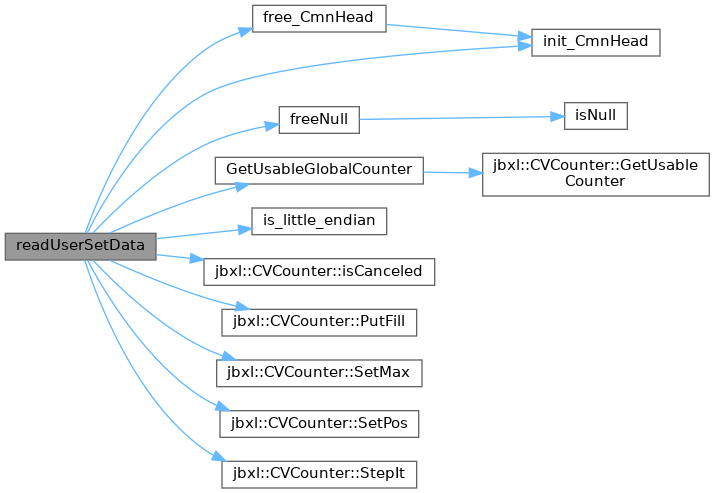

◆ readXHead()
CmnHead jbxl::readXHead(const char* fn, CmnHead* chd)
ファイルの Commonヘッダ情報を読み込む.データ本体は読み込まない. ファイル種別の識別に使用する.
- Parameters
-
fn ヘッダの読み込みを行うファイル名. [out] chd ヘッダ情報を格納する.
- Return values
-
読み込んだグラフィックデータを記述する共通ヘッダ(データ本体は無し).
n エラーなら kind=HEADER_ERROR となる.
Definition at line 708 of file Gio.cpp.
References CTHead::anydata, CmnHead::bsize, CmnHead::buf, CTHead::cutdown, CTHead::cutleft, CTHead::cutright, CTHead::cutup, DEBUG_MODE, CmnHead::depth, DICOM_DATA, dicomHeader(), CmnHead::entry, file_size(), free_Buffer(), free_CmnHead(), CmnHead::grptr, HAS_RZXY, HEADER_NONE, JBXL_FILE_READ_ERROR, JBXL_GRAPH_MEMORY_ERROR, JBXL_GRAPH_NOFILE_ERROR, JBXL_GRAPH_OPFILE_ERROR, JPEG_RGB_DATA, CmnHead::kind, CmnHead::lsize, MOON_DATA, ntoh_ar, ntoh_st, NUM_KDATA, PRINT_MESG, RAS_DATA, RAS_MAGIC, read_Buffer_data(), RZXY_RATE, UN_KNOWN_DATA, USERSET_DATA, CTHead::xsize, CmnHead::xsize, CTHead::ysize, CmnHead::ysize, and CmnHead::zsize.
Referenced by readGraphicSlices().
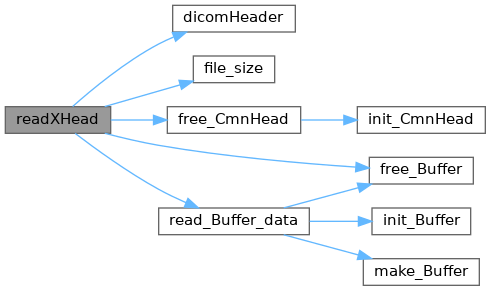

◆ readXHeadFile()
CmnHead jbxl::readXHeadFile(const char* fn, CmnHead* chd, bool cnt=false)
データ種別を自動判定して,グラフィックデータを読み込み,Common 形式に変換する.
USERSET_DATAの場合は chd を指定する.また chdの kind にはオプションの情報も入れられる(現在はエンディアンのみ)
サポートしているデータ形式は,
- Common 形式 : Common 形式にしたがって読み込む.(CT_RGN_SLは未サポート)
- Sun Raster : Common 形式に変換する.ヘッダは RAS_DATA になる
- Moon(CT) : Common 形式に変換する.ヘッダは MOON_DATA になる.
- DICOM : Common 形式に変換する.512x512xZ固定.ヘッダは DICOM_DATAになる.
- USERSET_DATA : CmnHead* chd でヘッダ情報を指定して,読み込みを行う.ヘッダは USERSET_DATAになる.
- Unkonwn : ファイルをそのまま,hd->grptrへ読み込む.ヘッダは UN_KNOWN_DATA になる.
ただし,UN_KNOWN_DATAの場合は CmnHaedの hd->kind, hd->lsize(ファイル長), hd->gptrのみ有効.
- Parameters
-
fn 読み込むを行うファイル名. [in,out] chd USERSET_DATA指定の場合,ファイルのヘッダ情報を入れる.
またはファイルに関するオプション情報も指定できる(現在はエンディアンの情報のみ).cnt 仮想カウンタを使用するか?
- Returns
- 読み込んだグラフィックデータを記述する共通ヘッダ.
エラーなら kind = HEADER_NONE となる.またエラーの種類により xsizeが変化する.
- Return values
-
JBXL_GRAPH_OPFILE_ERROR xsize ファイルオープンエラー. JBXL_GRAPH_MEMORY_ERROR xsize メモリエラー. JBXL_GRAPH_CANCEL xsize キャンセル by ユーザ
- Bug
- Common形式の画素深度が 24,32bitの場合のエンディアン処理が未実装
Definition at line 975 of file Gio.cpp.
References CTHead::anydata, CmnHead::bsize, CmnHead::buf, checkBit, DEBUG_MODE, CmnHead::depth, DICOM_DATA, CmnHead::entry, file_size(), free_Buffer(), free_CmnHead(), GetUsableGlobalCounter(), MSGraph< T >::gp, CmnHead::grptr, HAS_LENDIAN, HAS_RZXY, HEADER_NONE, is_little_endian(), CVCounter::isCanceled(), JBXL_FILE_READ_ERROR, JBXL_GRAPH_CANCEL, JBXL_GRAPH_MEMORY_ERROR, JBXL_GRAPH_NOFILE_ERROR, JBXL_GRAPH_OPFILE_ERROR, JPEG_MONO_DATA, CmnHead::kind, CmnHead::lsize, MOON_DATA, ntoh_ar, ntoh_st, NUM_KDATA, PRINT_MESG, CVCounter::PutFill(), RAS_MAGIC, read_Buffer_data(), readDicomData(), readMoonData(), readRasData(), readUserSetData(), MSGraph< T >::RZxy, RZXY_RATE, CVCounter::SetMax(), CVCounter::SetPos(), CVCounter::StepIt(), UN_KNOWN_DATA, USERSET_DATA, MSGraph< T >::xs, CTHead::xsize, CmnHead::xsize, MSGraph< T >::ys, CTHead::ysize, CmnHead::ysize, MSGraph< T >::zs, and CmnHead::zsize.
Referenced by readGraphicFile().
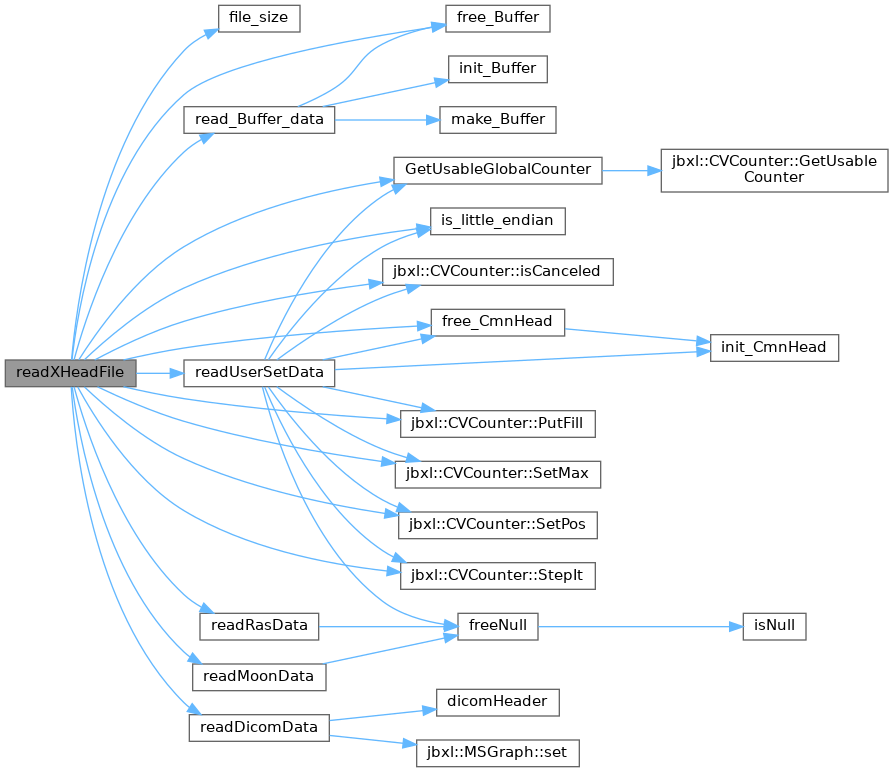

◆ reduce_MSGraph()
Definition at line 1814 of file Graph.h.
References MSGraph< T >::color, MSGraph< T >::gp, MSGraph< T >::init(), MSGraph< T >::isNull(), JBXL_GRAPH_IVDARG_ERROR, JBXL_GRAPH_NODATA_ERROR, ON, MSGraph< T >::point(), MSGraph< T >::set(), MSGraph< T >::state, MSGraph< T >::xs, MSGraph< T >::ys, and MSGraph< T >::zs.

◆ ReverseContours()
| DllExport void ReverseContours | ( | BREP_SOLID * | solid | ) |
void jbxl::ReverseContours(BREP_SOLID* solid)
削除マークの付いたFacet(Contour)を削除し,同じ頂点を持つContourを裏返して登録する. もし,登録した Contourに多重 Edgeがある場合は登録を中止する.
ただし,読み込み(初期)データは削除しない.
Contours List と Wings Listの内容は保障される.
Definition at line 530 of file TriBrep.cpp.
References BREP_FACET, BREP_FACET::CloseData(), CreateContourByVertex(), CreateContoursList(), CreateWingsList(), DupEdgeNumber(), FastDeleteFacet(), BREP_WING::prev, BREP_FACET::shell, BREP_SOLID::shells, and BREP_WING::vertex.
Referenced by DeleteSurplusContours().
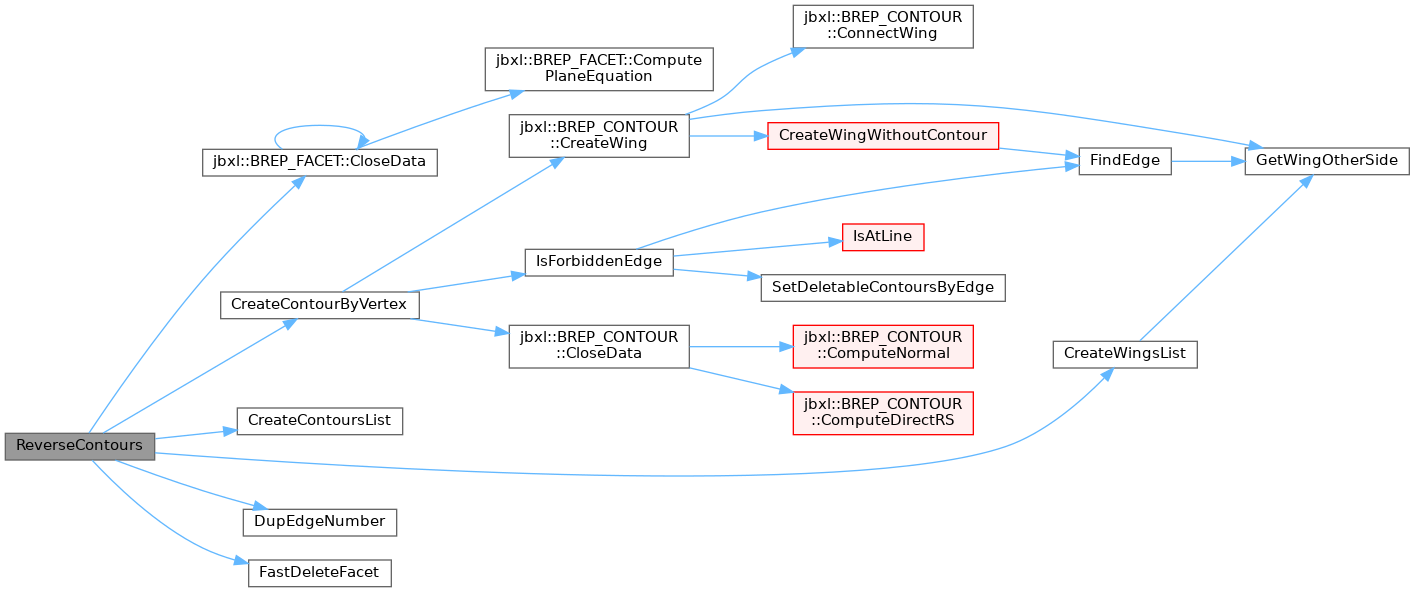

◆ RGB2Word()
Definition at line 1050 of file Gdata.h.
References isLittleEndian, and swap_byte().
Referenced by _linecopy_MAT2MSG_C3().


◆ rotate_MSGraph() [1/2]
Definition at line 1956 of file Graph.h.
References MSGraph< T >::xs, and MSGraph< T >::ys.
◆ rotate_MSGraph() [2/2]
| MSGraph< T > rotate_MSGraph | ( | MSGraph< T > | vp, |
| int | xs, | ||
| int | ys, | ||
| double | cst, | ||
| double | snt, | ||
| int | mode = ON ) |
template <typename T> MSGraph<T> rotate_MSGraph(MSGraph<T> vp, int xs, int ys, double cst, double snt, int mode=ON)
反時計回りに画像を回転させる
Definition at line 1897 of file Graph.h.
References MSGraph< T >::base, MSGraph< T >::color, MSGraph< T >::gp, MSGraph< T >::isNull(), ON, MSGraph< T >::point(), MSGraph< T >::set(), MSGraph< T >::xs, MSGraph< T >::ys, MSGraph< T >::zero, and MSGraph< T >::zs.

◆ rotate_point()
| void rotate_point | ( | int & | x, |
| int & | y, | ||
| double | sxc, | ||
| double | syc, | ||
| double | dxc, | ||
| double | dyc, | ||
| double | cst, | ||
| double | snt ) |
- Parameters
-
[in,out] x in: X座標.out: 回転後のX座標. [in,out] y in: Y座標.out: 回転後のY座標. sxc 回転前の座標の中心の X座標 syc 回転前の座標の中心の Y座標 dxc 回転後の座標の中心の X座標 dyc 回転後の座標の中心の Y座標 cst 回転角 cosθ snt 回転角 sinθ
Definition at line 26 of file Graph.cpp.
Referenced by rotate_point_angle().

◆ rotate_point_angle()
| void rotate_point_angle | ( | int & | x, |
| int & | y, | ||
| double | sxc, | ||
| double | syc, | ||
| double | dxc, | ||
| double | dyc, | ||
| double | th ) |
void jbxl::rotate_point_angle(int& x, int& y, double sxc, double syc, double dxc, double dyc, double th)
- Parameters
-
[in,out] x in: X座標.out: 回転後のX座標. [in,out] y in: Y座標.out: 回転後のY座標. sxc 回転前の座標の中心の X座標 syc 回転前の座標の中心の Y座標 dxc 回転後の座標の中心の X座標 dyc 回転後の座標の中心の Y座標 th 回転角(ラジアン)
Definition at line 52 of file Graph.cpp.
References rotate_point().

◆ RotMatrix2ExtEulerXYZ()
| Vector< T > RotMatrix2ExtEulerXYZ | ( | Matrix< T > | mtx, |
| Vector< T > * | vct = NULL ) |
Definition at line 1000 of file Rotation.h.
References Matrix< T >::element().
Referenced by RotMatrix2Quaternion().


◆ RotMatrix2ExtEulerXZY()
| Vector< T > RotMatrix2ExtEulerXZY | ( | Matrix< T > | mtx, |
| Vector< T > * | vct = NULL ) |
Definition at line 1033 of file Rotation.h.
References Matrix< T >::element().
Referenced by Quaternion2ExtEulerXZY().


◆ RotMatrix2ExtEulerYXZ()
| Vector< T > RotMatrix2ExtEulerYXZ | ( | Matrix< T > | mtx, |
| Vector< T > * | vct = NULL ) |
Definition at line 1065 of file Rotation.h.
References Matrix< T >::element().
Referenced by Quaternion2ExtEulerYXZ().


◆ RotMatrix2ExtEulerYZX()
| Vector< T > RotMatrix2ExtEulerYZX | ( | Matrix< T > | mtx, |
| Vector< T > * | vct = NULL ) |
Definition at line 1049 of file Rotation.h.
References Matrix< T >::element().
Referenced by Quaternion2ExtEulerYZX().


◆ RotMatrix2ExtEulerZXY()
| Vector< T > RotMatrix2ExtEulerZXY | ( | Matrix< T > | mtx, |
| Vector< T > * | vct = NULL ) |
Definition at line 1081 of file Rotation.h.
References Matrix< T >::element().
Referenced by Quaternion2ExtEulerZXY().


◆ RotMatrix2ExtEulerZYX()
Definition at line 1017 of file Rotation.h.
References Matrix< T >::element().
Referenced by Quaternion2ExtEulerZYX().


◆ RotMatrix2Quaternion()
| Quaternion< T > RotMatrix2Quaternion | ( | Matrix< T > | mtx | ) |
Definition at line 1167 of file Rotation.h.
References RotMatrix2ExtEulerXYZ(), and Quaternion< T >::setExtEulerXYZ().

◆ RotMatrixElements2ExtEulerXYZ()
| Vector< T > RotMatrixElements2ExtEulerXYZ | ( | T | m11, |
| T | m12, | ||
| T | m13, | ||
| T | m21, | ||
| T | m31, | ||
| T | m32, | ||
| T | m33, | ||
| Vector< T > * | vct = NULL ) |
Definition at line 656 of file Rotation.h.
References PI, PI_DIV2, Vector< T >::set(), Vector< T >::x, Xabs, Vector< T >::y, Vector< T >::z, and Zero_Eps.

◆ RotMatrixElements2ExtEulerXZY()
| Vector< T > RotMatrixElements2ExtEulerXZY | ( | T | m11, |
| T | m12, | ||
| T | m13, | ||
| T | m21, | ||
| T | m22, | ||
| T | m23, | ||
| T | m31, | ||
| Vector< T > * | vct = NULL ) |
Definition at line 770 of file Rotation.h.
References PI, PI_DIV2, Vector< T >::set(), Vector< T >::x, Xabs, Vector< T >::y, Vector< T >::z, and Zero_Eps.

◆ RotMatrixElements2ExtEulerYXZ()
| Vector< T > RotMatrixElements2ExtEulerYXZ | ( | T | m12, |
| T | m21, | ||
| T | m22, | ||
| T | m23, | ||
| T | m31, | ||
| T | m32, | ||
| T | m33, | ||
| Vector< T > * | vct = NULL ) |
Definition at line 884 of file Rotation.h.
References PI, PI_DIV2, Vector< T >::set(), Vector< T >::x, Xabs, Vector< T >::y, Vector< T >::z, and Zero_Eps.

◆ RotMatrixElements2ExtEulerYZX()
| Vector< T > RotMatrixElements2ExtEulerYZX | ( | T | m11, |
| T | m12, | ||
| T | m13, | ||
| T | m21, | ||
| T | m22, | ||
| T | m31, | ||
| T | m32, | ||
| Vector< T > * | vct = NULL ) |
Definition at line 827 of file Rotation.h.
References PI, PI_DIV2, Vector< T >::set(), Vector< T >::x, Xabs, Vector< T >::y, Vector< T >::z, and Zero_Eps.

◆ RotMatrixElements2ExtEulerZXY()
| Vector< T > RotMatrixElements2ExtEulerZXY | ( | T | m12, |
| T | m13, | ||
| T | m21, | ||
| T | m22, | ||
| T | m23, | ||
| T | m32, | ||
| T | m33, | ||
| Vector< T > * | vct = NULL ) |
Definition at line 941 of file Rotation.h.
References PI, PI_DIV2, Vector< T >::set(), Vector< T >::x, Xabs, Vector< T >::y, Vector< T >::z, and Zero_Eps.

◆ RotMatrixElements2ExtEulerZYX()
| Vector< T > RotMatrixElements2ExtEulerZYX | ( | T | m11, |
| T | m12, | ||
| T | m13, | ||
| T | m21, | ||
| T | m23, | ||
| T | m31, | ||
| T | m33, | ||
| Vector< T > * | vct = NULL ) |
Definition at line 713 of file Rotation.h.
References PI, PI_DIV2, Vector< T >::set(), Vector< T >::x, Xabs, Vector< T >::y, Vector< T >::z, and Zero_Eps.

◆ same_vector() [1/2]
v1, v2 が同じ点かチェックする.信頼度は考慮しない.
Definition at line 888 of file Vector.h.
References Vector4< T >::t, Vector_Tolerance, Vector4< T >::x, Vector4< T >::y, and Vector4< T >::z.
◆ same_vector() [2/2]
v1, v2 が同じ点かチェックする.信頼度は考慮しない.
Definition at line 241 of file Vector.h.
References Vector_Tolerance, Vector< T >::x, Vector< T >::y, and Vector< T >::z.
◆ SamePlaneContour()
| DllExport bool SamePlaneContour | ( | BREP_CONTOUR * | contour1, |
| BREP_CONTOUR * | contour2, | ||
| int & | lineno ) |
Definition at line 1167 of file TriBrep.cpp.
References BREP_CONTOUR::directRS, Max, BREP_WING::next, TVectorMultiTolerance(), BREP_WING::vertex, Vertex2TVector(), BREP_CONTOUR::wing, Xabs, and Zero_Eps.
Referenced by IsCollisionContours().


◆ scalingMSGraph2D()
Definition at line 943 of file Gdata.h.
References MSGraph< T >::color, MSGraph< T >::getm(), MSGraph< T >::gp, MSGraph< T >::point(), MSGraph< T >::set(), MSGraph< T >::xs, MSGraph< T >::ys, and MSGraph< T >::zs.
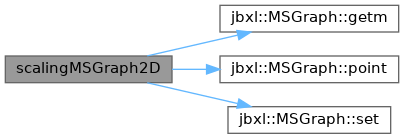
◆ set_around_MSGraph()
| void set_around_MSGraph | ( | MSGraph< T > | vp, |
| int | cc = 0, | ||
| int | size = 1 ) |
template <typename T> void set_around_MSGraph(MSGraph<T> vp, int cc=0, int size=1)
2Dグラフィックデータの縁の部分の輝度値を ccにする.
- Parameters
-
vp 操作対象となるグラフィックデータ構造体. cc データの縁に設定する輝度値. size 縁のサイズ
Definition at line 2030 of file Graph.h.
References MSGraph< T >::gp, MSGraph< T >::xs, and MSGraph< T >::ys.
Referenced by Density_Mask().

◆ SetAbsVectorTolerance()
|
inline |
Definition at line 49 of file Tolerance.h.
References Abs_Vector_Tolerance.
◆ SetAbsVertexTolerance()
|
inline |
Definition at line 50 of file Tolerance.h.
References Abs_Vertex_Tolerance.
◆ SetCollisionTolerance()
|
inline |
Definition at line 47 of file Tolerance.h.
References Collision_Tolerance.
◆ SetDeletableContoursByEdge()
void jbxl::SetDeletableContoursByEdge(BREP_EDGE* edge)
Edgeに関連付けられた Contourに削除可能のマークをつける.削除は行わない.
Definition at line 816 of file TriBrep.cpp.
References BREP_WING::contour, BREP_FACET::deletable, BREP_EDGE::edge_list, BREP_CONTOUR::facet, BREP_EDGE::wing1, and BREP_EDGE::wing2.
Referenced by IsForbiddenEdge().

◆ SetEdgeTolerance()
|
inline |
◆ SetFacetTolerance()
|
inline |
◆ SetGlobalCounter()
|
inline |
Definition at line 192 of file ClassBox.h.
References GLCounter.
Referenced by zzSobel().

◆ SetGlobalDisplay()
|
inline |
◆ SetGlobalFrame()
|
inline |
◆ SetGlobalTextDocument()
|
inline |
◆ SetMinVertex()
| DllExport void SetMinVertex | ( | BREP_VERTEX_LIST * | list, |
| BREP_VERTEX * | vrtx ) |
void jbxl::SetMinVertex(BREP_VERTEX_LIST* list, BREP_VERTEX* vrtx)
Definition at line 445 of file TriBrep.cpp.
References BREP_VERTEX::distance2.
Referenced by FillShortageWings_Near().

◆ SetSINTolerance()
|
inline |
◆ setupTGAData()
| int setupTGAData | ( | TGAImage * | tga, |
| bool | rle ) |
int jbxl::setupTGAData(TGAImage* tga, bool rle)
TGAのヘッダを設定し直して,必要なら RLEを行う.
- Parameters
-
tga TGAデータへのポインタ rle RLE(連長圧縮)を行うかどうか
- Return values
-
0 正常終了 <0 エラーコード
Definition at line 390 of file TgaTool.cpp.
References TGAImage::col, DEBUG_MODE, TGAImage::gp, TGAImage::hd, is_little_endian(), JBXL_GRAPH_IVDCOLOR_ERROR, JBXL_GRAPH_IVDFMT_ERROR, JBXL_GRAPH_MEMORY_ERROR, TGAImage::length, PRINT_MESG, TGA_HEADER_SIZE, TGAImage::xs, and TGAImage::ys.
Referenced by MSGraph2TGAImage().


◆ SetVectorTolerance()
|
inline |
Definition at line 43 of file Tolerance.h.
References Vector_Tolerance.
◆ SetVertexTolerance()
|
inline |
Definition at line 44 of file Tolerance.h.
References Vertex_Tolerance.
◆ SetZeroEPS()
|
inline |
◆ SlerpQuaternion()
| Quaternion< T > SlerpQuaternion | ( | Quaternion< T > | qa, |
| Quaternion< T > | qb, | ||
| T | t ) |
Quaternion<T> SlerpQuaternion(Quaternion<T> qa, Quaternion<T> qb, T t)
クオータニオンの球面線形補間 (Sphercal Linear Interpolation)
回転軸が変化しない,または180度反転した状態での 180度以上の回転に対応.
- Parameters
-
qa 始点のクオータニオン qb 終点のクオータニオン t パラメータ 0〜1
- Returns
- 補間結果のクオータニオン
- SLERP
- q(t) = qa*sin((1-t)*th)/sin(th) + qb*sin(t*th)/sin(th)
Definition at line 1369 of file Rotation.h.
References Quaternion< T >::getMathAngle(), Quaternion< T >::getVector(), Quaternion< T >::n, Quaternion< T >::normalize(), Vector< T >::normalize(), PI, PI2, Quaternion< T >::s, Quaternion< T >::setRotation(), Sin_Tolerance, Quaternion< T >::x, Xabs, Quaternion< T >::y, and Quaternion< T >::z.
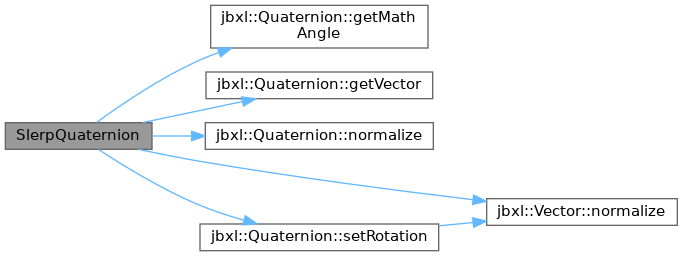
◆ TGAImage2MSGraph()
template <typename T> MSGraph<T> TGAImage2MSGraph(TGAImage tga)
TGAイメージデータを MSGraph型イメージデータに変換する
- Parameters
-
tga TGAイメージデータ
- Returns
- MSGraphイメージデータ
- Return values
-
JBXL_GRAPH_NODATA_ERROR state データ無し JBXL_GRAPH_MEMORY_ERROR state メモリ確保エラー
Definition at line 82 of file TgaTool.h.
References TGAImage::col, MSGraph< T >::color, MSGraph< T >::free(), MSGraph< T >::gp, GRAPH_COLOR_BGR, GRAPH_COLOR_BGRA, GRAPH_COLOR_GRAY, GRAPH_COLOR_MA, TGAImage::hd, MSGraph< T >::isNull(), TGAImage::isNull(), JBXL_GRAPH_IVDARG_ERROR, JBXL_GRAPH_NODATA_ERROR, TGAImage::point(), MSGraph< T >::set(), MSGraph< T >::state, TGAImage::xs, and TGAImage::ys.
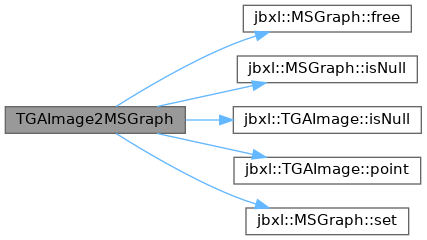
◆ ToPola()
| void ToPola | ( | Vector< T > | nv, |
| double & | cst, | ||
| double & | snt, | ||
| double & | csf, | ||
| double & | snf, | ||
| double | pcsf = 0.0, | ||
| double | psnf = 1.0 ) |
template <typename T> void ToPola(Vector<T> nv, double& cst, double& snt, double& csf, double& snf, double pcsf=0.0, double psnf=1.0)
ベクトル nvの単位ベクトルを極座標 (1,θ,φ) へ変換する.
ただし,θφは sin, cosの値として返される..ベクトル nvのノルムは計算されている必要がある.
- Parameters
-
[in] nv 方向ベクトル. [out] cst 指定しない.cosθの値が入る. [out] snt 指定しない.sinθの値が入る. [out] csf 通常は cosφの値が入る.sinθ≒0 の場合は pcsfの値が代入される. [out] snf 通常は sinφの値が入る.sinθ≒0 の場合は psnfの値が代入される. [in] pcsf sinθ≒0 の場合に csfに代入される.連続計算の場合に直前の cosφの値を指定する. [in] psnf sinθ≒0 の場合に snfに代入される.連続計算の場合に直前の sinφの値を指定する.
Definition at line 674 of file Graph.h.
References Vector< T >::n, Vector< T >::normalize(), Sign, Sin_Tolerance, Vector< T >::x, Vector< T >::y, and Vector< T >::z.
Referenced by Local2World().


◆ TVectorMultiTolerance()
Definition at line 183 of file TVector.h.
References Vector< T >::n, and TVector< T >::t.
Referenced by CollisionTriContour2D(), CollisionTriContour3D(), and SamePlaneContour().

◆ V2VQuaternion()
| Quaternion< T > V2VQuaternion | ( | Vector< T > | a, |
| Vector< T > | b ) |
Definition at line 1275 of file Rotation.h.
References Quaternion< T >::c, Vector< T >::c, Min, Quaternion< T >::n, Vector< T >::n, Vector< T >::norm(), Vector< T >::normalize(), PI, Quaternion< T >::s, Quaternion< T >::set(), Quaternion< T >::setRotation(), Vector< T >::x, Xabs, Vector< T >::y, Vector< T >::z, and Zero_Eps.

◆ Vector4Angle() [1/2]
Definition at line 914 of file Vector.h.
References Vector4< T >::n, Vector4< T >::normalize(), PI, and Zero_Eps.
Referenced by Vector4Angle().


◆ Vector4Angle() [2/2]
Definition at line 928 of file Vector.h.
References Vector4Angle().

◆ Vector4Dist()
Definition at line 865 of file Vector.h.
References Vector4< T >::norm().

◆ VectorAngle() [1/2]
Definition at line 266 of file Vector.h.
References Vector< T >::n, Vector< T >::normalize(), PI, and Zero_Eps.
Referenced by VectorAngle().


◆ VectorAngle() [2/2]
Definition at line 280 of file Vector.h.
References VectorAngle().

◆ VectorDist()
Definition at line 219 of file Vector.h.
References Vector< T >::norm().

◆ VectorInvRotation() [1/2]
| T * VectorInvRotation | ( | T * | v, |
| Quaternion< T > | q ) |
Definition at line 1251 of file Rotation.h.
References Quaternion< T >::s, Quaternion< T >::x, Quaternion< T >::y, and Quaternion< T >::z.
◆ VectorInvRotation() [2/2]
| Vector< T > VectorInvRotation | ( | Vector< T > | v, |
| Quaternion< T > | q ) |
Definition at line 1207 of file Rotation.h.
References Quaternion< T >::s, Quaternion< T >::x, Vector< T >::x, Quaternion< T >::y, Vector< T >::y, Quaternion< T >::z, and Vector< T >::z.
Referenced by AffineTrans< T >::execInvRotation().

◆ VectorRotation() [1/2]
| T * VectorRotation | ( | T * | v, |
| Quaternion< T > | q ) |
Definition at line 1227 of file Rotation.h.
References Quaternion< T >::s, Quaternion< T >::x, Quaternion< T >::y, and Quaternion< T >::z.
◆ VectorRotation() [2/2]
| Vector< T > VectorRotation | ( | Vector< T > | v, |
| Quaternion< T > | q ) |
ベクトル回転の高速計算
Definition at line 1187 of file Rotation.h.
References Quaternion< T >::s, Quaternion< T >::x, Vector< T >::x, Quaternion< T >::y, Vector< T >::y, Quaternion< T >::z, and Vector< T >::z.
Referenced by TriPolygonData::execRotate(), ContourBaseData::execRotate(), and AffineTrans< T >::execRotation().

◆ Vertex2TVector()
| DllExport TVector< double > Vertex2TVector | ( | BREP_VERTEX * | v | ) |
Definition at line 1036 of file Brep.cpp.
References Vector< T >::n, BREP_VERTEX::point, TVector< T >::t, BREP_VERTEX::tolerance, Vector< T >::x, Vector< T >::y, and Vector< T >::z.
Referenced by CollisionTriContour2D(), CollisionTriContour3D(), BREP_CONTOUR::ComputeDirectRS(), IsAtLine(), IsInTriangle(), and SamePlaneContour().

◆ vNabla()
template <typename R, typename T> MSGraph<Vector<R> > vNabla(MSGraph<T> vp)
グラフィックデータの ナブラを計算する(Sobel).
- Parameters
-
vp 計算対象となるグラフィックデータ構造体.
- Returns
- ナブラ.ベクトル型グラフィックデータ.
Definition at line 641 of file Gmt.h.
References MSGraph< T >::base, DEBUG_MODE, MSGraph< T >::free(), MSGraph< T >::gp, MSGraph< T >::isNull(), JBXL_GRAPH_MEMORY_ERROR, PRINT_MESG, MSGraph< T >::rbound, MSGraph< T >::RZxy, MSGraph< T >::state, MSGraph< T >::xs, MSGraph< T >::ys, MSGraph< T >::zero, and MSGraph< T >::zs.

◆ VPPQuaternion()
| Quaternion< T > VPPQuaternion | ( | Vector< T > | a, |
| Vector< T > | b, | ||
| Vector< T > | c ) |
Definition at line 1331 of file Rotation.h.
References Vector< T >::c.
◆ wCircle3D()
| void wCircle3D | ( | MSGraph< T > | vp, |
| Vector< double > | ox, | ||
| Vector< double > | ex, | ||
| double | rr, | ||
| int | cc, | ||
| int | mode ) |
Definition at line 167 of file Window.h.
References Max, MSGraph_Circle3D(), MSGraph< T >::wRateX, MSGraph< T >::wRateY, MSGraph< T >::wRateZ, MSGraph< T >::wZeroX, MSGraph< T >::wZeroY, MSGraph< T >::wZeroZ, Vector< T >::x, Vector< T >::y, and Vector< T >::z.

◆ wDraw()
| void wDraw | ( | MSGraph< T > * | vp, |
| double | x, | ||
| double | y, | ||
| int | cc ) |
template <typename T> void wDraw(MSGraph<T>* vp, double x, double y, int cc)
ワールド座標系で現地点から指定した地点へ線を引く.指定した地点が現地点となる.
- Parameters
-
vp 操作対象のグラフィックデータ. x 線の終点の x座標(ワールド座標系). y 線の終点の y座標(ワールド座標系). cc 線の輝度値.
Definition at line 195 of file Window.h.
References MSGraph< T >::wMove(), MSGraph< T >::wNowX, and MSGraph< T >::wNowY.

◆ wDraw3D()
| void wDraw3D | ( | MSGraph< T > * | vp, |
| double | x, | ||
| double | y, | ||
| double | z, | ||
| int | cc ) |
template <typename T> void wDraw3D(MSGraph<T>* vp, double x, double y, double z, int cc)
3次元のワールド座標系で現地点から指定した地点へ線を引く.指定した地点が現地点となる.
- Parameters
-
vp 操作対象のグラフィックデータ. x 線の終点の x座標(ワールド座標系). y 線の終点の y座標(ワールド座標系). z 線の終点の z座標(ワールド座標系). cc 線の輝度値.
Definition at line 213 of file Window.h.
References MSGraph< T >::wMove(), MSGraph< T >::wNowX, MSGraph< T >::wNowY, and MSGraph< T >::wNowZ.

◆ wDraw_rel()
| void wDraw_rel | ( | MSGraph< T > * | vp, |
| double | x, | ||
| double | y, | ||
| int | cc ) |
template <typename T> void wDraw_rel(MSGraph<T>* vp, double x, double y, int cc)
ワールド座標系で現地点を起点として相対的に線を引く.線の終点が現地点となる.
- Parameters
-
vp 操作対象のグラフィックデータ. x 現地点から x方向への移動距離(ワールド座標系). y 現地点から y方向への移動距離(ワールド座標系). cc 線の輝度値.
Definition at line 230 of file Window.h.
References MSGraph< T >::wMove(), MSGraph< T >::wNowX, and MSGraph< T >::wNowY.

◆ wDraw_rel3D()
| void wDraw_rel3D | ( | MSGraph< T > * | vp, |
| double | x, | ||
| double | y, | ||
| double | z, | ||
| int | cc ) |
template <typename T> void wDraw_rel3D(MSGraph<T>* vp, double x, double y, double z, int cc)
3次元のワールド座標系で現地点を起点として相対的に線を引く.線の終点が現地点となる.
- Parameters
-
vp 操作対象のグラフィックデータ. x 現地点から x方向への移動距離(ワールド座標系). y 現地点から y方向への移動距離(ワールド座標系). z 現地点から z方向への移動距離(ワールド座標系). cc 線の輝度値.
Definition at line 251 of file Window.h.
References MSGraph< T >::wMove(), MSGraph< T >::wNowX, MSGraph< T >::wNowY, and MSGraph< T >::wNowZ.

◆ wGetPixel()
| T wGetPixel | ( | MSGraph< T > | vp, |
| double | x, | ||
| double | y ) |
template <typename T> T wGetPixel(MSGraph<T> vp, double x, double y)
ワールド座標系の点のデータを得る.
- Parameters
-
vp 操作対象のグラフィックデータ. x 点の x座標(ワールド座標系). y 点の y座標(ワールド座標系).
Definition at line 82 of file Window.h.
References MSGraph< T >::point(), MSGraph< T >::wRateX, MSGraph< T >::wRateY, MSGraph< T >::wZeroX, MSGraph< T >::wZeroY, MSGraph< T >::ys, and MSGraph< T >::zero.

◆ wGetPixel3D()
| T wGetPixel3D | ( | MSGraph< T > | vp, |
| double | x, | ||
| double | y, | ||
| double | z ) |
template <typename T> T wGetPixel3D(MSGraph<T> vp, double x, double y, double z)
3次元のワールド座標系の点のデータを得る.
- Parameters
-
vp 操作対象のグラフィックデータ. x 点の x座標(ワールド座標系). y 点の y座標(ワールド座標系). z 点の z座標(ワールド座標系).
Definition at line 102 of file Window.h.
References MSGraph< T >::point(), MSGraph< T >::wRateX, MSGraph< T >::wRateY, MSGraph< T >::wRateZ, MSGraph< T >::wZeroX, MSGraph< T >::wZeroY, MSGraph< T >::wZeroZ, MSGraph< T >::zero, and MSGraph< T >::zs.

◆ wLine()
| void wLine | ( | MSGraph< T > | vp, |
| double | x1, | ||
| double | y1, | ||
| double | x2, | ||
| double | y2, | ||
| int | cc ) |
template <typename T> void wLine(MSGraph<T> vp, double x1, double y1, double x2, double y2, int cc)
ワールド座標系に線を引く.
- Parameters
-
vp 操作対象のグラフィックデータ. x1 線の始点の x座標(ワールド座標系). y1 線の始点の y座標(ワールド座標系). x2 線の終点の x座標(ワールド座標系). y2 線の終点の y座標(ワールド座標系). cc 線の輝度値.
Definition at line 125 of file Window.h.
References MSGraph< T >::wRateX, MSGraph< T >::wRateY, MSGraph< T >::wZeroX, and MSGraph< T >::wZeroY.
◆ wLine3D()
| void wLine3D | ( | MSGraph< T > | vp, |
| double | x1, | ||
| double | y1, | ||
| double | z1, | ||
| double | x2, | ||
| double | y2, | ||
| double | z2, | ||
| int | cc ) |
template <typename T> void wLine3D(MSGraph<T> vp, double x1, double y1, double z1, double x2, double y2, double z2, int cc)
3次元のワールド座標系に線を引く.
- Parameters
-
vp 操作対象のグラフィックデータ. x1 線の始点の x座標(ワールド座標系). y1 線の始点の y座標(ワールド座標系). z1 線の始点の z座標(ワールド座標系). x2 線の終点の x座標(ワールド座標系). y2 線の終点の y座標(ワールド座標系). z2 線の終点の z座標(ワールド座標系). cc 線の輝度値.
Definition at line 152 of file Window.h.
References MSGraph< T >::wRateX, MSGraph< T >::wRateY, MSGraph< T >::wRateZ, MSGraph< T >::wZeroX, MSGraph< T >::wZeroY, and MSGraph< T >::wZeroZ.
◆ writeCmnHeadData()
| int writeCmnHeadData | ( | FILE * | fp, |
| CmnHead * | hd, | ||
| bool | cnt = false ) |
int jbxl::writeCmnHeadData(File* fp, CmnHead* hd, bool cnt)
共通画像データをファイルとして保存する.
元の共通画像データのヘッダ種別が MOON_DATA または USERSET_DATAの場合は CT(MOON)形式で保存する.
RAS_DATA, JPEG_RGB_DATA, JPEG_MONO_DATA, TIFF_DATAの場合はそれぞれの形式で保存する.(TIFF_DATAは未サポート)
CT_DATA, CT_3DM, CT_3D_VOL 場合はそのまま共通形式(ヘッダ種別はそのまま)で保存する.
カウンタサポートあり.
サポートしているヘッダ種別は
CT_DATA, USERSET_DATA, CT_3DM, CT_3D_VOL, RAS_DATA, MOON_DATA, JPEG_RGB_DATA, JPEG_MONO_DATA
ヘッダに必要な情報は
hd->kind, xsize, ysize, zsize, depth, grptr, (buf) ( )は省略可.
- Parameters
-
fp 保存するファイルの識別子. hd 保存するデータを既述した共通ヘッダ. cnt 仮想カウンタを使用するか?
- Return values
-
>0 書き込んだサイズ. JBXL_GRAPH_HEADER_ERROR ヘッダエラー JBXL_GRAPH_MEMORY_ERROR メモリエラー JBXL_GRAPH_CANCEL キャンセル
Definition at line 1666 of file Gio.cpp.
References CTHead::anydata, CmnHead::bsize, CmnHead::buf, CT_3D_VOL, CT_3DM, CT_DATA, CTHead::ctmax, CTHead::ctmin, CTHead::cutdown, CTHead::cutleft, CTHead::cutright, CTHead::cutup, DEBUG_MODE, CmnHead::depth, CmnHead::entry, GetUsableGlobalCounter(), CmnHead::grptr, hton_ar, hton_st, CVCounter::isCanceled(), JBXL_GRAPH_CANCEL, JBXL_GRAPH_HEADER_ERROR, JBXL_GRAPH_MEMORY_ERROR, JPEG16_ARGB_DATA, JPEG16_RGB_DATA, JPEG16_RGBA_DATA, JPEG_ARGB_DATA, JPEG_MONO_DATA, JPEG_RGB_DATA, JPEG_RGBA_DATA, CmnHead::kind, CmnHead::lsize, MOON_DATA, PRINT_MESG, CVCounter::PutFill(), RAS_DATA, CVCounter::SetMax(), CVCounter::SetPos(), CVCounter::StepIt(), TempBase, UN_KNOWN_DATA, USERSET_DATA, writeRasData(), CTHead::xsize, CmnHead::xsize, CTHead::ysize, CmnHead::ysize, and CmnHead::zsize.
Referenced by writeCmnHeadFile().
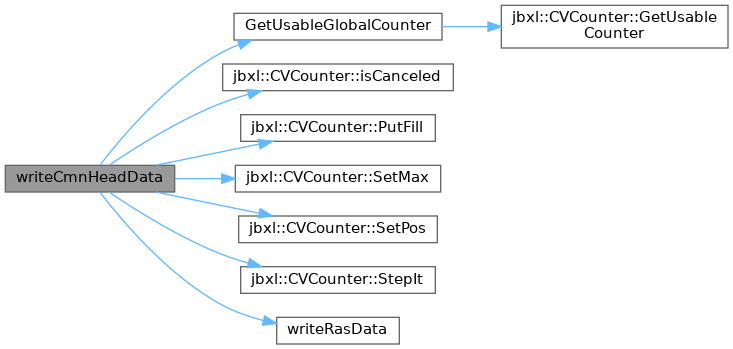

◆ writeCmnHeadFile()
| int writeCmnHeadFile | ( | const char * | fn, |
| CmnHead * | hd, | ||
| bool | cnt = false ) |
int jbxl::writeCmnHeadFile(const char* fn, CmnHead* hd, bool cnt)
共通画像データをCTファイルとして保存する.
元の共通画像データのヘッダ種別が MOON_DATA または USERSET_DATAの場合は CT(MOON)形式で保存する.
RAS_DATA, JPEG_RGB_DATA, JPEG_MONO_DATA, TIFF_DATAの場合はそれぞれの形式で保存する.(TIFF_DATAは未サポート)
CT_DATA, CT_3DM, CT_3D_VOL 場合はそのまま共通形式 (ヘッダはそのまま)で保存する.
サポートしているヘッダ種別は
CT_DATA, USERSET_DATA, CT_3DM, CT_3D_VOL, RAS_DATA, MOON_DATA, JPEG_RGB_DATA, JPEG_MONO_DATA, JPEG16_XXX_DATA
ヘッダに必要な情報は hd->kind, xsize, ysize, zsize, depth, grptr, (buf) ( )は省略可.
- Parameters
-
fn 保存するファイル名. hd 保存するデータを既述した共通ヘッダ. cnt 仮想カウンタを使用するか?
- Return values
-
>0 書き込んだサイズ. JBXL_GRAPH_IVDARG_ERROR 引数不正. JBXL_GRAPH_MEMORY_ERROR メモリエラー. JBXL_GRAPH_OPFILE_ERROR ファイルオープンエラー. JBXL_GRAPH_WRFILE_ERROR 書き込みファイルサイズ不一致 JBXL_GRAPH_RDFILE_ERROR 書き込みファイルの再読み取り不可 JBXL_GRAPH_HEADER_ERROR 書き込みファイルのヘッダ異常
Definition at line 1576 of file Gio.cpp.
References CmnHead::bsize, DEBUG_MODE, CmnHead::depth, CmnHead::entry, file_size(), JBXL_FILE_READ_ERROR, JBXL_GRAPH_HEADER_ERROR, JBXL_GRAPH_IVDARG_ERROR, JBXL_GRAPH_OPFILE_ERROR, JBXL_GRAPH_RDFILE_ERROR, JBXL_GRAPH_WRFILE_ERROR, JPEG16_ARGB_DATA, JPEG16_RGB_DATA, JPEG16_RGBA_DATA, JPEG_ARGB_DATA, JPEG_MONO_DATA, JPEG_RGB_DATA, JPEG_RGBA_DATA, CmnHead::kind, CmnHead::lsize, MOON_DATA, ntoh_st, PRINT_MESG, RAS_DATA, UN_KNOWN_DATA, writeCmnHeadData(), CmnHead::xsize, CmnHead::ysize, and CmnHead::zsize.
Referenced by writeGraphicFile().
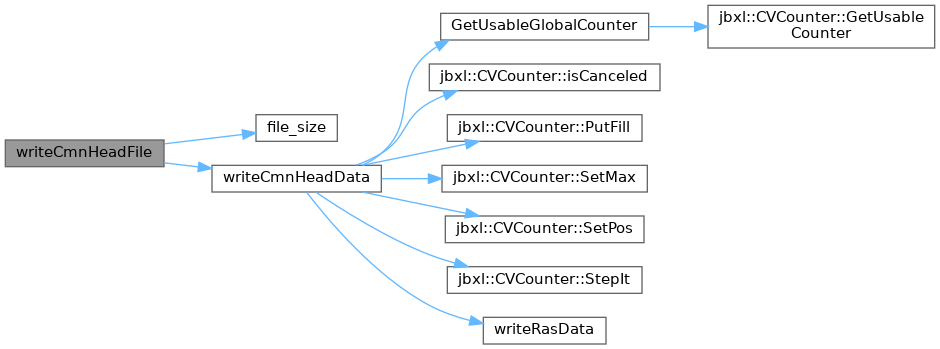

◆ writeGraphicFile()
| int writeGraphicFile | ( | const char * | fname, |
| MSGraph< T > | vp, | ||
| int | kind = 0, | ||
| int | mlt = FALSE, | ||
| int | fnum = 0, | ||
| int | tnum = 0, | ||
| bool | cnt = false ) |
template <typename T> int writeGraphicFile(const char *fname, MSGraph<T> vp, int kind=0, int mlt=FALSE, int fnum=0, int tnum=0, bool cnt=false)
グラフィックデータvpをファイルとして書き出す.
kind でファイルの種別を指定可能.ただし kind==0 の場合は
- vp.zs<=1 なら CT_DATAとして保存される.
- vp.zs >1 なら CT_3DM として保存される.
サポートするデータ形式
CT_DATA, CT_3DM, MOON_DATA, RAS_DATA, JPEG_RGB_DATA, JPEG_MONO_DATA
RZxy!=1.0 ならヘッダにその情報が埋め込まれる.
fnum, tnum を指定するとグラフィックデータの一部を保存できる.
- Parameters
-
fname 保存する際のファイル名. vp 保存するグラフィックデータ. kind データ形式 + 属性ビット mlt 3Dデータとして保存しない fnum 保存するデータの始まりの Z座標.デフォルトは 0 tnum 保存するデータの終わりの Z座標.デフォルトは vp.zs-1 cnt カウンタ(プログレスバー)を表示するか?
- Return values
-
1以上 正常終了. JBXL_GRAPH_OPFILE_ERROR ファイルオープンエラー. JBXL_GRAPH_MEMORY_ERROR メモリエラー. JBXL_GRAPH_WRFILE_ERROR 書き込みファイルサイズ不一致 JBXL_GRAPH_RDFILE_ERROR 書き込みファイルの再読み取り不可 JBXL_GRAPH_HEADER_ERROR 書き込みファイルのヘッダ異常 JBXL_GRAPH_CANCEL キャンセル
Definition at line 455 of file Gio.h.
References CTHead::anydata, MSGraph< T >::base, CmnHead::bsize, CmnHead::buf, MSGraph< T >::color, CT_3DM, CT_DATA, CTHead::ctmax, CTHead::ctmin, CTHead::cutdown, CTHead::cutleft, CTHead::cutright, CTHead::cutup, CmnHead::depth, GetUsableGlobalCounter(), MSGraph< T >::gp, GRAPH_COLOR_ARGB, GRAPH_COLOR_ARGB16, GRAPH_COLOR_RGB16, GRAPH_COLOR_RGBA, GRAPH_COLOR_RGBA16, CmnHead::grptr, HAS_BASE, HAS_RBOUND, HAS_RZXY, CVCounter::isCanceled(), JBXL_GRAPH_CANCEL, JBXL_GRAPH_OPFILE_ERROR, JPEG16_ARGB_DATA, JPEG16_RGB_DATA, JPEG16_RGBA_DATA, JPEG_ARGB_DATA, JPEG_RGB_DATA, JPEG_RGBA_DATA, CmnHead::kind, LNAME, CmnHead::lsize, CVCounter::PutFill(), MSGraph< T >::rbound, MSGraph< T >::RZxy, RZXY_RATE, CVCounter::SetMax(), CVCounter::SetPos(), snprintf, CVCounter::StepIt(), TempBase, writeCmnHeadFile(), RBound< T >::xmax, RBound< T >::xmin, MSGraph< T >::xs, CTHead::xsize, CmnHead::xsize, RBound< T >::ymax, RBound< T >::ymin, MSGraph< T >::ys, CTHead::ysize, CmnHead::ysize, RBound< T >::zmax, RBound< T >::zmin, MSGraph< T >::zs, and CmnHead::zsize.
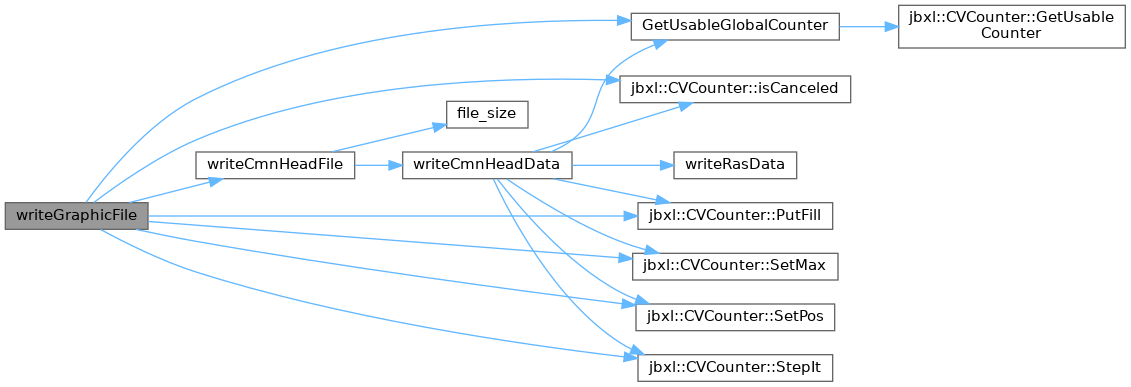
◆ writeRasData()
| int writeRasData | ( | FILE * | fp, |
| CmnHead * | hd, | ||
| int | obit = 8 ) |
int jbxl::writeRasData(FILE* fp, CmnHead* hd, int obit)
色々な画像データをSUN RASTER型式でファイルに保存する.
- Parameters
-
fp 保存するファイルポインタ. hd 保存するデータを既述した共通ヘッダ. obit SUN RASTERの 1ピクセルのビット数(8, 24をサポート).
- Return values
-
>0 書き込んだバイト数. JBXL_GRAPH_MEMORY_ERROR メモリエラー.
Definition at line 121 of file Gio.cpp.
References CmnHead::bsize, CmnHead::buf, CmnHead::depth, CmnHead::grptr, hton_st, JBXL_GRAPH_MEMORY_ERROR, CmnHead::kind, CmnHead::lsize, Max, RAS_DATA, RasHead::ras_depth, RasHead::ras_height, RasHead::ras_length, RasHead::ras_magic, RAS_MAGIC, RasHead::ras_maplength, RasHead::ras_maptype, RasHead::ras_type, RasHead::ras_width, RMT_NONE, RT_STANDARD, Xabs, CmnHead::xsize, and CmnHead::ysize.
Referenced by writeCmnHeadData(), and writeRasFile().

◆ writeRasFile()
| int writeRasFile | ( | const char * | fname, |
| MSGraph< T > | vp ) |
template <typename T> int writeRasFile(const char *fname, MSGraph<T> vp)
Definition at line 565 of file Gio.h.
References copyMSGraph2CmnHead(), JBXL_GRAPH_IVDARG_ERROR, JBXL_GRAPH_OPFILE_ERROR, JBXL_NORMAL, and writeRasData().

◆ writeSTLFile() [1/2]
| DllExport int writeSTLFile | ( | char * | fname, |
| BREP_SOLID * | solid, | ||
| bool | ascii = false ) |
int jbxl::writeSTLFile (char* fname, BREP_SOLID* solid, bool ascii)
STLファイルを書き込むラッパー関数.
アスキー,バイナリを指定する.デフォルトはバイナリ(ascii==false). 書き込んだファセットの数を返す.
Definition at line 74 of file STL.cpp.
References DEBUG_MODE, PRINT_MESG, writeSTLFileA(), and writeSTLFileB().

◆ writeSTLFile() [2/2]
| DllExport int writeSTLFile | ( | char * | fname, |
| BREP_SOLID_LIST | solid_list, | ||
| bool | ascii = false ) |
DllExport int jbxl::writeSTLFile (char* fname, BREP_SOLID_LIST solid_list, bool ascii)
STLファイルを書き込むラッパー関数.
アスキー,バイナリを指定する.デフォルトはバイナリ(ascii==false). 書き込んだファセットの数を返す.
Definition at line 94 of file STL.cpp.
References DEBUG_MODE, PRINT_MESG, writeSTLFileA(), and writeSTLFileB().

◆ writeSTLFileA() [1/2]
| DllExport int writeSTLFileA | ( | char * | fname, |
| BREP_SOLID * | solid ) |
int jbxl::writeSTLFileA(char* fname, BREP_SOLID* solid)
BREP_SOLID のデータをアスキー形式の STLファイルとして書き込む
Definition at line 233 of file STL.cpp.
References BREP_SOLID::contours, BREP_WING::next, BREP_VERTEX::point, PRINT_MESG, BREP_WING::vertex, Vector< T >::x, Vector< T >::y, and Vector< T >::z.
Referenced by BrepSolidList::outputFile(), writeSTLFile(), and writeSTLFile().
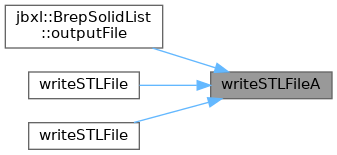
◆ writeSTLFileA() [2/2]
| DllExport int writeSTLFileA | ( | char * | fname, |
| BREP_SOLID_LIST | solid_list ) |
DllExport int jbxl::writeSTLFileA(char* fname, BREP_SOLID_LIST solid_list)
BREP_SOLID のデータをアスキー形式の STLファイルとして書き込む
Definition at line 317 of file STL.cpp.
References BREP_WING::next, BREP_VERTEX::point, PRINT_MESG, BREP_WING::vertex, Vector< T >::x, Vector< T >::y, and Vector< T >::z.
◆ writeSTLFileB() [1/2]
| DllExport int writeSTLFileB | ( | char * | fname, |
| BREP_SOLID * | solid ) |
int jbxl::writeSTLFileB(char* fname, BREP_SOLID* solid)
BREP_SOLID のデータをバイナリ形式の STLファイルとして書き込む
Definition at line 273 of file STL.cpp.
References BREP_SOLID::contours, BREP_WING::next, BREP_VERTEX::point, PRINT_MESG, STLData::vect, BREP_WING::vertex, Vector< T >::x, Vector< T >::y, and Vector< T >::z.
Referenced by BrepSolidList::outputFile(), writeSTLFile(), and writeSTLFile().
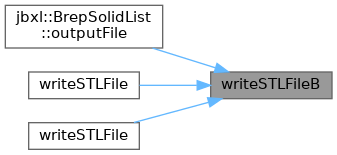
◆ writeSTLFileB() [2/2]
| DllExport int writeSTLFileB | ( | char * | fname, |
| BREP_SOLID_LIST | solid_list ) |
DllExport int jbxl::writeSTLFileB(char* fname, BREP_SOLID_LIST solidi_list)
BREP_SOLID のデータをバイナリ形式の STLファイルとして書き込む
Definition at line 361 of file STL.cpp.
References BREP_WING::next, BREP_VERTEX::point, PRINT_MESG, STLData::vect, BREP_WING::vertex, Vector< T >::x, Vector< T >::y, and Vector< T >::z.
◆ writeTGAData()
| int writeTGAData | ( | FILE * | fp, |
| TGAImage * | tga ) |
int jbxl::writeTGAData(FILE* fp, TGAImage* tga)
tga の画像データを fpに書き出す.
- Parameters
-
fp ファイル記述子 tga 保存する TGAデータ
- Return values
-
0 正常終了 JBXL_GRAPH_OPFILE_ERROR ファイルオープンエラー JBXL_GRAPH_HEADER_ERROR 不正ファイル(TGAファイルでない?) JBXL_GRAPH_MEMORY_ERROR メモリエラー JBXL_GRAPH_NODATA_ERROR tga にデータが無い JBXL_GRAPH_IVDCOLOR_ERROR サポート外のチャンネル数 JBXL_GRAPH_IVDFMT_ERROR サポート外のデータ形式
Definition at line 365 of file TgaTool.cpp.
References TGAImage::col, TGAImage::ft, TGAImage::gp, TGAImage::hd, JBXL_GRAPH_IVDCOLOR_ERROR, JBXL_GRAPH_NODATA_ERROR, JBXL_GRAPH_OPFILE_ERROR, TGAImage::length, TGA_FOOTER_SIZE, and TGA_HEADER_SIZE.
Referenced by writeTGAFile().

◆ writeTGAFile()
| int writeTGAFile | ( | const char * | fname, |
| TGAImage * | tga ) |
int jbxl::writeTGAFile(const char* fname, TGAImage* tga)
tga の画像データを fnameに書き出す.
- Parameters
-
fname ファイル名 tga 保存する TGAデータ
- Return values
-
0 正常終了 JBXL_GRAPH_OPFILE_ERROR ファイルオープンエラー JBXL_GRAPH_HEADER_ERROR 不正ファイル(TGAファイルでない?) JBXL_GRAPH_MEMORY_ERROR メモリエラー JBXL_GRAPH_NODATA_ERROR tga にデータが無い JBXL_GRAPH_IVDARG_ERROR ファイル名が NULL JBXL_GRAPH_IVDCOLOR_ERROR サポート外のチャンネル数
Definition at line 328 of file TgaTool.cpp.
References TGAImage::col, TGAImage::gp, JBXL_GRAPH_IVDARG_ERROR, JBXL_GRAPH_IVDCOLOR_ERROR, JBXL_GRAPH_NODATA_ERROR, JBXL_GRAPH_OPFILE_ERROR, and writeTGAData().

◆ wSetPixel()
| void wSetPixel | ( | MSGraph< T > | vp, |
| double | x, | ||
| double | y, | ||
| int | cc ) |
template <typename T> void wSetPixel(MSGraph<T> vp, double x, double y, int cc)
ワールド座標系に点を打つ.
- Parameters
-
vp 操作対象のグラフィックデータ. x 点の x座標(ワールド座標系). y 点の y座標(ワールド座標系). cc 点の輝度値.
Definition at line 43 of file Window.h.
References MSGraph< T >::point(), MSGraph< T >::wRateX, MSGraph< T >::wRateY, MSGraph< T >::wZeroX, MSGraph< T >::wZeroY, and MSGraph< T >::ys.

◆ wSetPixel3D()
| void wSetPixel3D | ( | MSGraph< T > | vp, |
| double | x, | ||
| double | y, | ||
| double | z, | ||
| int | cc ) |
template <typename T> void wSetPixel3D(MSGraph<T> vp, double x, double y, double z, int cc)
3次元のワールド座標系に点を打つ.
- Parameters
-
vp 操作対象のグラフィックデータ. x 点の x座標(ワールド座標系). y 点の y座標(ワールド座標系). z 点の z座標(ワールド座標系). cc 点の輝度値.
Definition at line 63 of file Window.h.
References MSGraph< T >::point(), MSGraph< T >::wRateX, MSGraph< T >::wRateY, MSGraph< T >::wRateZ, MSGraph< T >::wZeroX, MSGraph< T >::wZeroY, MSGraph< T >::wZeroZ, and MSGraph< T >::zs.

◆ x_reverse_MSGraph()
template <typename T> MSGraph<T> x_reverse_MSGraph(MSGraph<T> vp, bool ecnt=false)
グラフィックデータの x軸を反転させる.
- Parameters
-
vp 操作対象となるグラフィックデータ構造体. ecnt 仮想カウンタを使用するか?
- Returns
- 反転したグラフィックデータ.
Definition at line 1978 of file Graph.h.
References MSGraph< T >::base, MSGraph< T >::color, GetUsableGlobalCounter(), MSGraph< T >::gp, MSGraph< T >::init(), CVCounter::isCanceled(), MSGraph< T >::isNull(), JBXL_GRAPH_CANCEL, MSGraph< T >::RZxy, MSGraph< T >::set(), CVCounter::SetMax(), MSGraph< T >::state, CVCounter::StepIt(), MSGraph< T >::xs, MSGraph< T >::ys, MSGraph< T >::zero, and MSGraph< T >::zs.
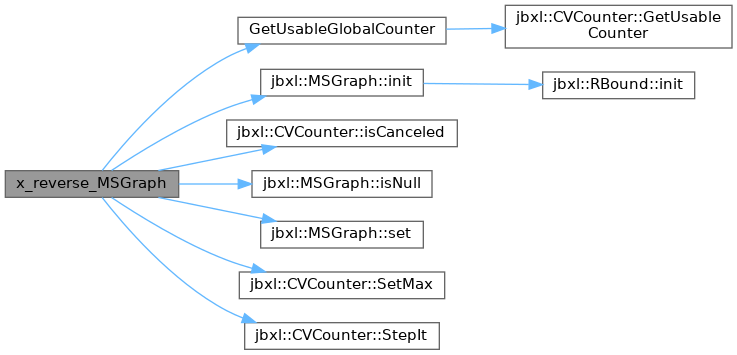
◆ xSobel()
template <typename R, typename T> MSGraph<R> xSobel(MSGraph<T> vp)
グラフィックデータの X方向微分(Sobel)を計算する.
- Parameters
-
vp 計算対象となるグラフィックデータ構造体.
- Returns
- 処理されたグラフィックデータ.
Definition at line 154 of file Gmt.h.
References MSGraph< T >::base, DEBUG_MODE, GetUsableGlobalCounter(), MSGraph< T >::gp, MSGraph< T >::isNull(), JBXL_GRAPH_MEMORY_ERROR, MSGraph< T >::mimicry(), PRINT_MESG, CVCounter::SetMax(), MSGraph< T >::state, CVCounter::StepIt(), MSGraph< T >::xs, MSGraph< T >::ys, MSGraph< T >::zero, and MSGraph< T >::zs.
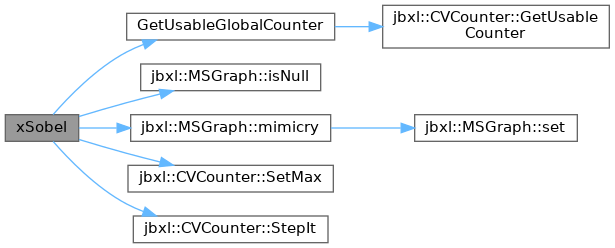
◆ xxSobel()
template<typename R, typename T> MSGraph<R> xxSobel(MSGraph<T> vp)
グラフィックデータの X方向の 2階微分(Sobel)を計算する.
- Parameters
-
vp 計算対象となるグラフィックデータ構造体.
- Returns
- 処理されたグラフィックデータ.
Definition at line 377 of file Gmt.h.
References MSGraph< T >::base, DEBUG_MODE, GetUsableGlobalCounter(), MSGraph< T >::gp, MSGraph< T >::isNull(), JBXL_GRAPH_MEMORY_ERROR, MSGraph< T >::mimicry(), PRINT_MESG, CVCounter::SetMax(), MSGraph< T >::state, CVCounter::StepIt(), MSGraph< T >::xs, MSGraph< T >::ys, MSGraph< T >::zero, and MSGraph< T >::zs.

◆ ySobel()
template<typename R, typename T> MSGraph<R> ySobel(MSGraph<T> vp)
グラフィックデータの Y方向微分(Sobel)を計算する.
- Parameters
-
vp 計算対象となるグラフィックデータ構造体.
- Returns
- 処理されたグラフィックデータ.
Definition at line 219 of file Gmt.h.
References MSGraph< T >::base, DEBUG_MODE, GetUsableGlobalCounter(), MSGraph< T >::gp, MSGraph< T >::isNull(), JBXL_GRAPH_MEMORY_ERROR, MSGraph< T >::mimicry(), PRINT_MESG, CVCounter::SetMax(), MSGraph< T >::state, CVCounter::StepIt(), MSGraph< T >::xs, MSGraph< T >::ys, MSGraph< T >::zero, and MSGraph< T >::zs.
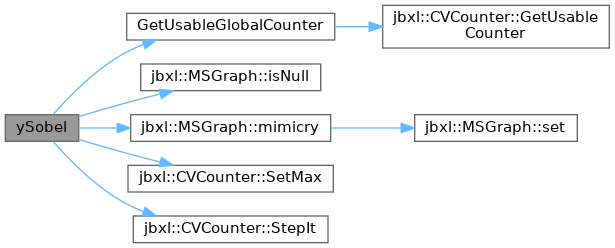
◆ yySobel()
template<typename R, typename T> MSGraph<R> yySobel(MSGraph<T> vp)
グラフィックデータの Y方向の 2階微分(Sobel)を計算する.
- Parameters
-
vp 計算対象となるグラフィックデータ構造体.
- Returns
- 処理されたグラフィックデータ.
Definition at line 470 of file Gmt.h.
References MSGraph< T >::base, DEBUG_MODE, GetUsableGlobalCounter(), MSGraph< T >::gp, MSGraph< T >::isNull(), JBXL_GRAPH_MEMORY_ERROR, MSGraph< T >::mimicry(), PRINT_MESG, CVCounter::SetMax(), MSGraph< T >::state, CVCounter::StepIt(), MSGraph< T >::xs, MSGraph< T >::ys, MSGraph< T >::zero, and MSGraph< T >::zs.
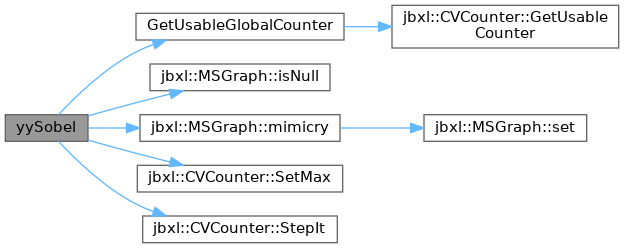
◆ zoom_MSGraph()
template <typename T> MSGraph<T> zoom_MSGraph(MSGraph<T> vp, double zm, int mode=ON)
2Dグラフィックデータ拡大する.
- Parameters
-
vp – 変換する Vector型単純グラフィックデータ. zm – 倍率. mode – モード.ON: 線形補間.その他: 単純拡大
- Returns
- 拡大したグラフィックデータ.
Definition at line 1733 of file Graph.h.
References MSGraph< T >::color, MSGraph< T >::gp, MSGraph< T >::init(), MSGraph< T >::isNull(), JBXL_GRAPH_IVDARG_ERROR, JBXL_GRAPH_NODATA_ERROR, ON, MSGraph< T >::point(), MSGraph< T >::set(), MSGraph< T >::state, MSGraph< T >::xs, MSGraph< T >::ys, and MSGraph< T >::zs.
Referenced by count_around_MSGraph().


◆ zSobel()
template<typename R, typename T> MSGraph<R> zSobel(MSGraph<T> vp)
グラフィックデータの Z方向微分(Sobel)を計算する.
- Parameters
-
vp 計算対象となるグラフィックデータ構造体.
- Returns
- 処理されたグラフィックデータ.
Definition at line 284 of file Gmt.h.
References MSGraph< T >::base, DEBUG_MODE, GetUsableGlobalCounter(), MSGraph< T >::gp, MSGraph< T >::isNull(), JBXL_GRAPH_MEMORY_ERROR, JBXL_GRAPH_NODATA_ERROR, MSGraph< T >::mimicry(), PRINT_MESG, CVCounter::PutFill(), CVCounter::SetMax(), MSGraph< T >::state, CVCounter::StepIt(), MSGraph< T >::xs, MSGraph< T >::ys, MSGraph< T >::zero, and MSGraph< T >::zs.
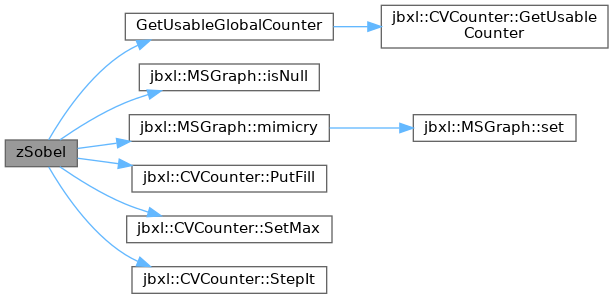
◆ zzSobel()
template<typename R, typename T> MSGraph<R> zzSobel(MSGraph<T> vp)
グラフィックデータの Z方向の 2階微分(Sobel)を計算する.
- Parameters
-
vp 計算対象となるグラフィックデータ構造体.
- Returns
- 処理されたグラフィックデータ.
Definition at line 564 of file Gmt.h.
References CVCounter::DeleteChildCounter(), MSGraph< T >::free(), GetUsableGlobalCounter(), MSGraph< T >::isNull(), JBXL_GRAPH_NODATA_ERROR, CVCounter::MakeChildCounter(), MSGraph< T >::mimicry(), CVCounter::PutFill(), SetGlobalCounter(), CVCounter::SetMax(), MSGraph< T >::state, and MSGraph< T >::zs.
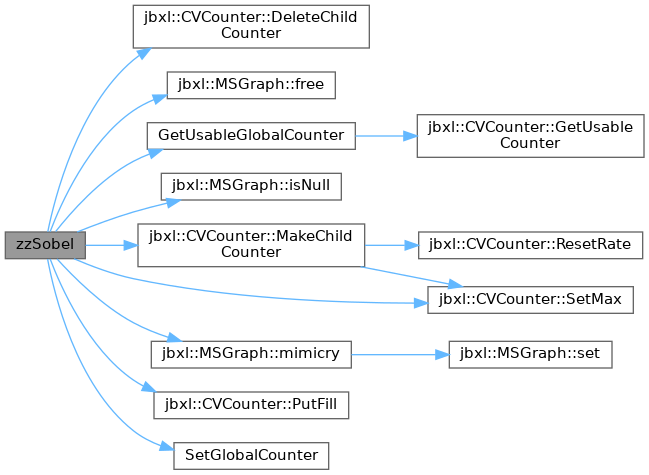
Variable Documentation
◆ Abs_Vector_Tolerance
|
extern |
Definition at line 20 of file Tolerance.cpp.
Referenced by SetAbsVectorTolerance().
◆ Abs_Vertex_Tolerance
|
extern |
Definition at line 21 of file Tolerance.cpp.
Referenced by BREP_VERTEX::BREP_VERTEX(), BREP_VERTEX::ComputeTolerance(), and SetAbsVertexTolerance().
◆ BREP_CONTOUR
| class DllExport BREP_CONTOUR |
Definition at line 35 of file Brep.h.
Referenced by CreateContour(), and CreateContourByVertex().
◆ BREP_EDGE
| class DllExport BREP_EDGE |
Definition at line 36 of file Brep.h.
Referenced by CreateEdge().
◆ BREP_FACET
| class DllExport BREP_FACET |
Definition at line 34 of file Brep.h.
Referenced by BrepSolidList::addSolid(), AddVector2TriSolid(), CreateTriSolidFromSTL(), CreateTriSolidFromVector(), BrepSolidList::getMerge(), PatchupContour(), and ReverseContours().
◆ BREP_SHELL
| class DllExport BREP_SHELL |
Definition at line 33 of file Brep.h.
Referenced by BrepSolidList::addSolid(), CreateTriSolidFromSTL(), CreateTriSolidFromVector(), and BrepSolidList::getMerge().
◆ BREP_SOLID
| class DllExport BREP_SOLID |
Definition at line 32 of file Brep.h.
Referenced by BrepSolidList::addSolid(), MeshFacetNode::computeVertexByBREP(), MeshFacetNode::computeVertexByBREP(), and BrepSolidList::getMerge().
◆ BREP_VERTEX
| class DllExport BREP_VERTEX |
Definition at line 38 of file Brep.h.
Referenced by CreateContourByVector().
◆ BREP_WING
| class DllExport BREP_WING |
Definition at line 37 of file Brep.h.
Referenced by BREP_EDGE::BREP_EDGE().
◆ Collision_Tolerance
|
extern |
Definition at line 22 of file Tolerance.cpp.
Referenced by CollisionTriContour2D(), CollisionTriContour3D(), IsInTriangle(), and SetCollisionTolerance().
◆ Edge_Tolerance
|
extern |
Definition at line 16 of file Tolerance.cpp.
Referenced by BREP_EDGE::BREP_EDGE(), and SetEdgeTolerance().
◆ Facet_Tolerance
|
extern |
Definition at line 17 of file Tolerance.cpp.
Referenced by BREP_FACET::BREP_FACET(), BREP_FACET::ComputePlaneEquation(), and SetFacetTolerance().
◆ GLCounter
|
extern |
Definition at line 22 of file ClassBox.cpp.
Referenced by ClearGlobalCounter(), GetUsableGlobalCounter(), and SetGlobalCounter().
◆ GLDisplay
|
extern |
Definition at line 16 of file ClassBox.cpp.
Referenced by ClearGlobalDisplay(), and SetGlobalDisplay().
◆ GLFrame
|
extern |
Definition at line 15 of file ClassBox.cpp.
Referenced by ClearGlobalFrame(), and SetGlobalFrame().
◆ GLTextDocument
|
extern |
Definition at line 17 of file ClassBox.cpp.
Referenced by ClearGlobalTextDocument(), and SetGlobalTextDocument().
◆ OctreeNode
| class DllExport OctreeNode |
Definition at line 39 of file Brep.h.
Referenced by OctreeNode::AddWithDuplicates(), OctreeNode::AddWithUnique(), and BREP_SOLID::BREP_SOLID().
◆ Quaternion
| class DllExport Quaternion |
Definition at line 22 of file Rotation.h.
◆ Sin_Tolerance
|
extern |
Definition at line 23 of file Tolerance.cpp.
Referenced by SetSINTolerance(), SlerpQuaternion(), and ToPola().
◆ TempBase
|
extern |
Definition at line 14 of file Gdata.cpp.
Referenced by writeCmnHeadData(), and writeGraphicFile().
◆ Vector_Tolerance
|
extern |
Definition at line 14 of file Tolerance.cpp.
Referenced by same_vector(), same_vector(), and SetVectorTolerance().
◆ Vertex_Tolerance
|
extern |
Definition at line 15 of file Tolerance.cpp.
Referenced by BREP_VERTEX::ComputeTolerance(), and SetVertexTolerance().
◆ Zero_Eps
|
extern |
Definition at line 26 of file Tolerance.cpp.
Referenced by CollisionTriContour2D(), CollisionTriContour3D(), IsAtLine(), Quaternion< T >::normalize(), Vector< T >::normalize(), Vector4< T >::normalize(), ProportionVector(), RotMatrixElements2ExtEulerXYZ(), RotMatrixElements2ExtEulerXZY(), RotMatrixElements2ExtEulerYXZ(), RotMatrixElements2ExtEulerYZX(), RotMatrixElements2ExtEulerZXY(), RotMatrixElements2ExtEulerZYX(), SamePlaneContour(), SetZeroEPS(), V2VQuaternion(), Vector4Angle(), and VectorAngle().
◆ Zero_Eps2
Definition at line 27 of file Tolerance.cpp.
◆ ZeroBase
|
extern |
Definition at line 13 of file Gdata.cpp.
Referenced by readGraphicFile(), and readGraphicSlices().